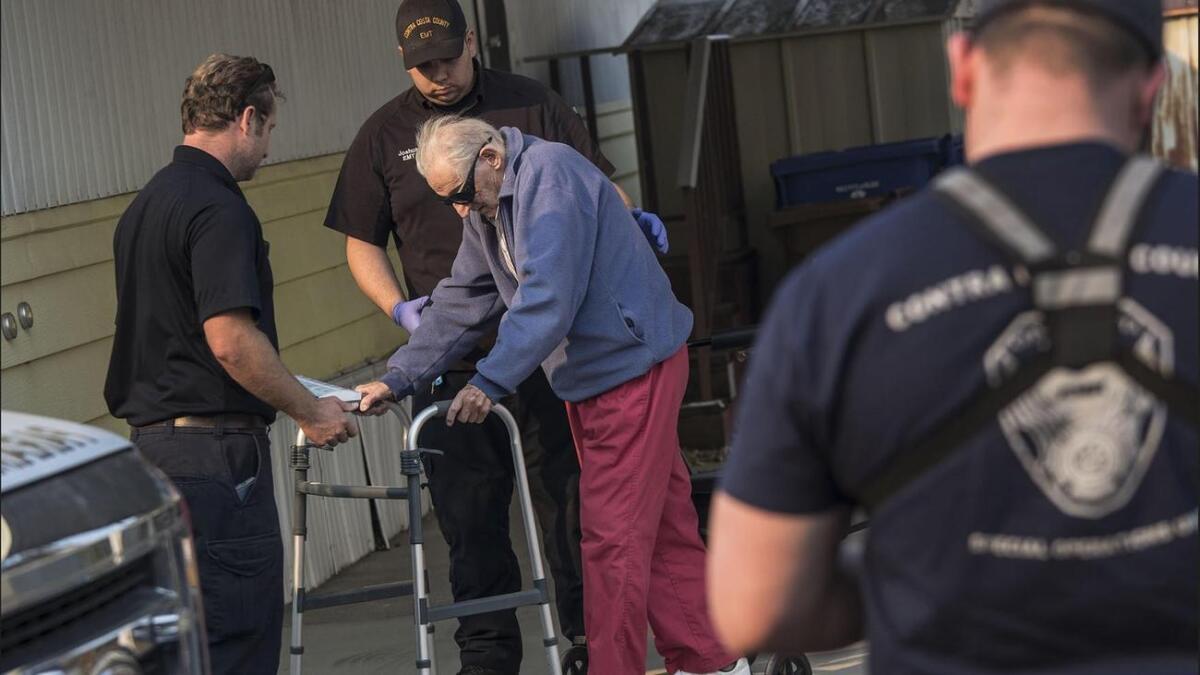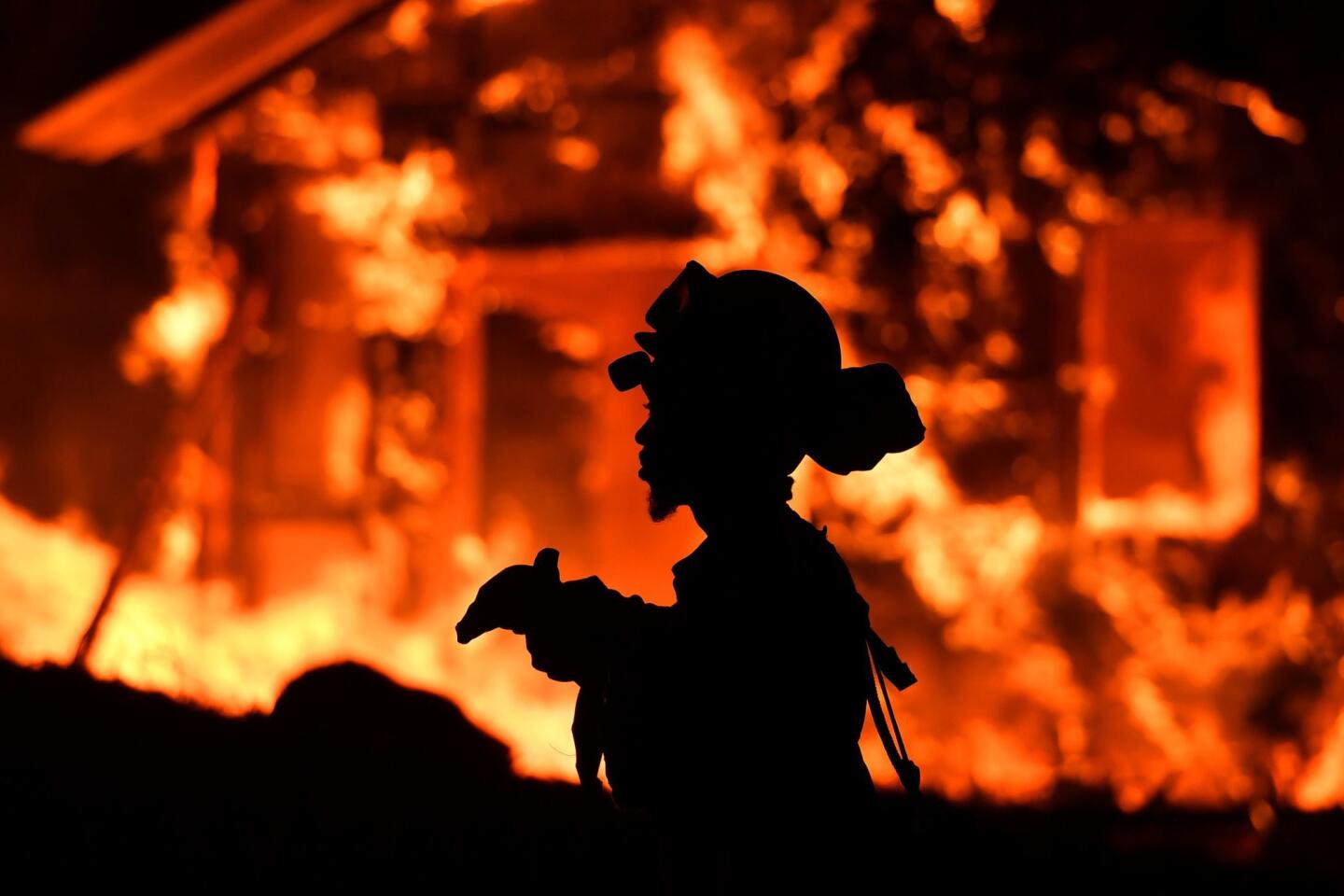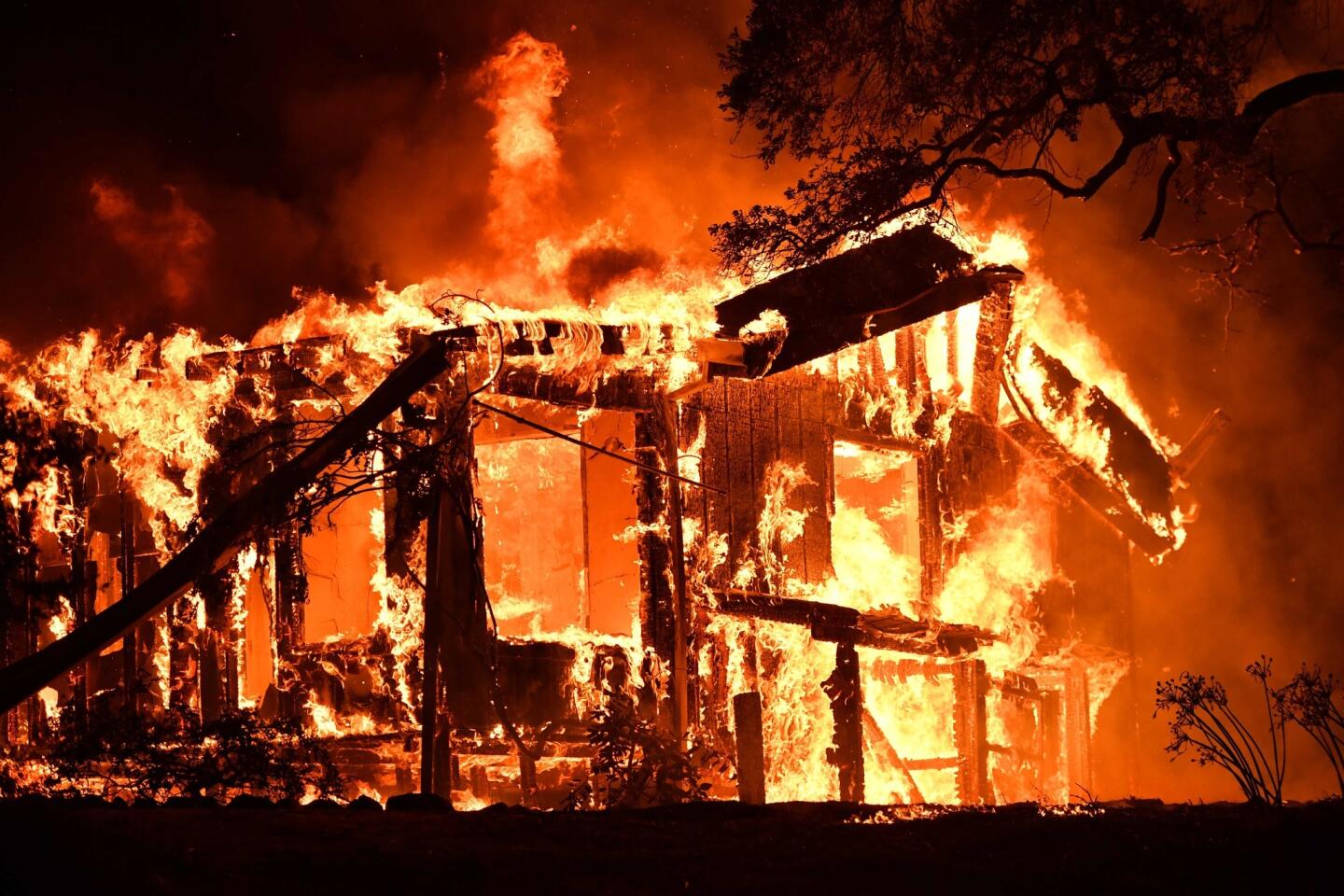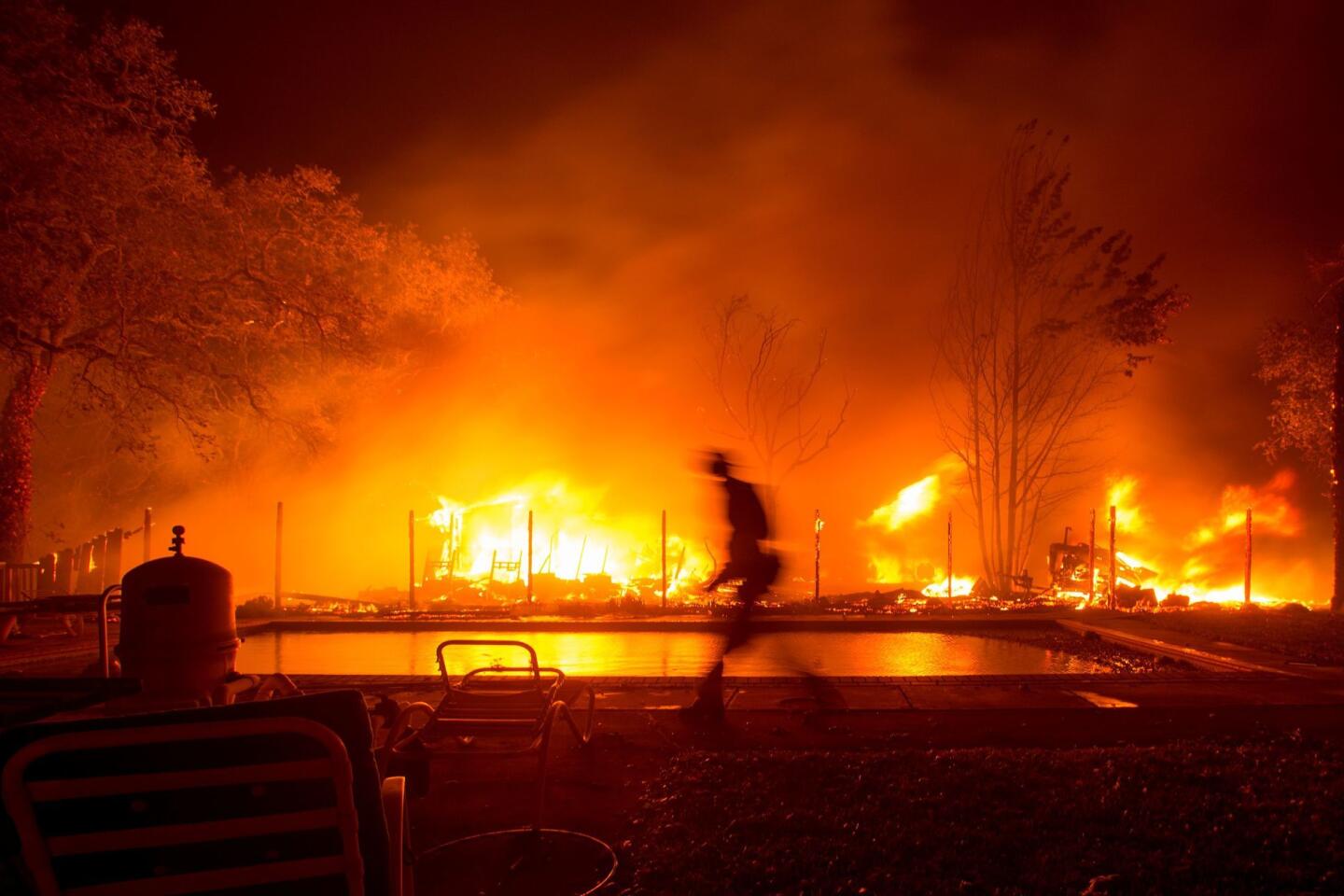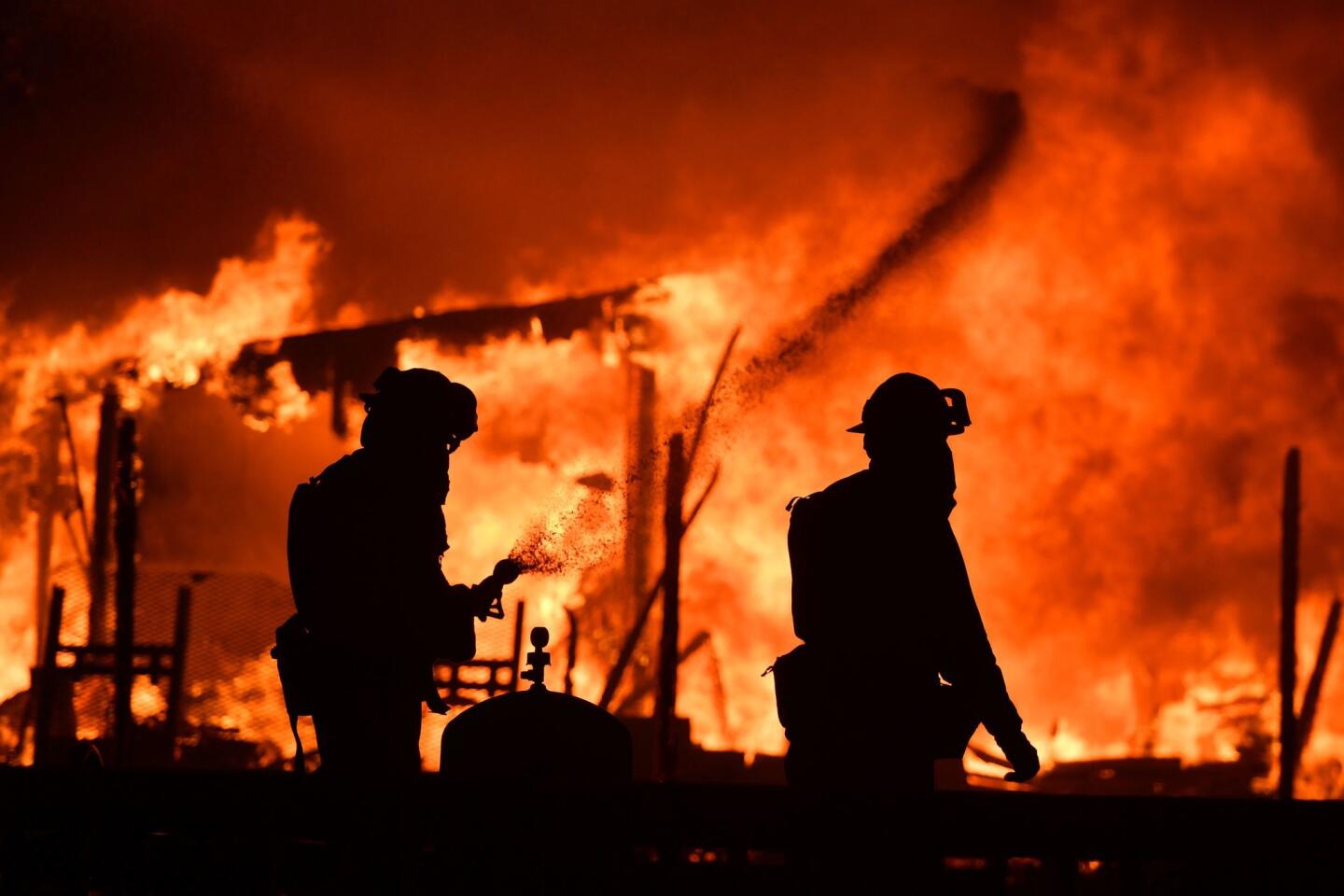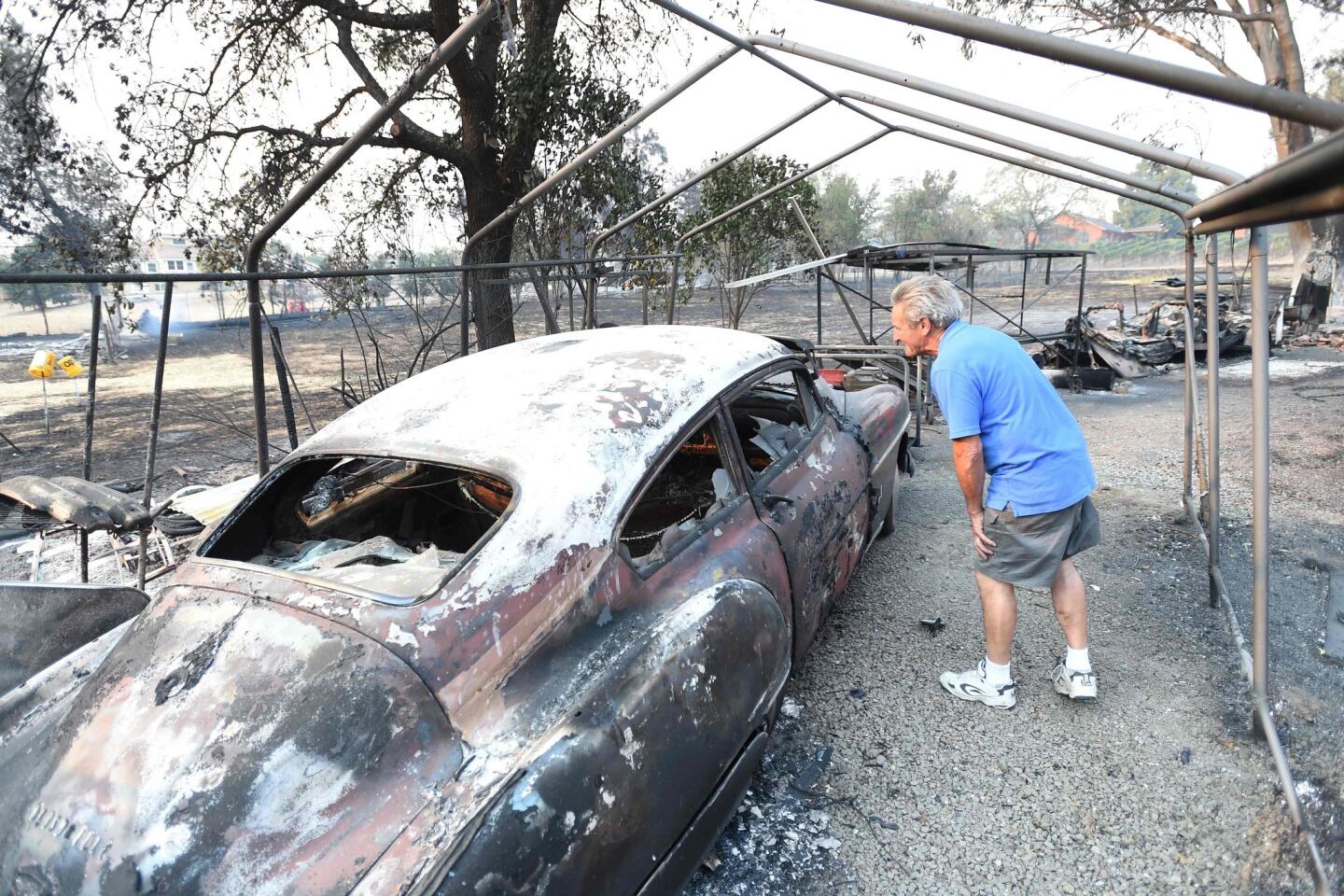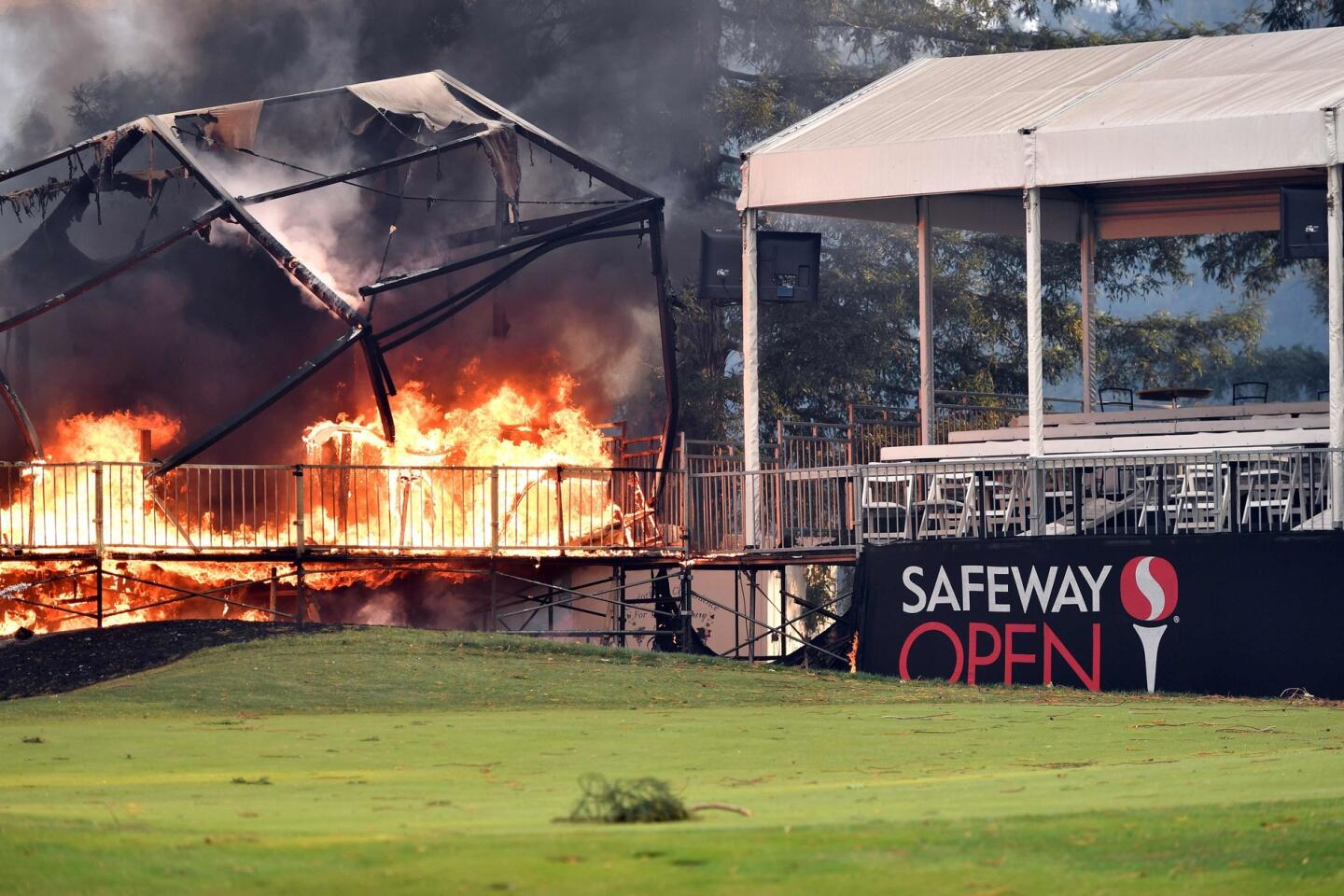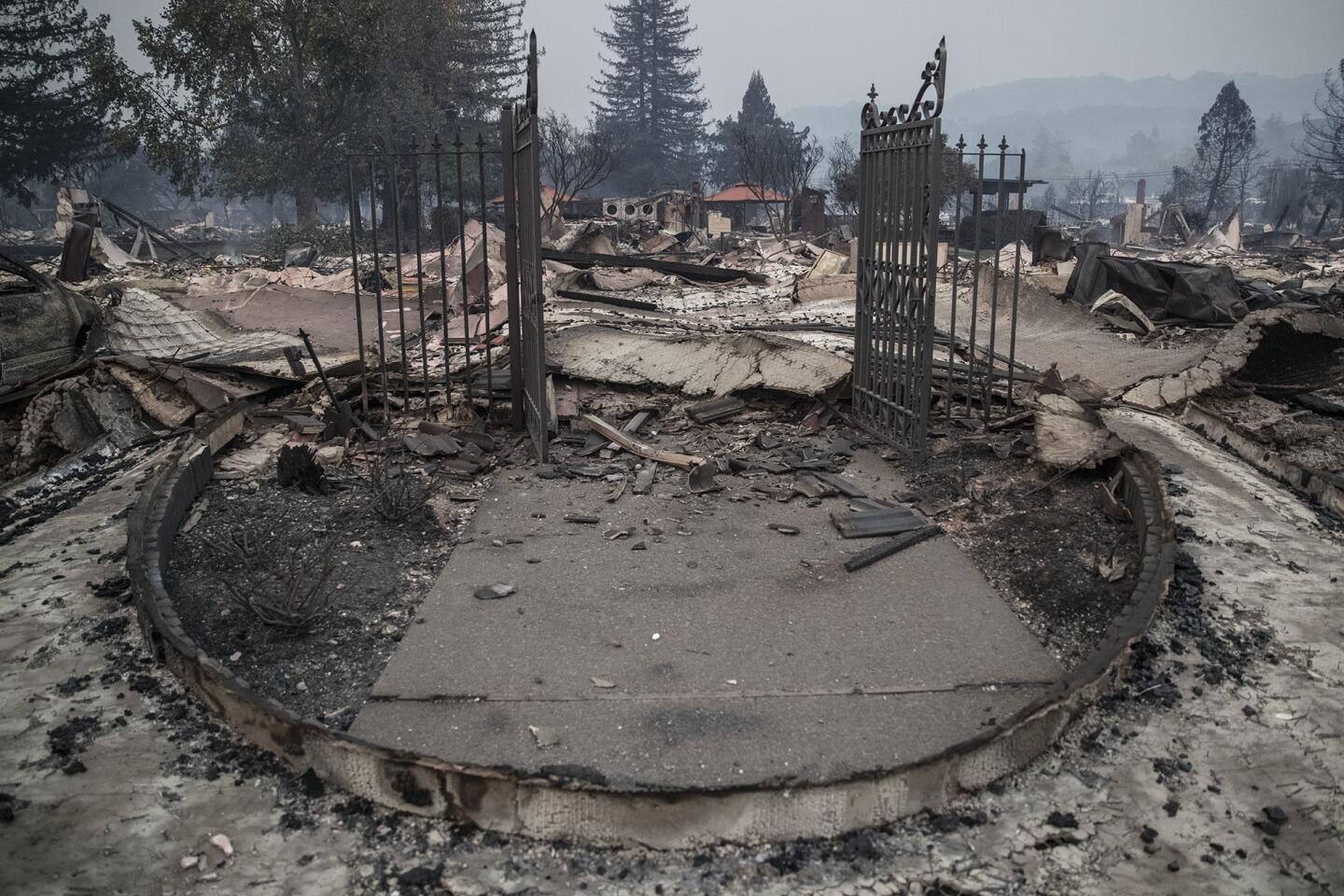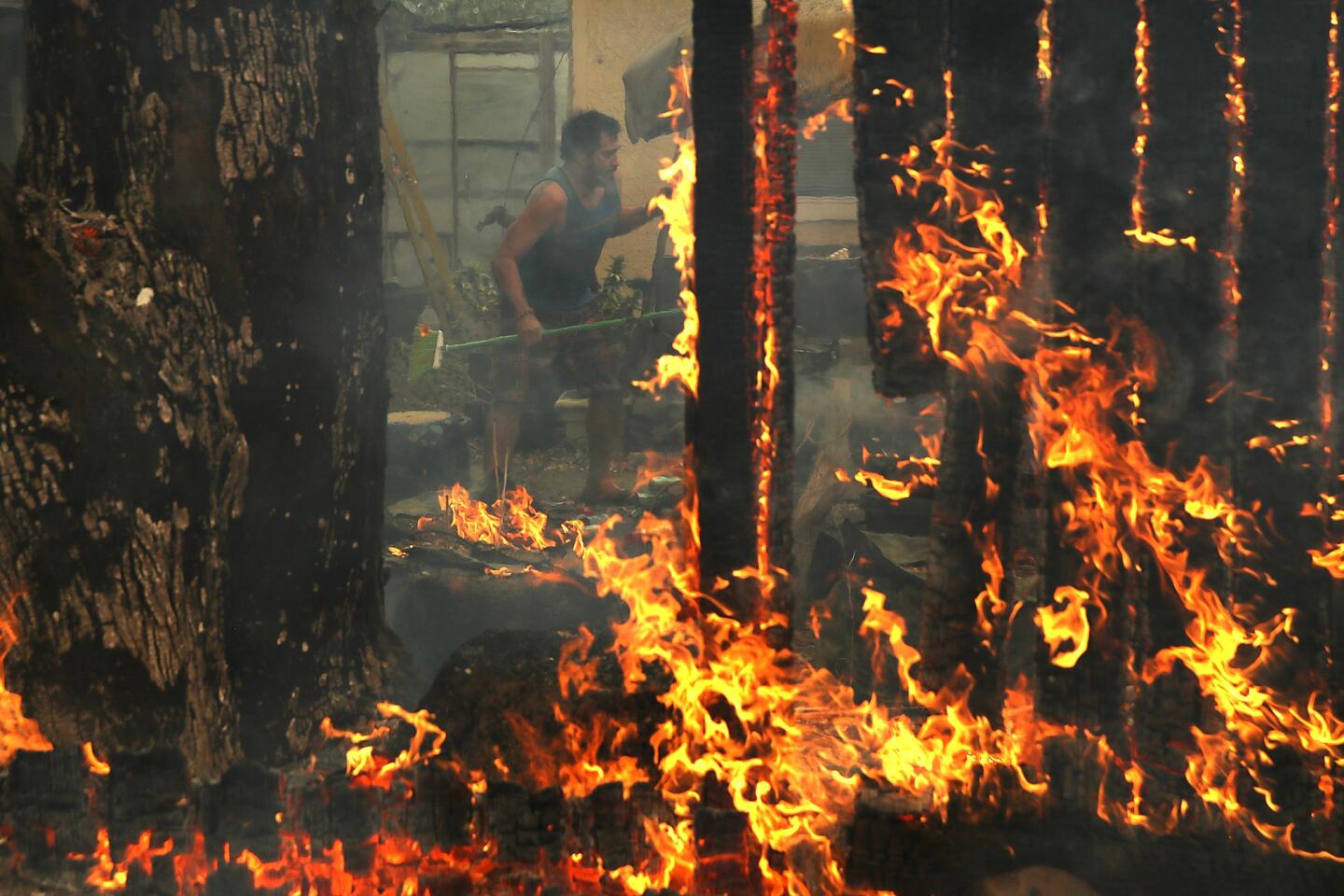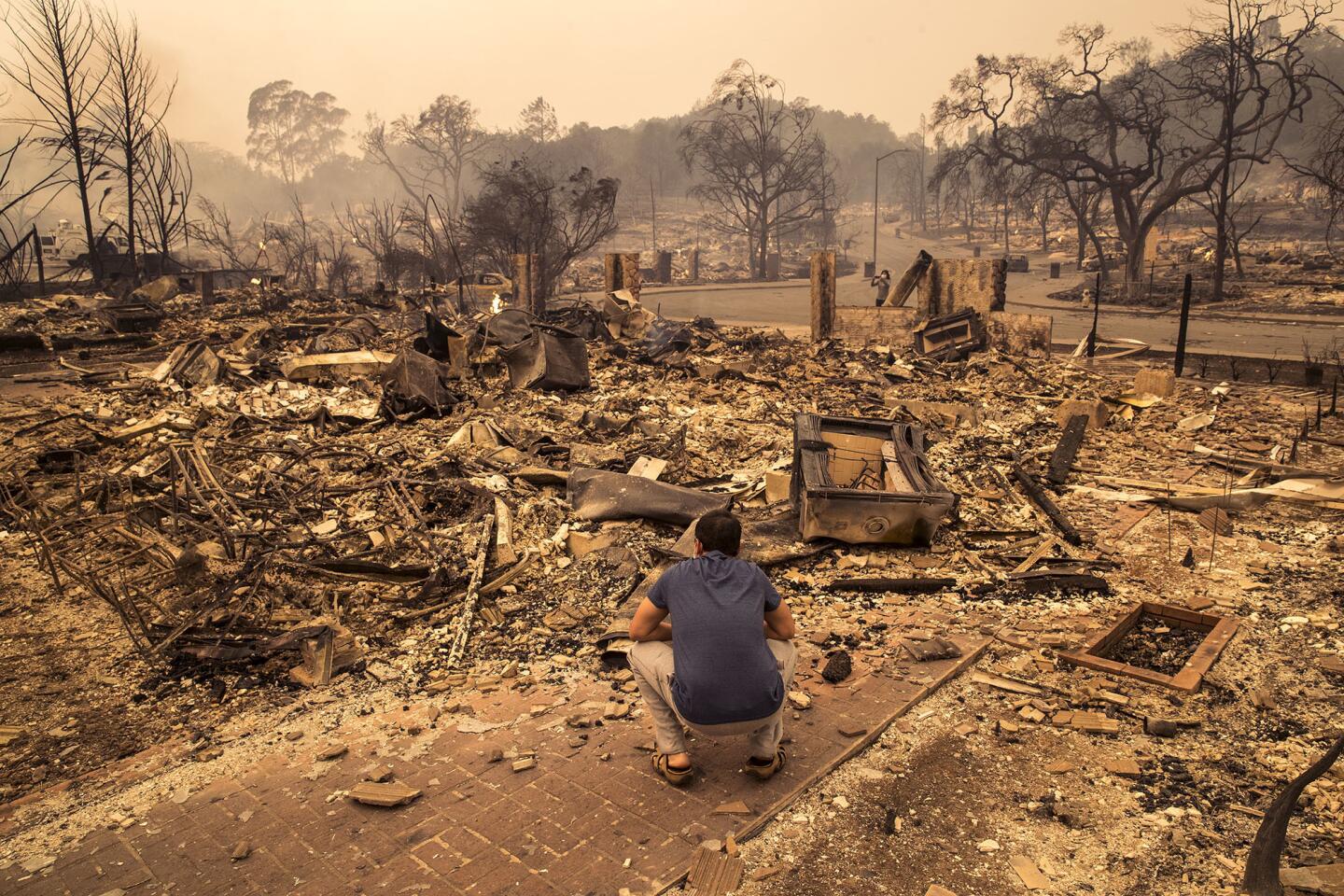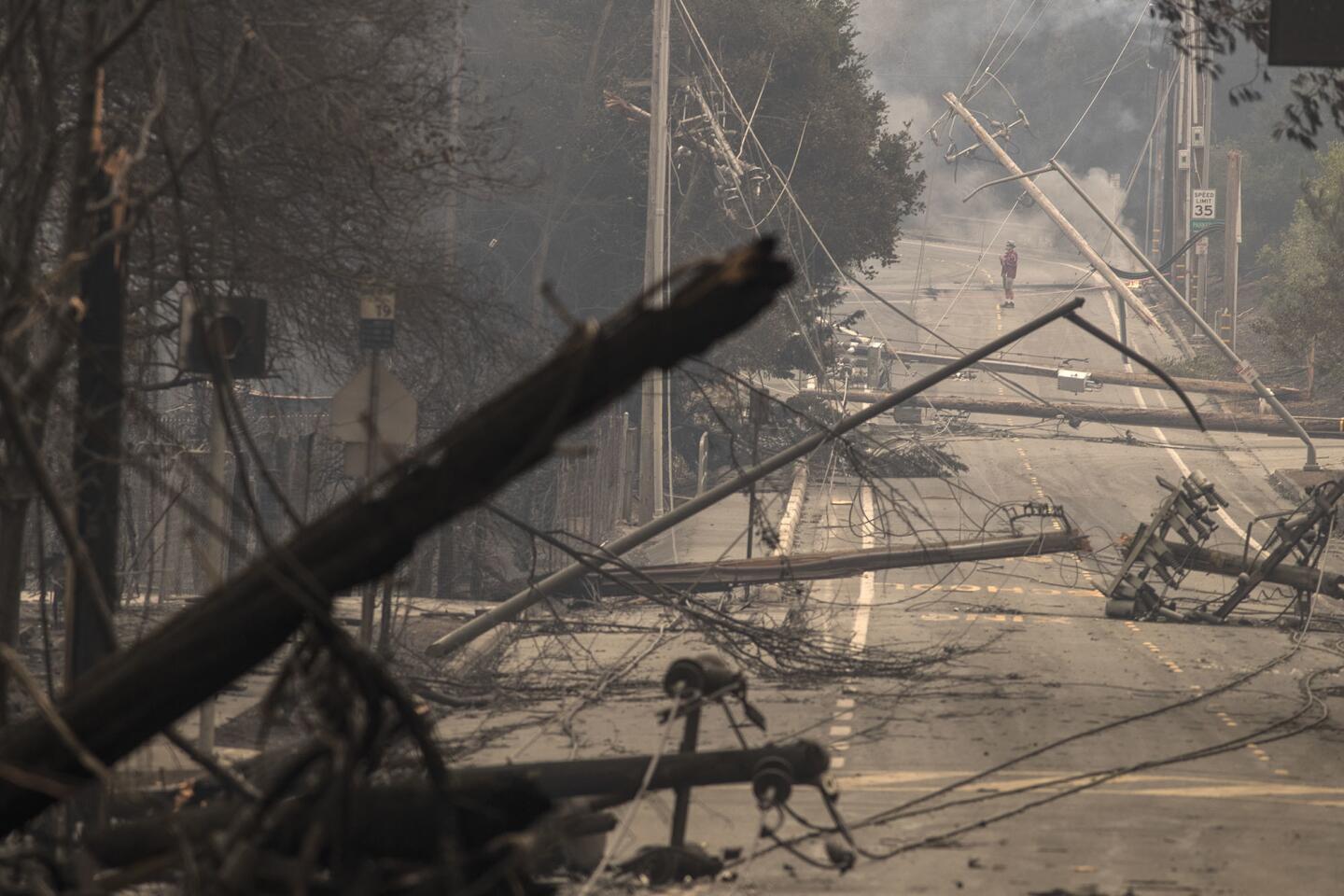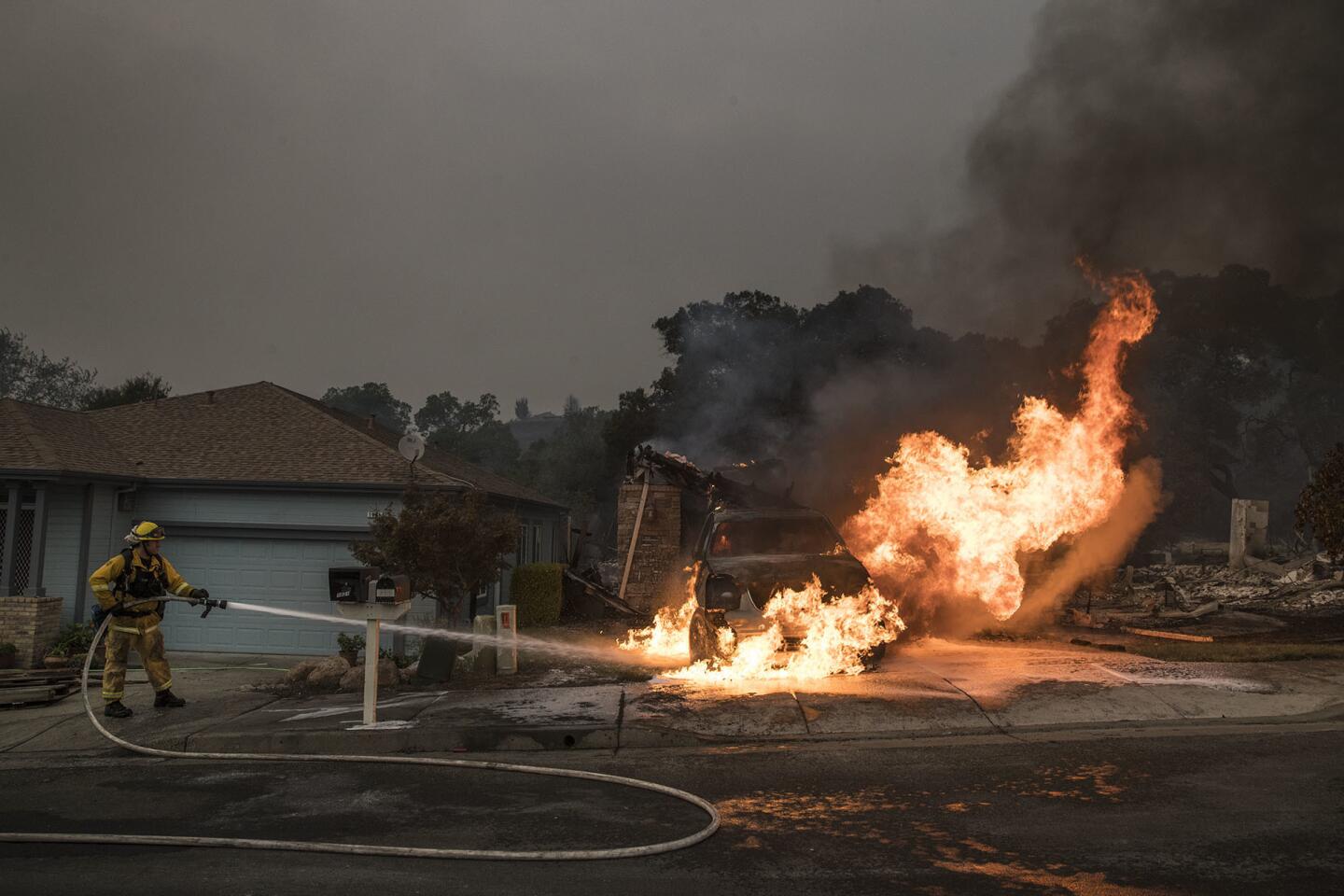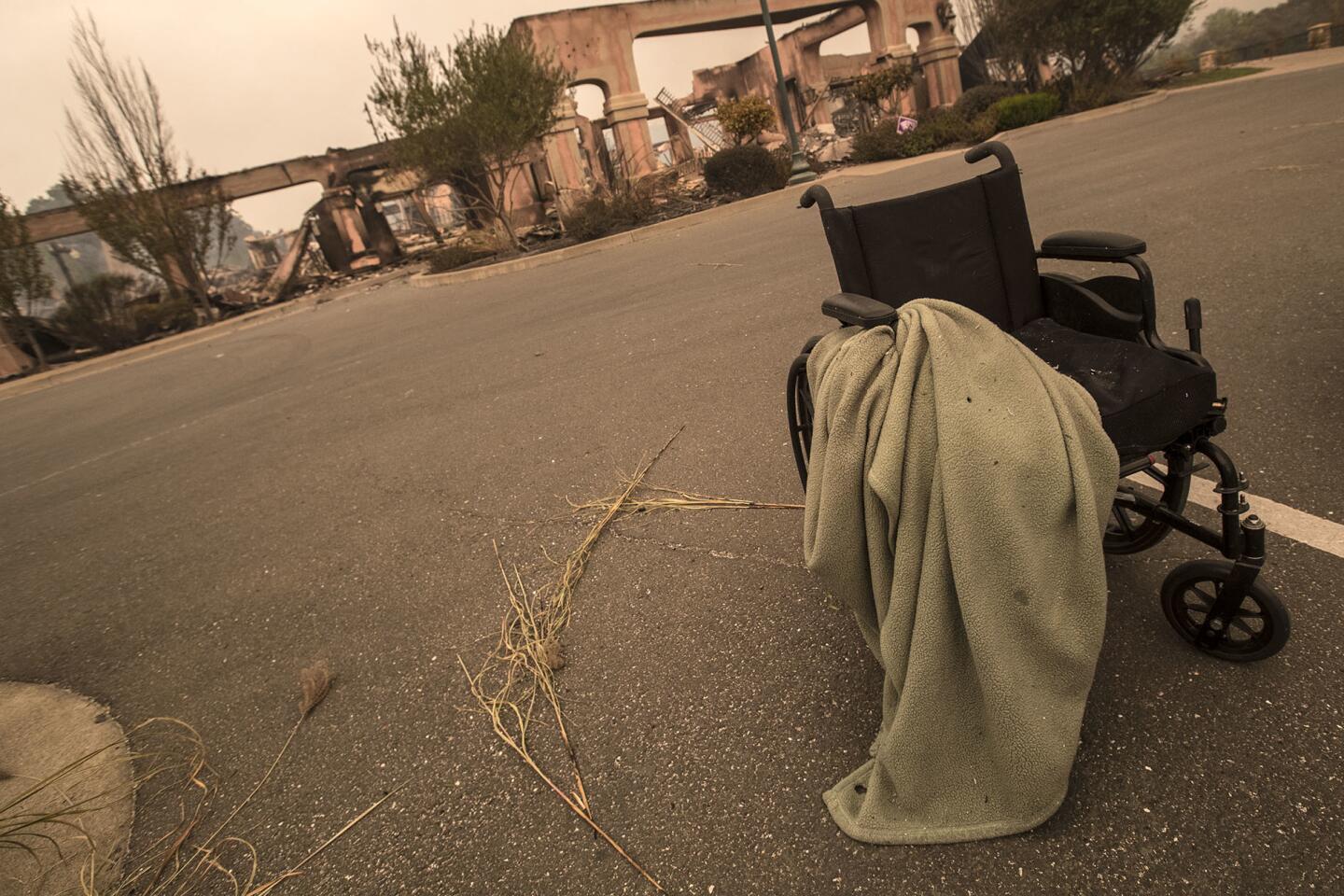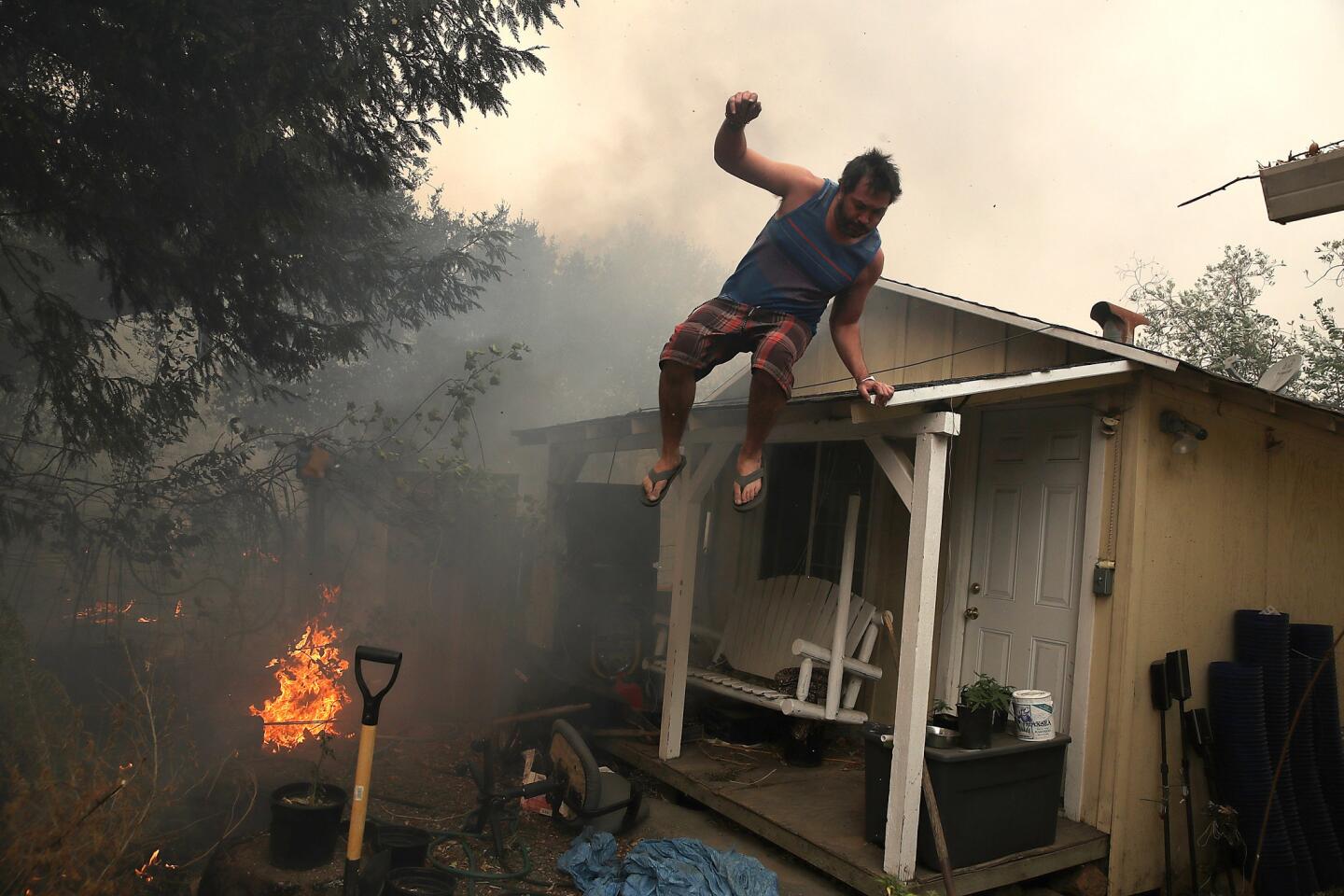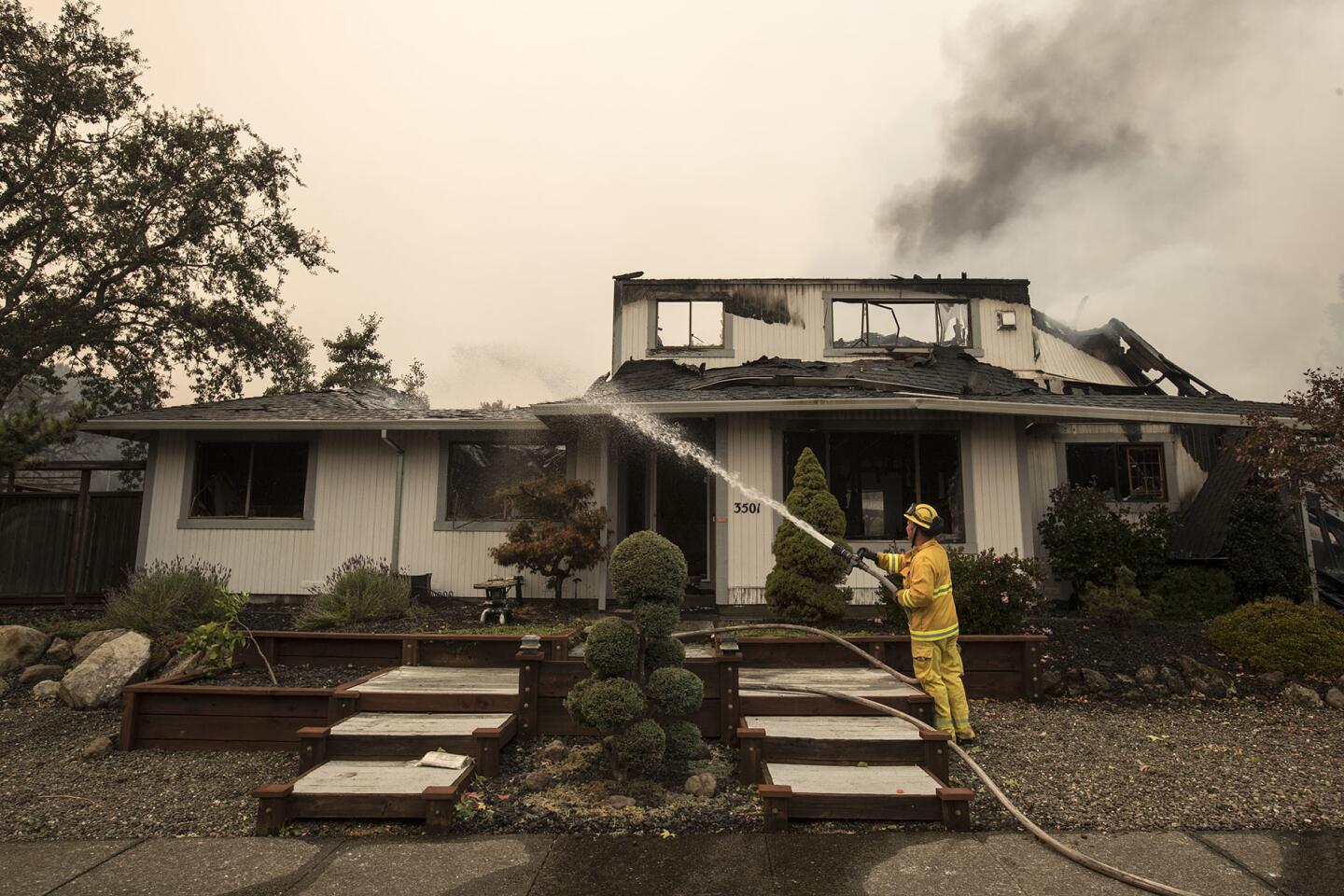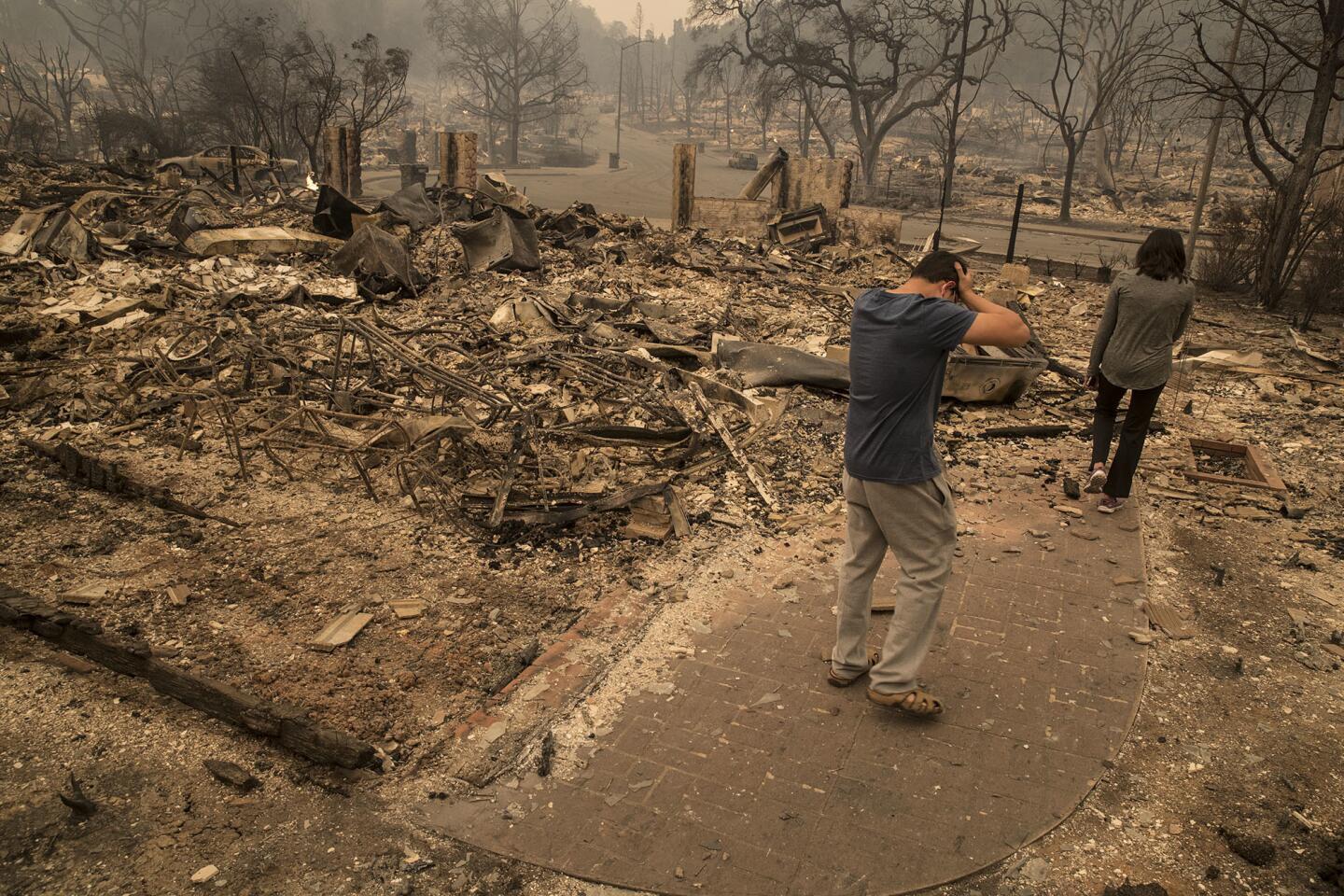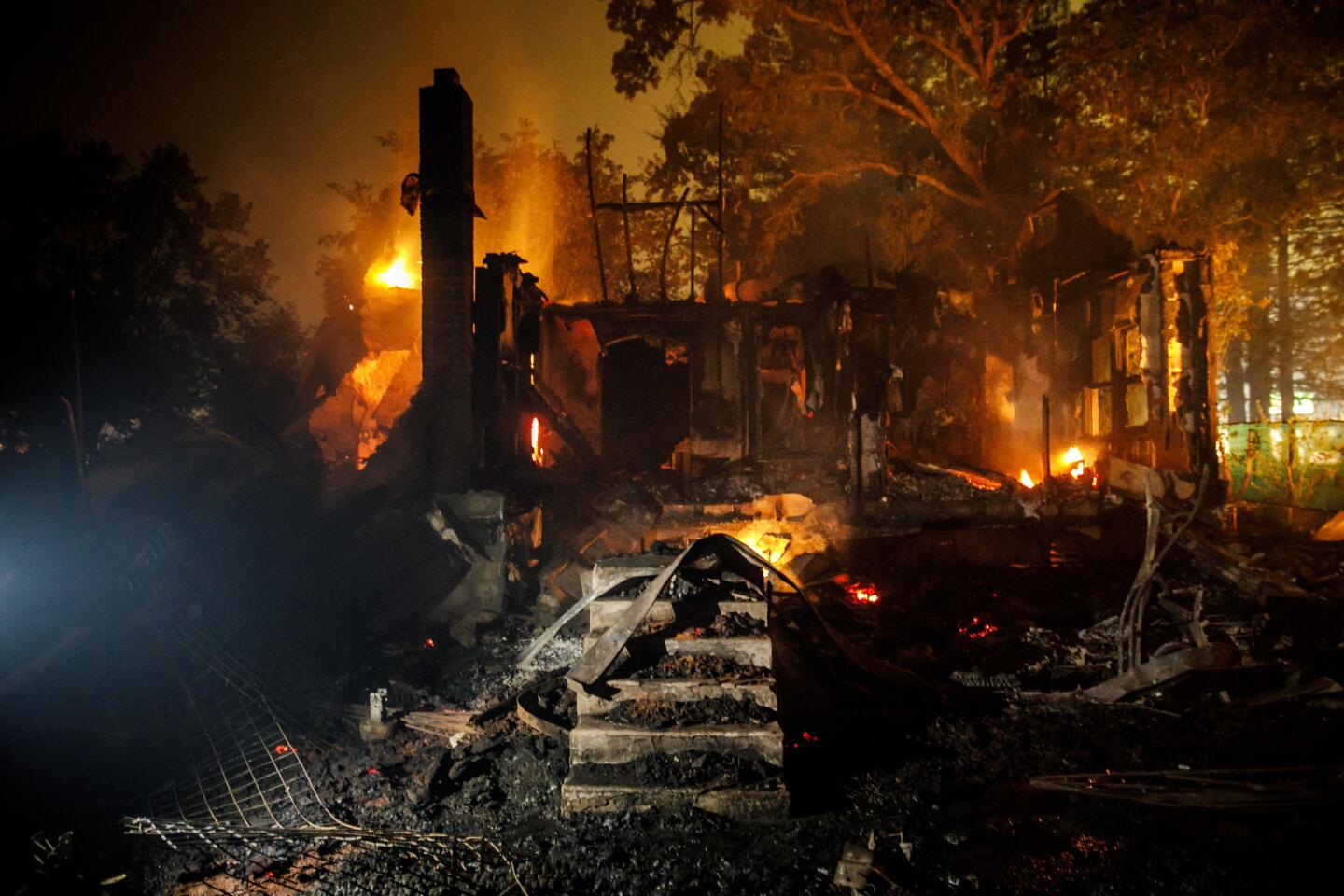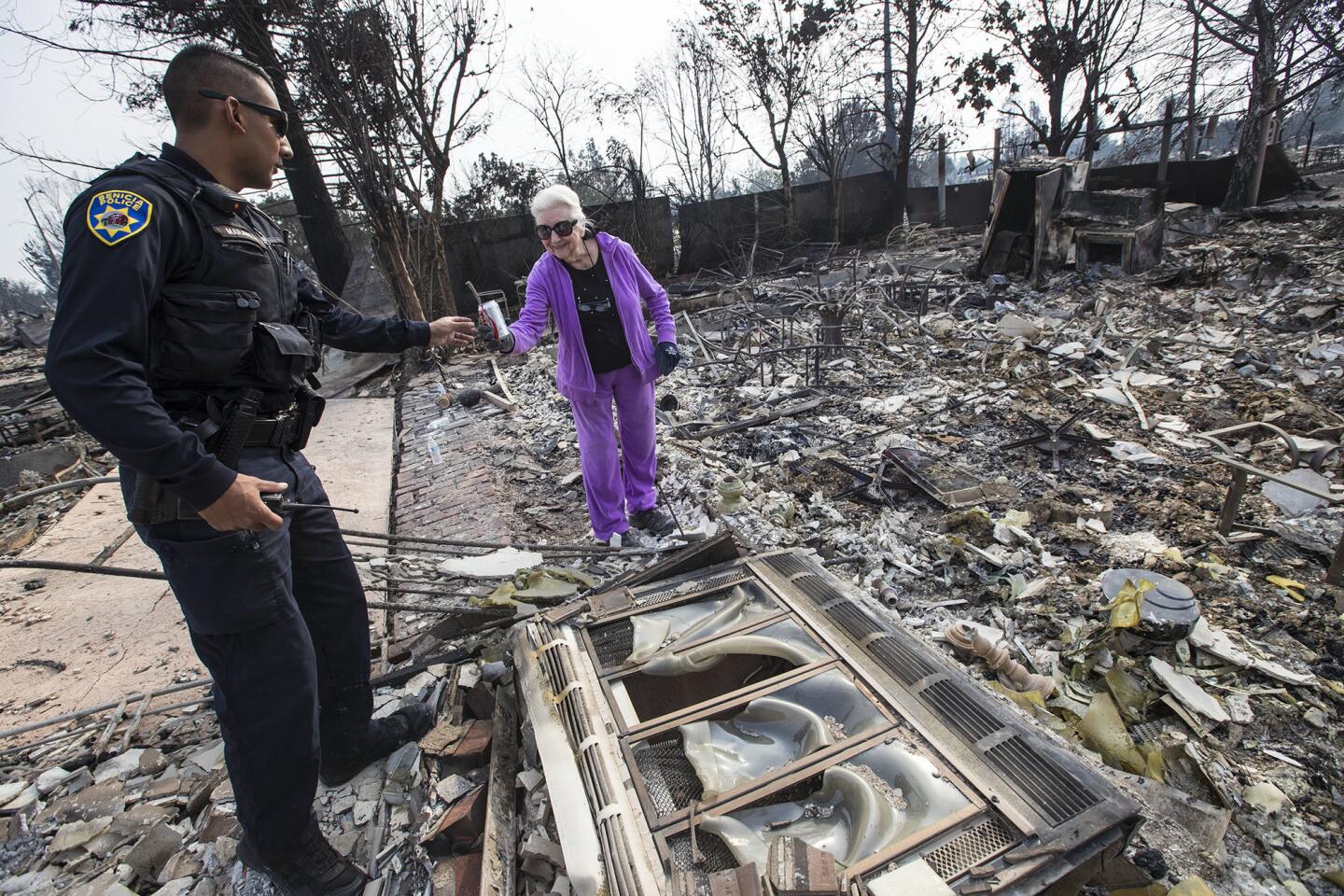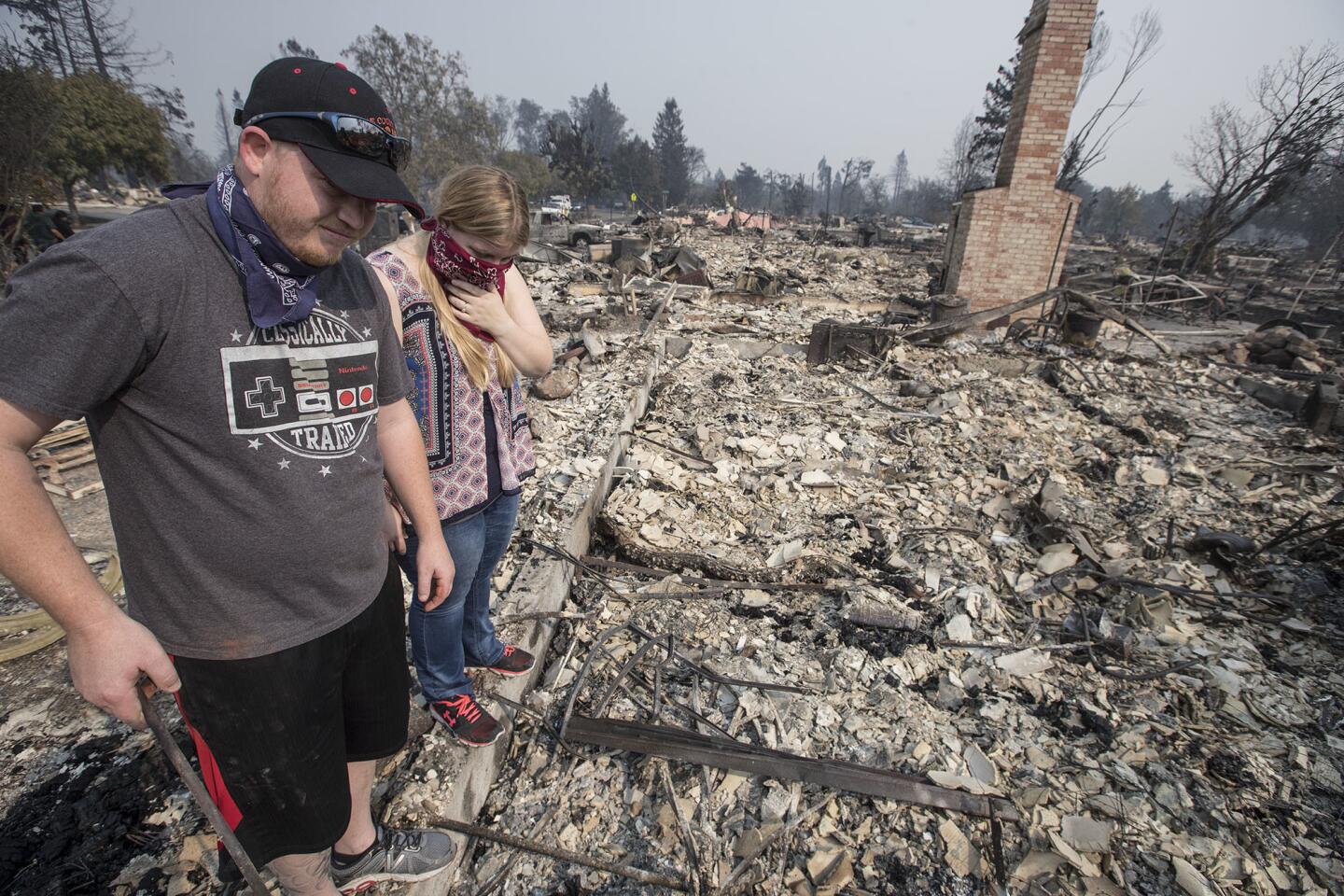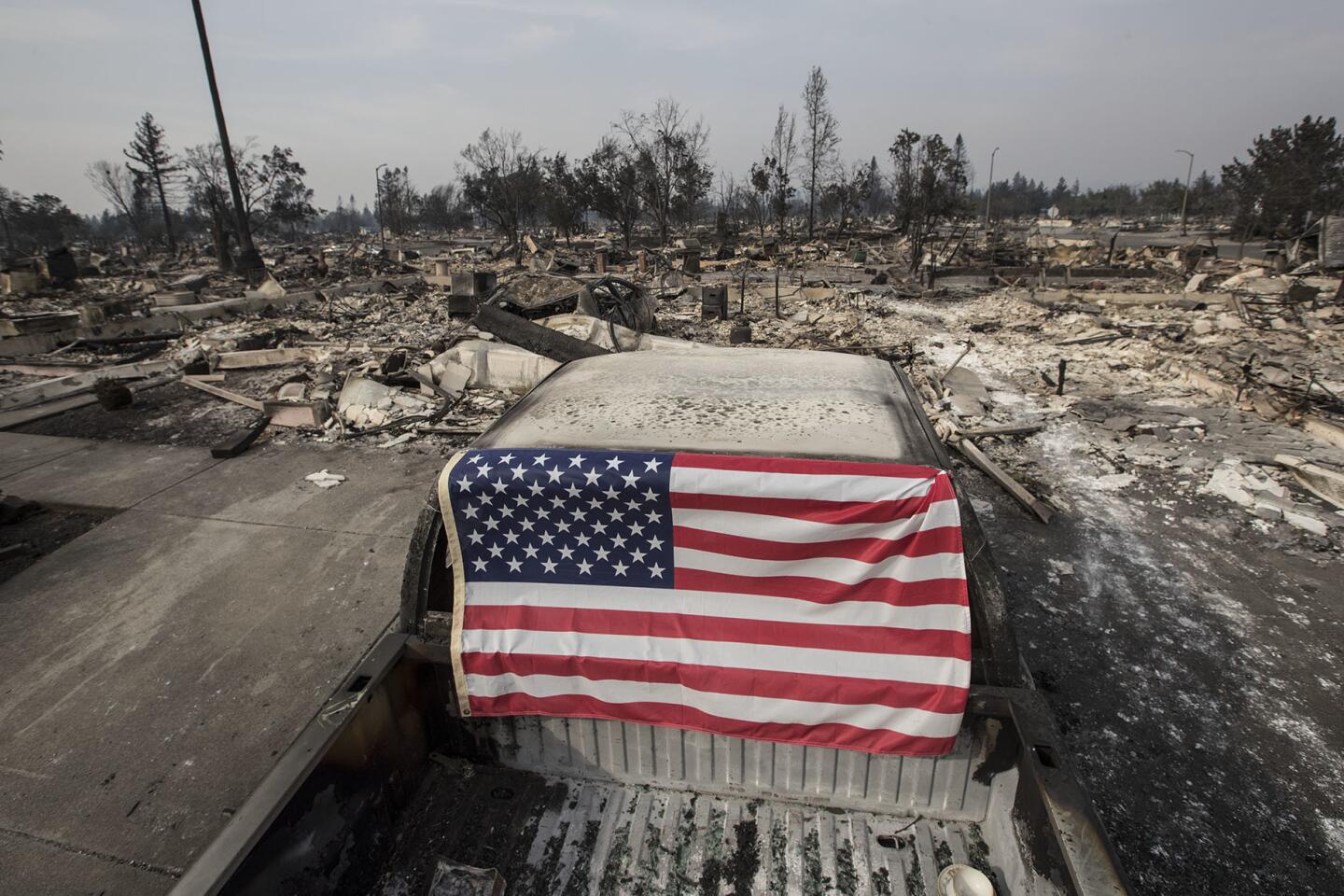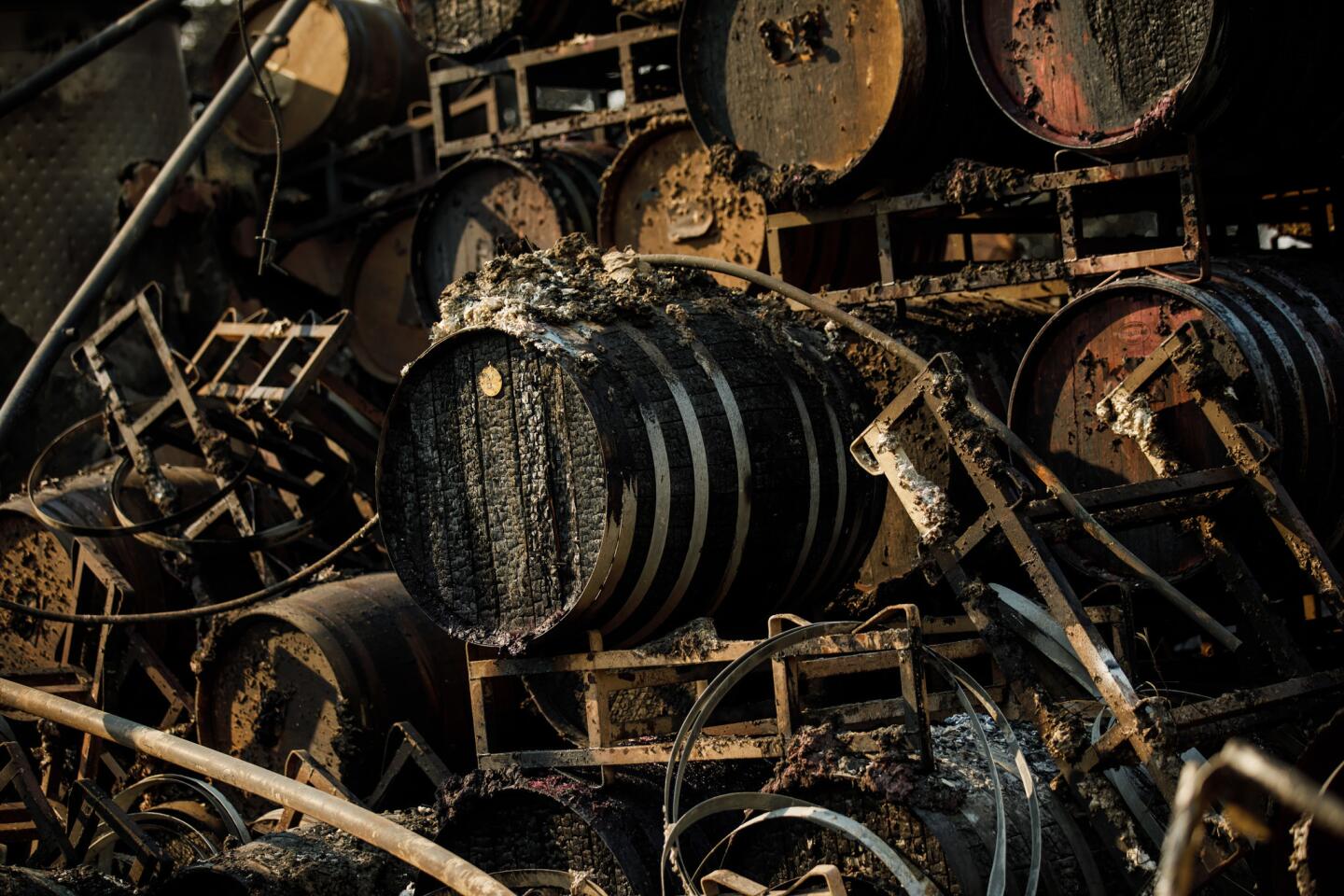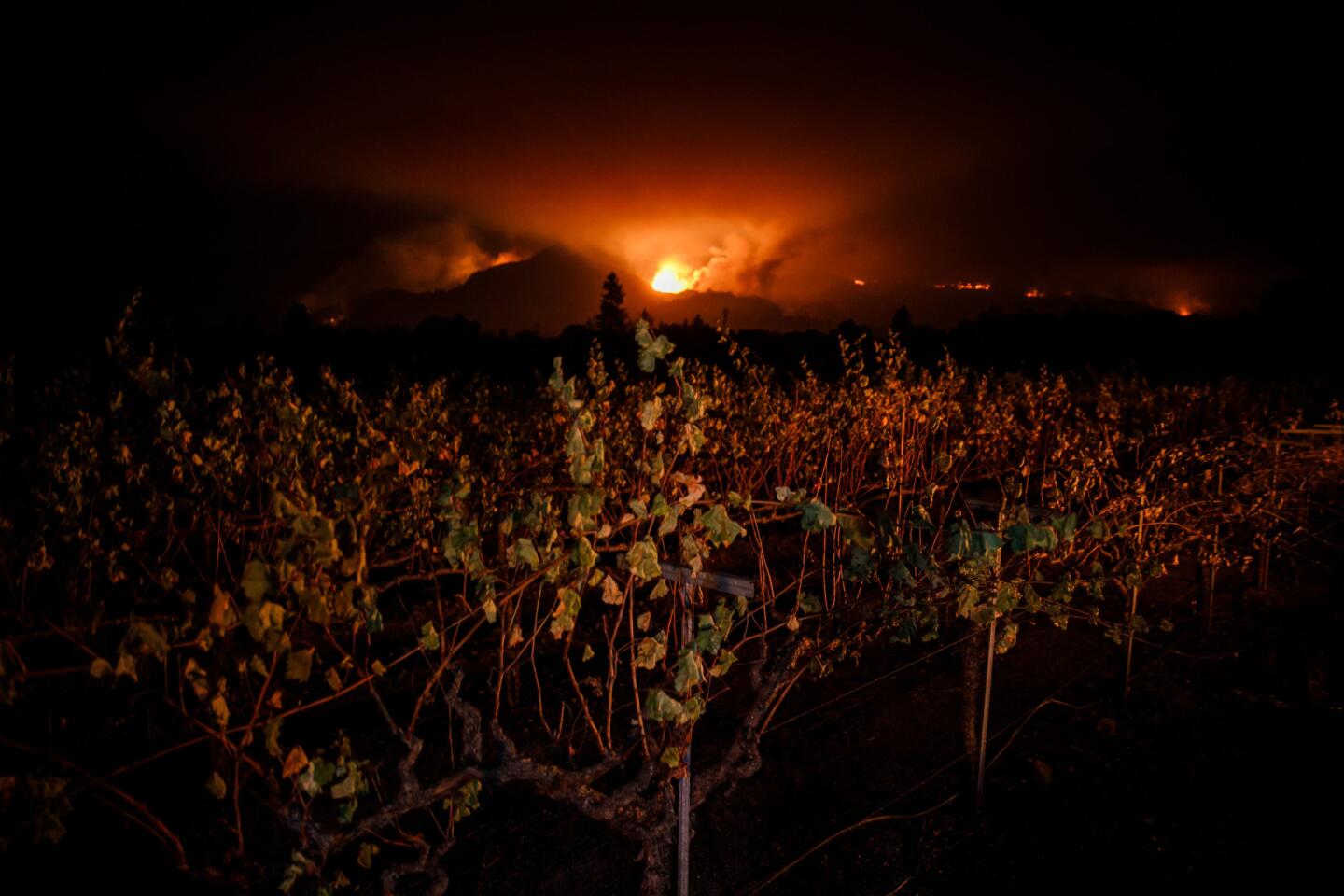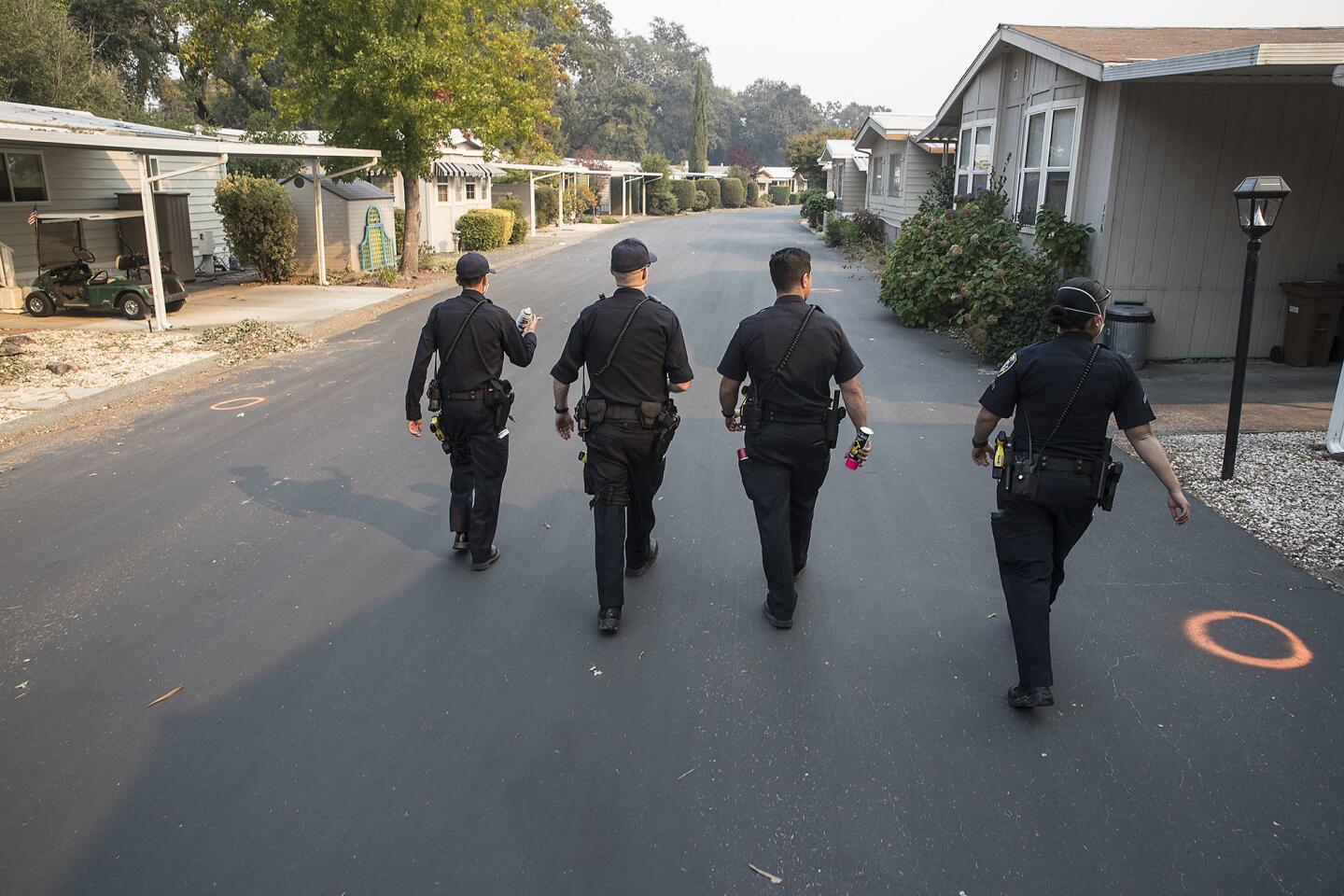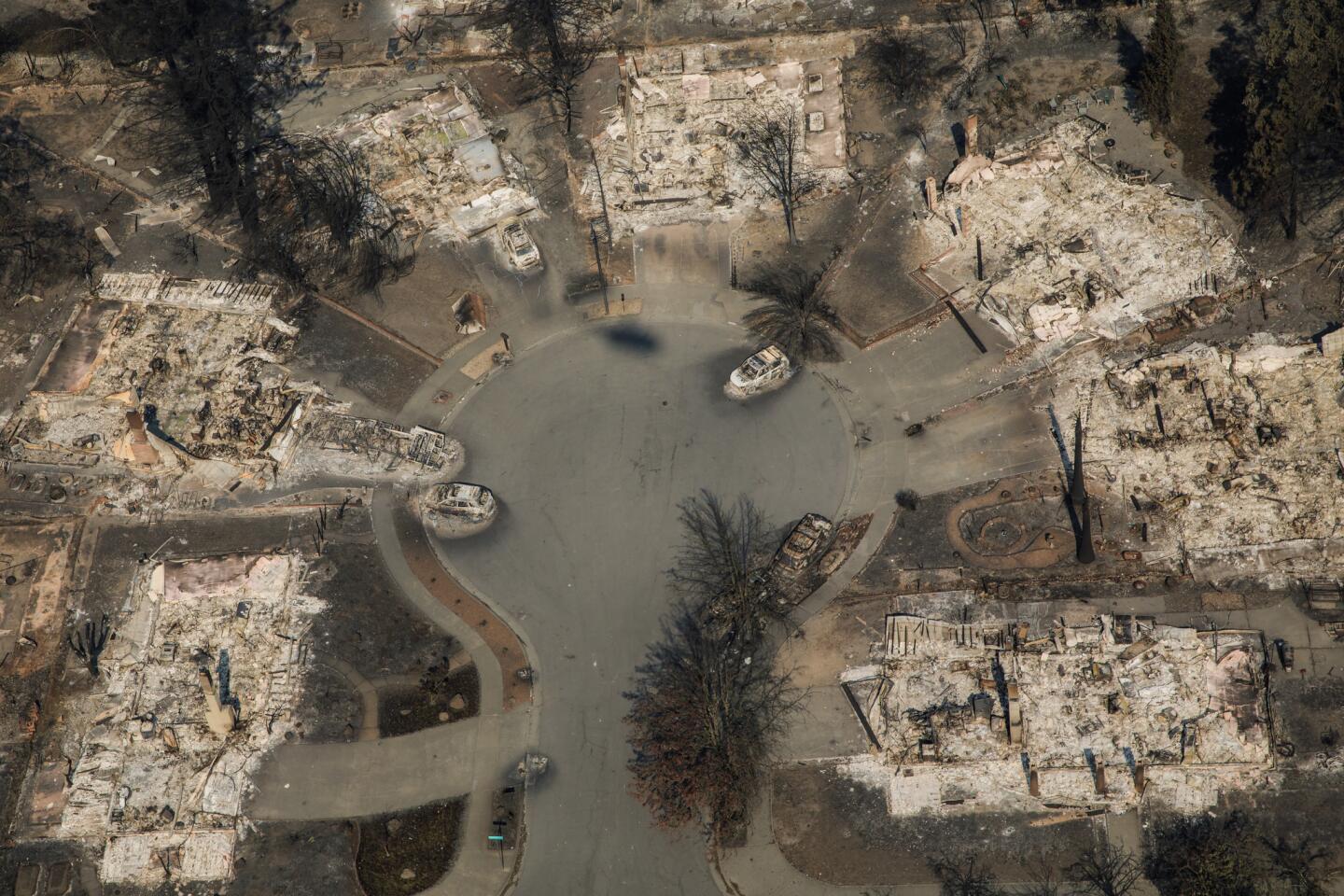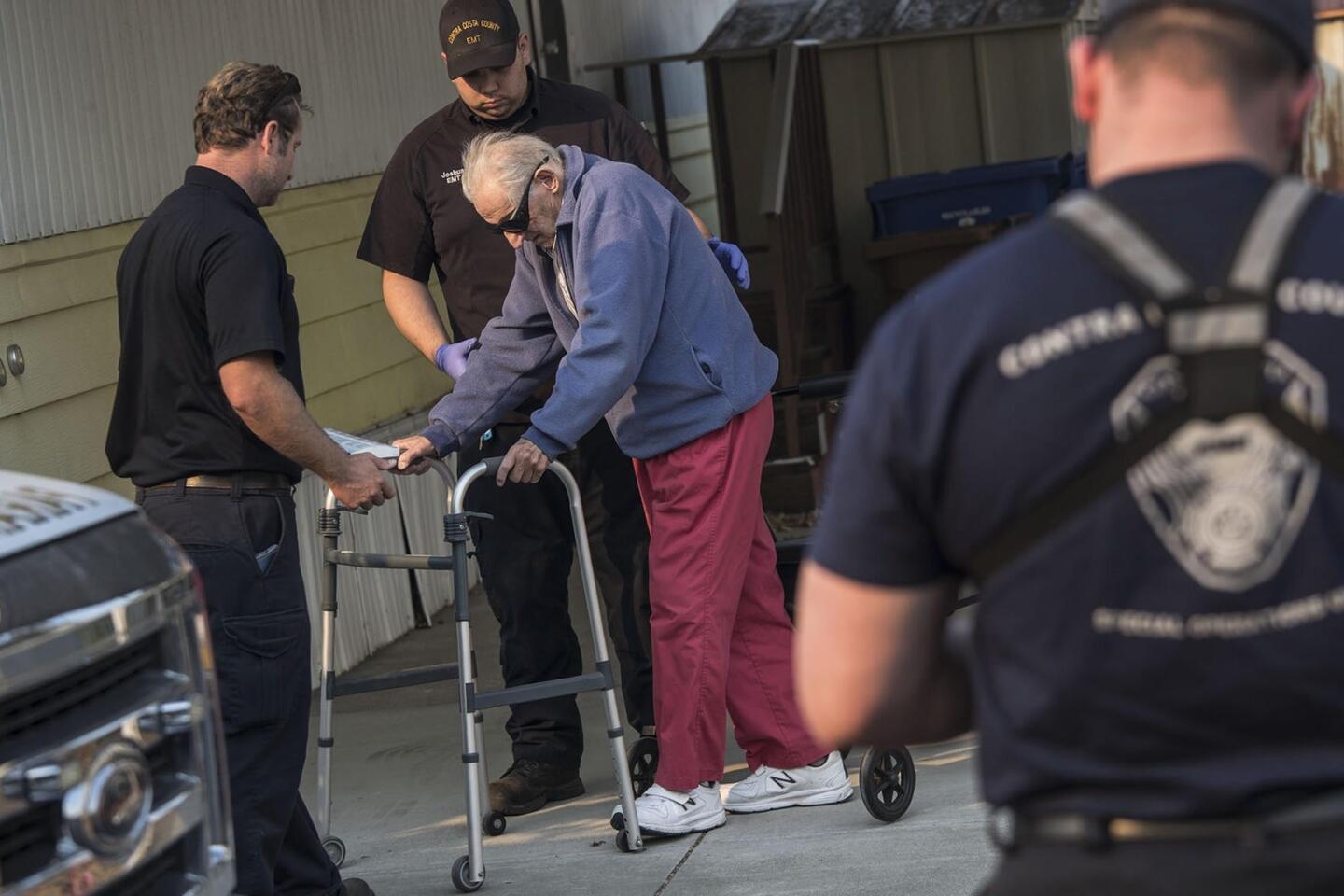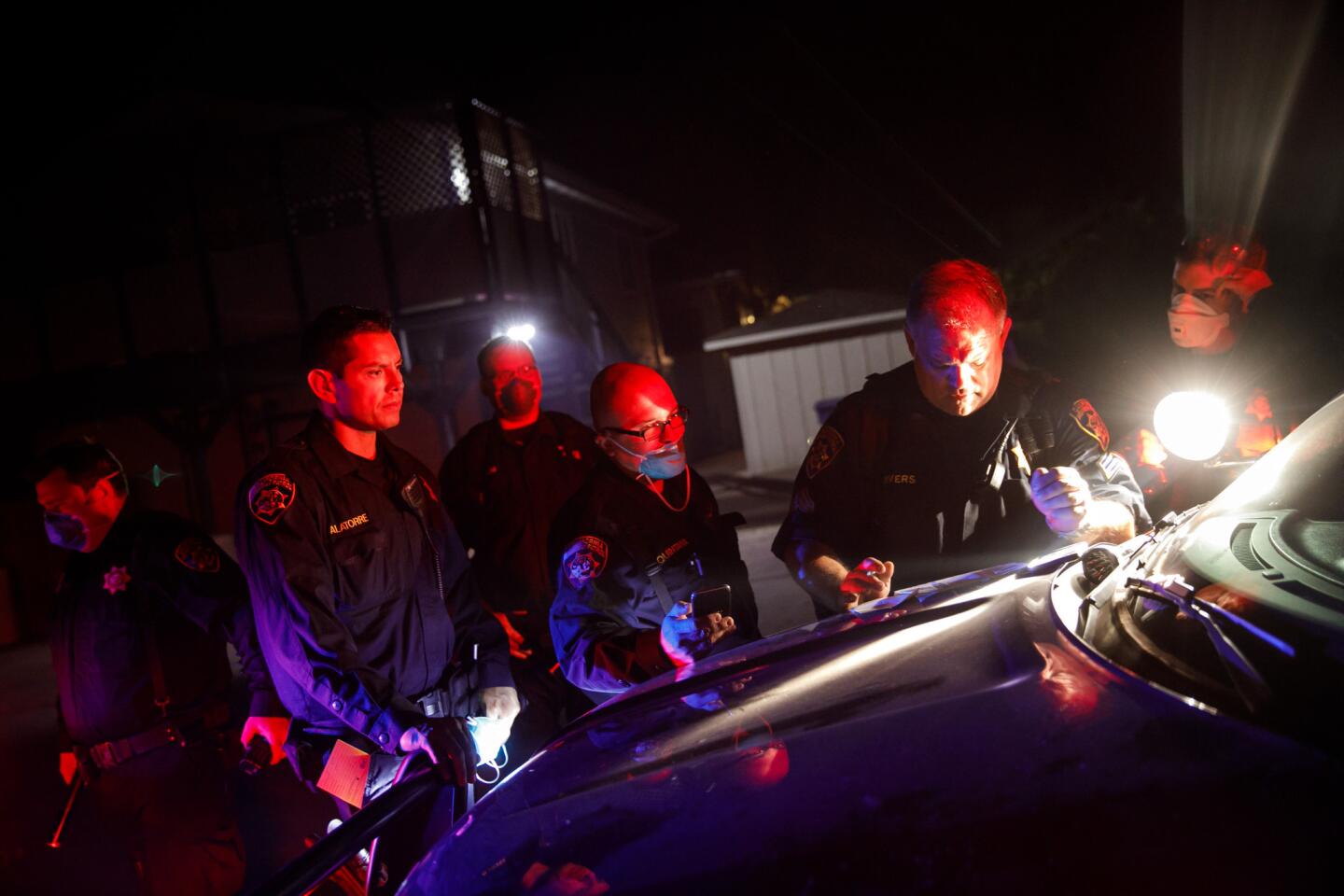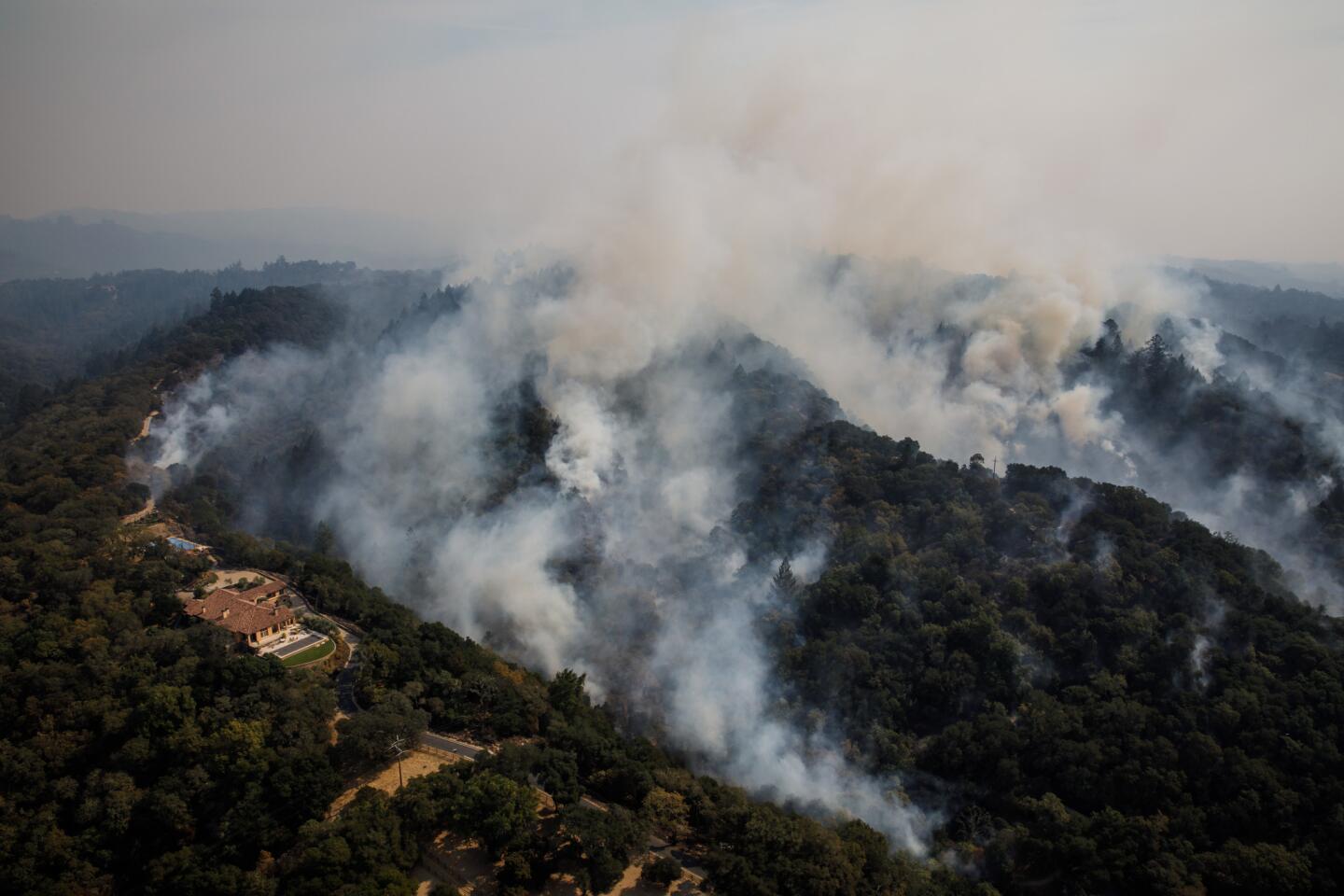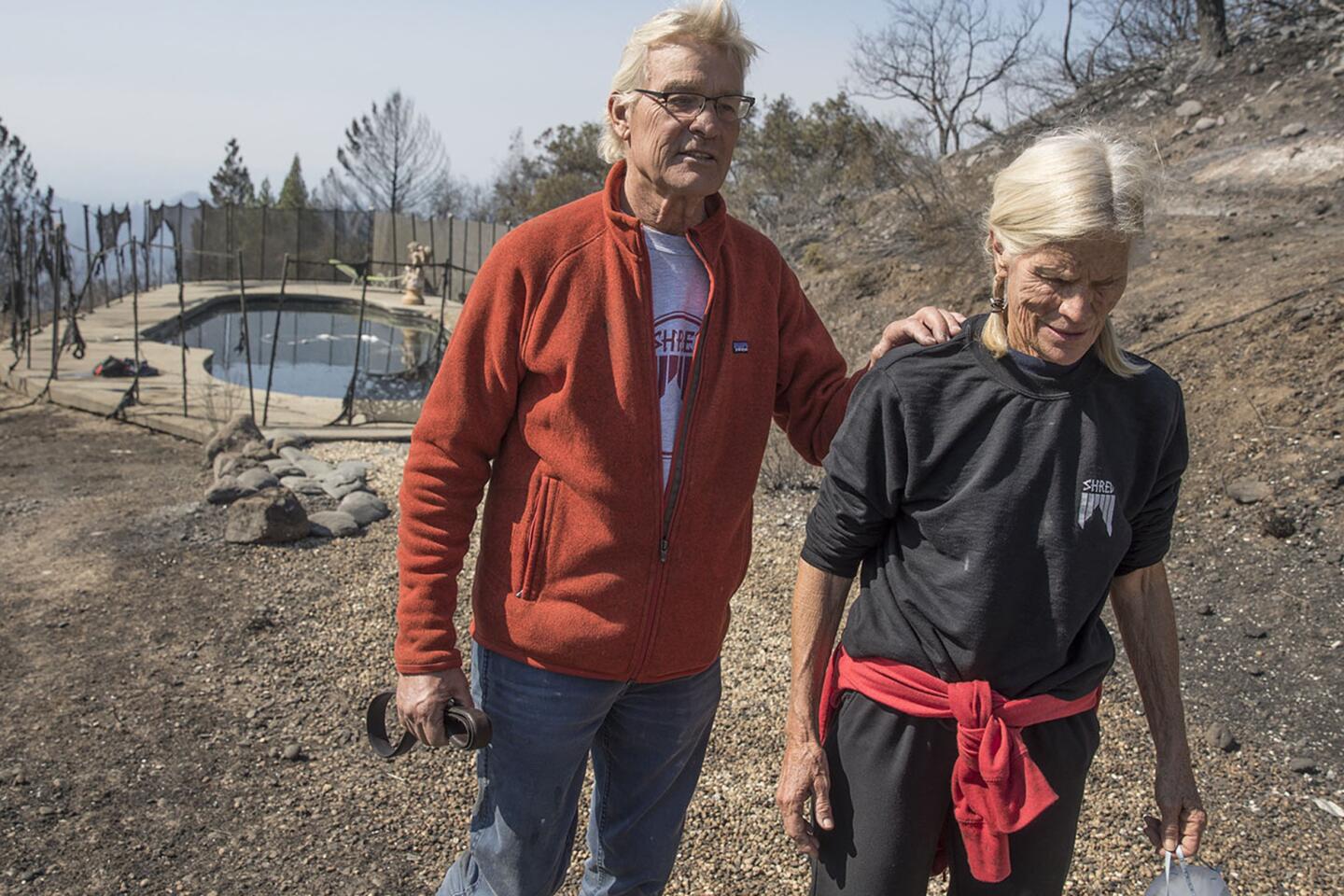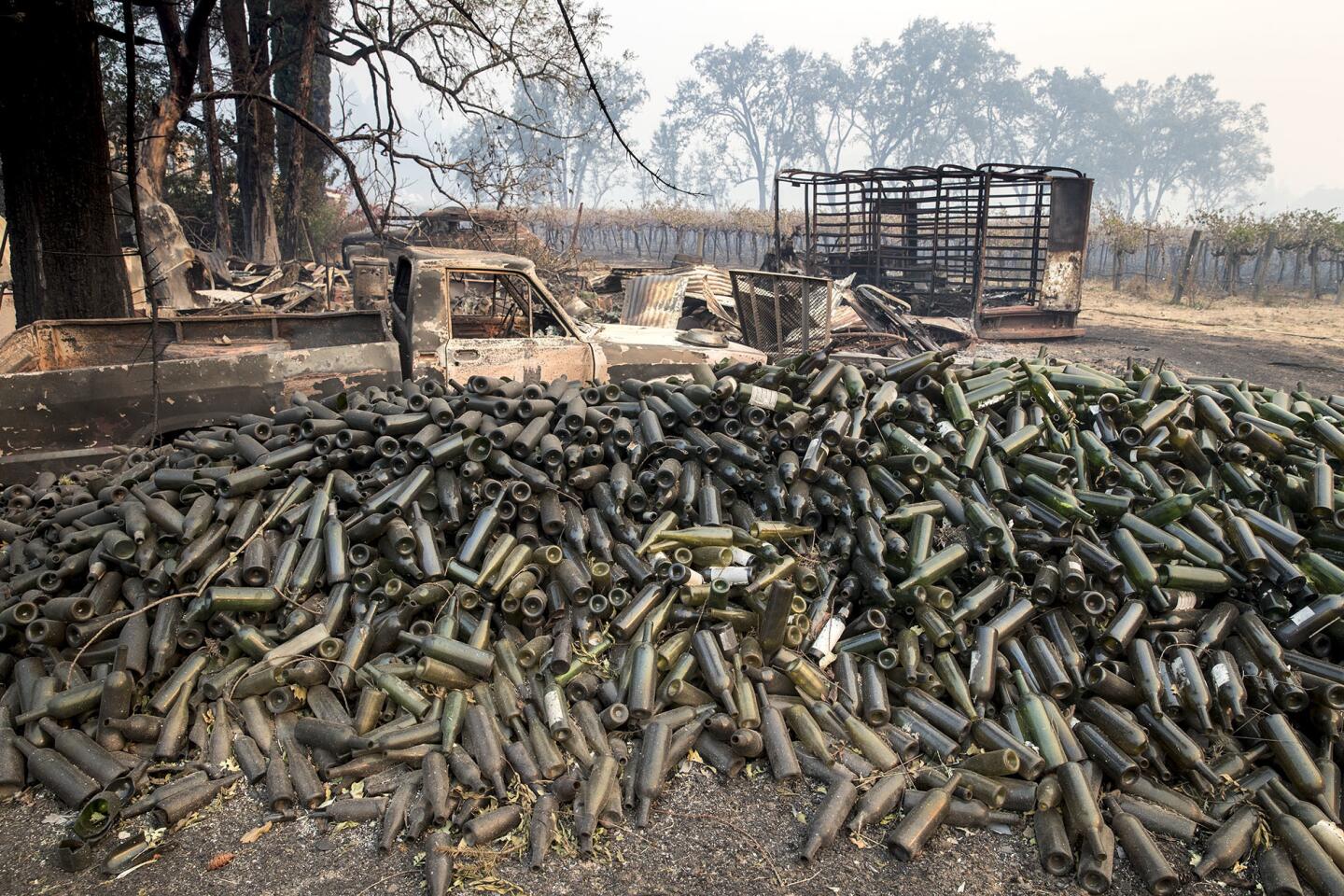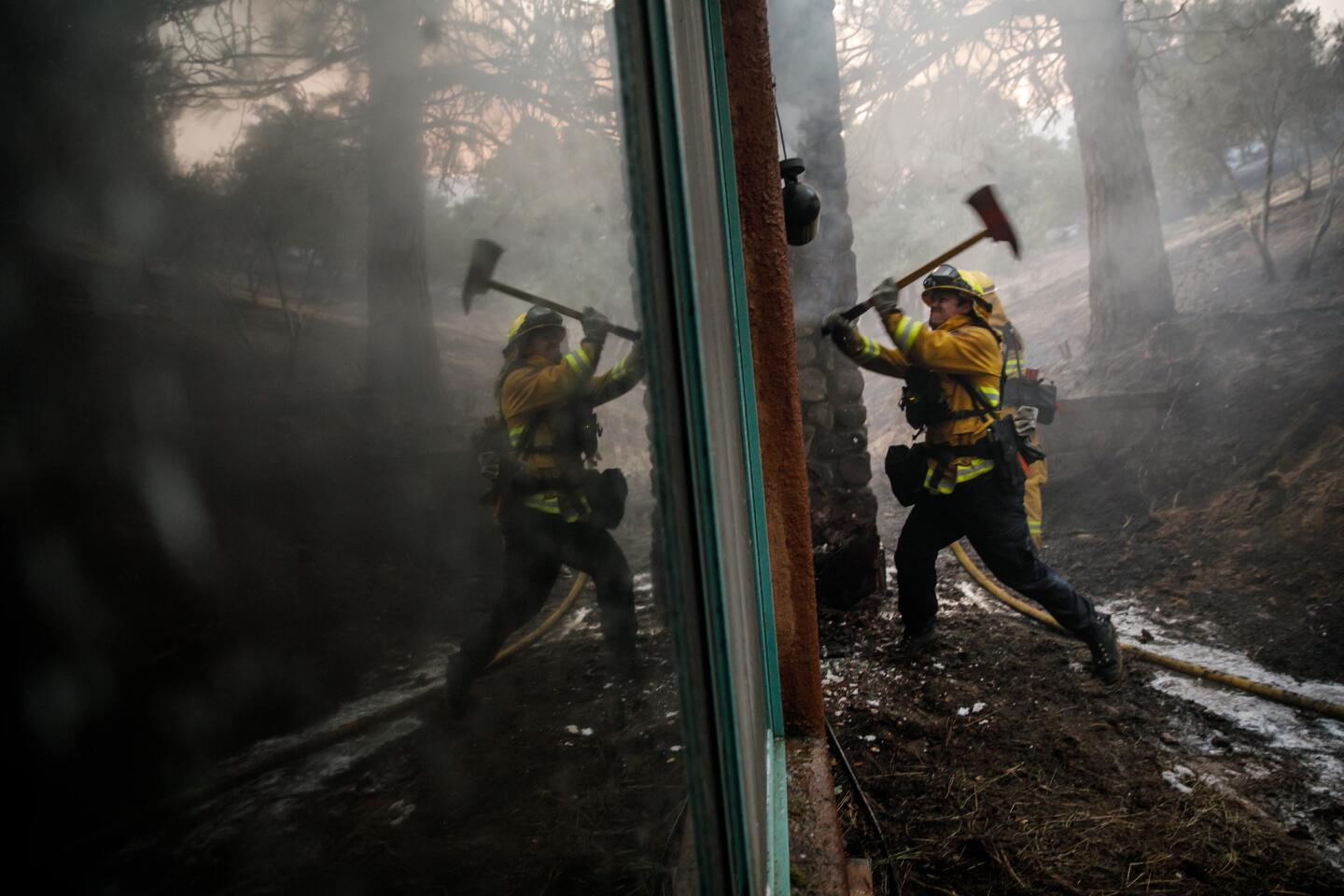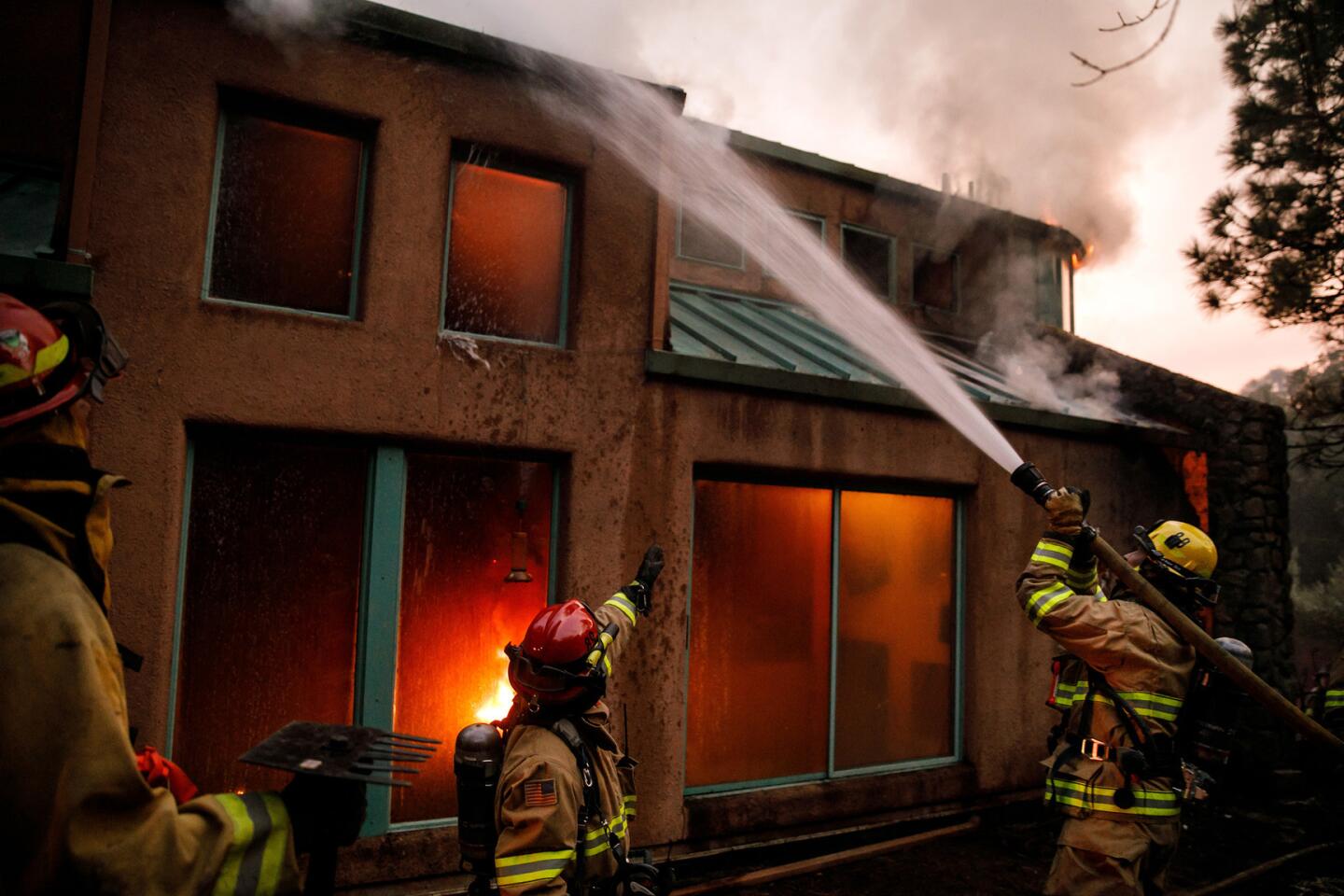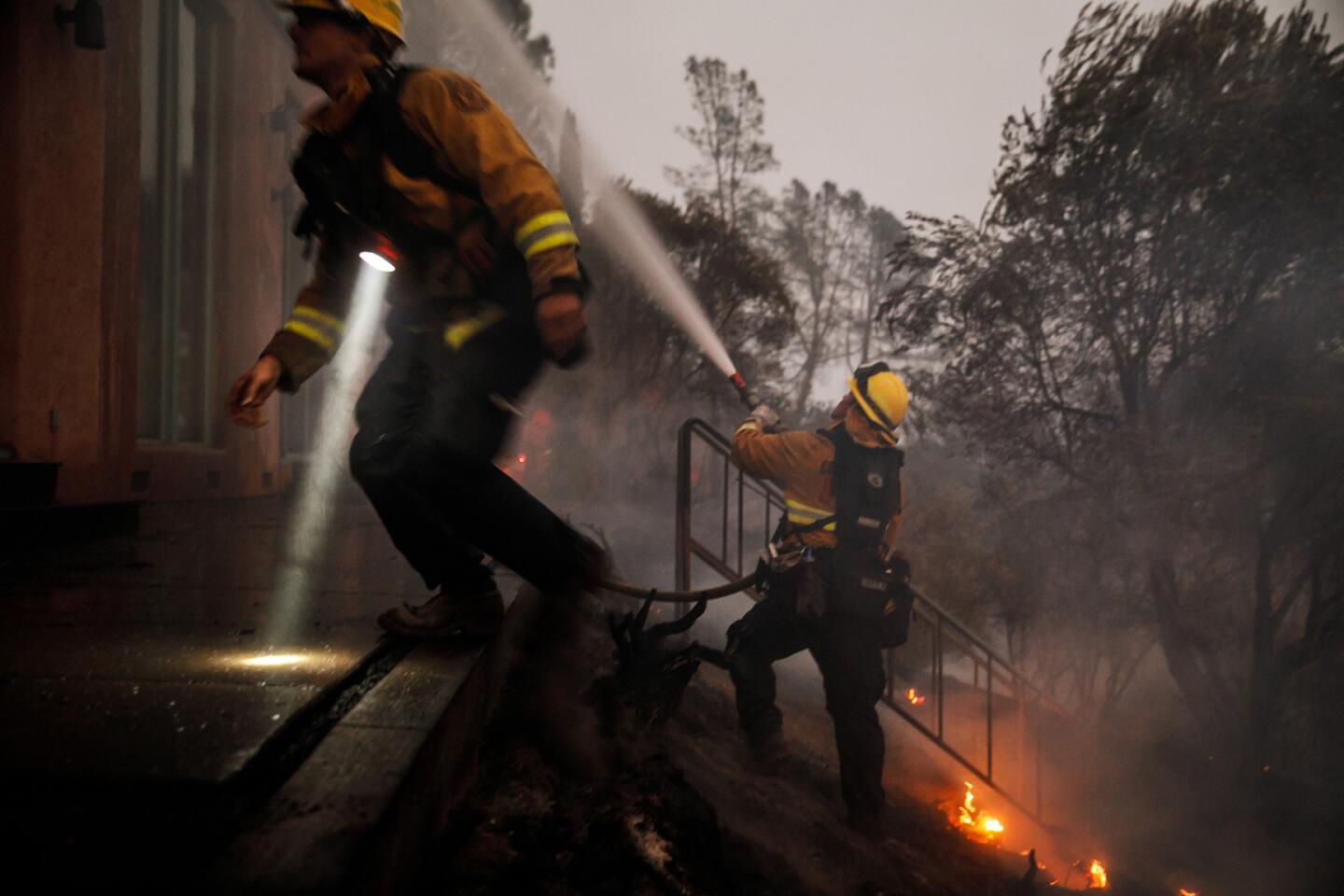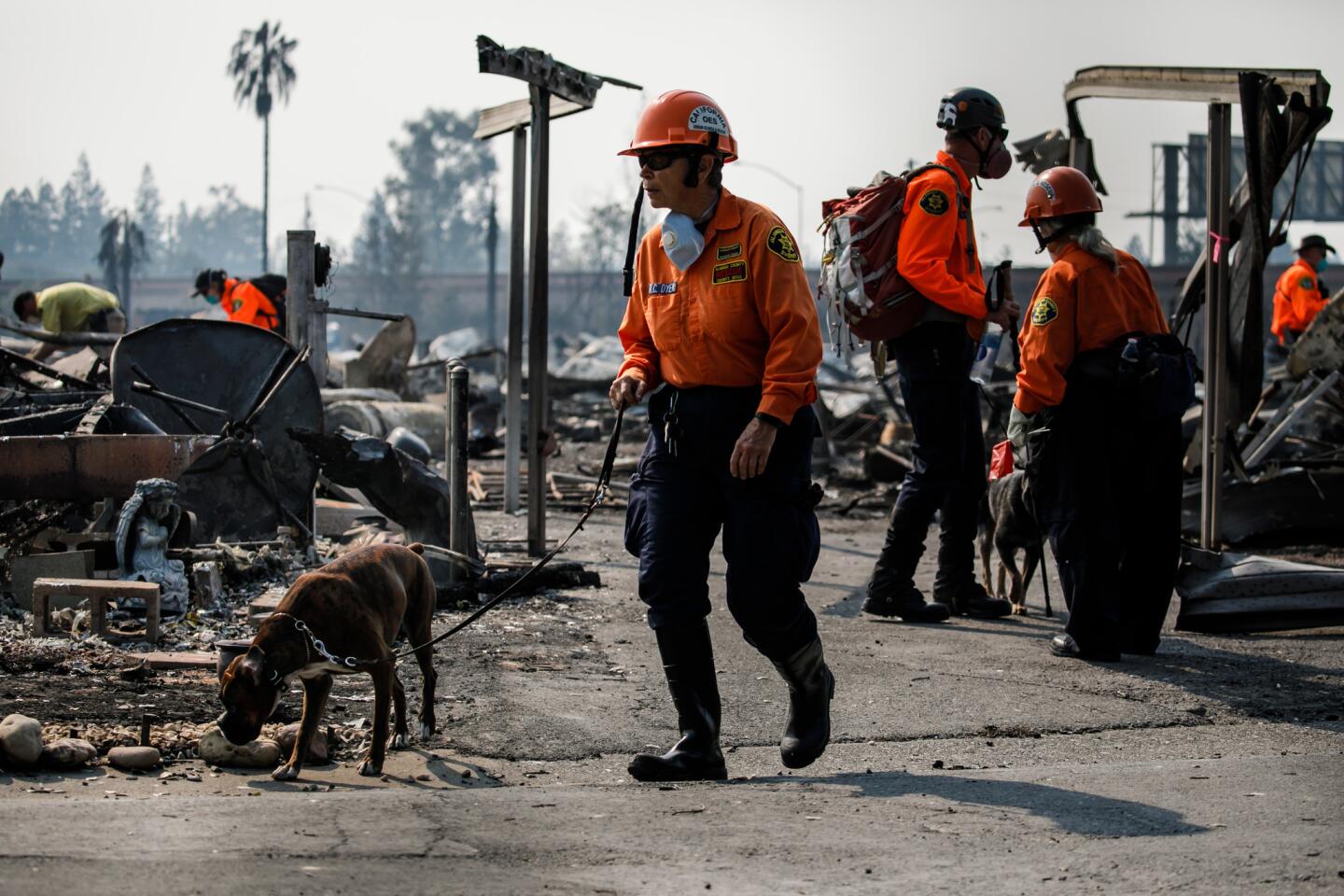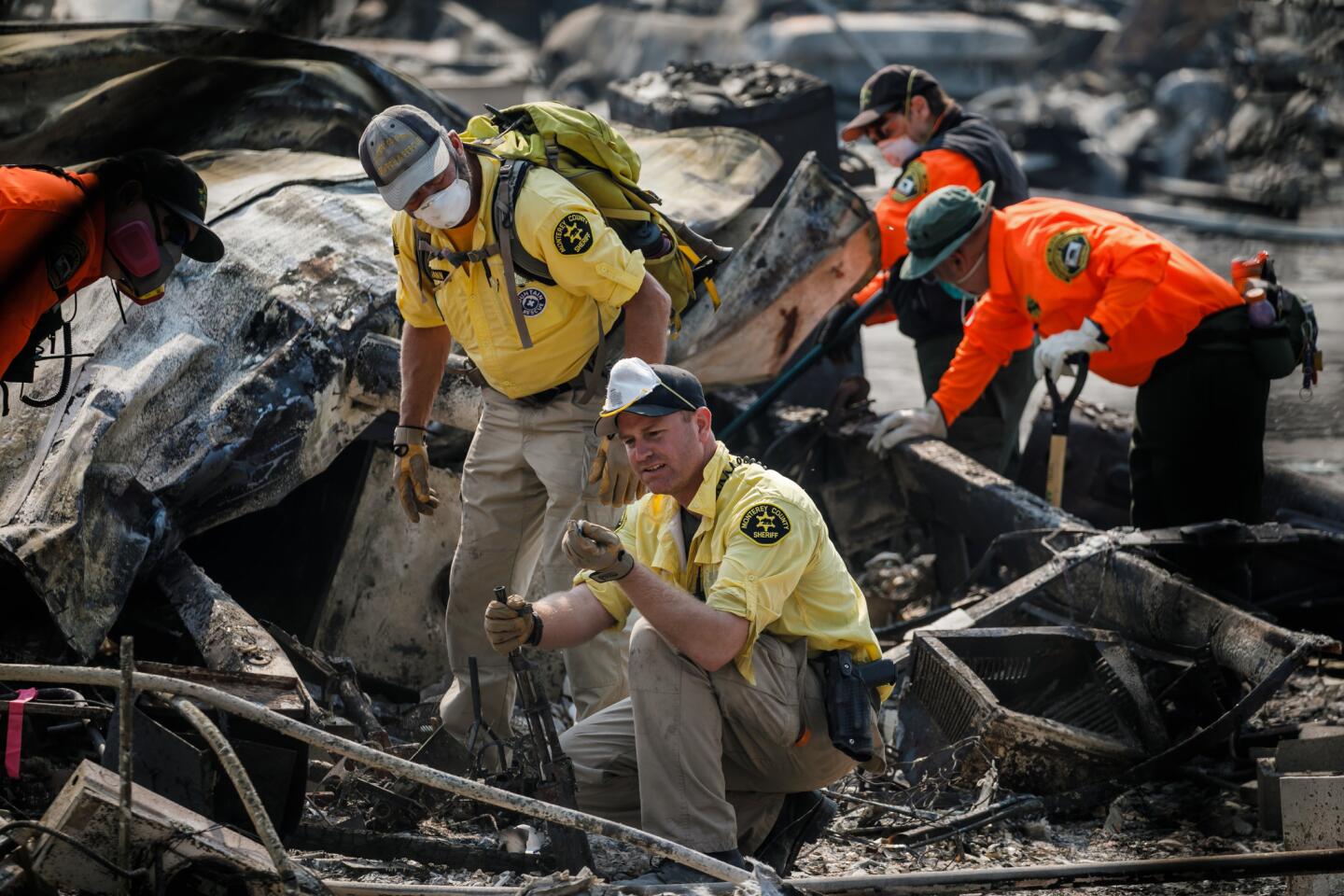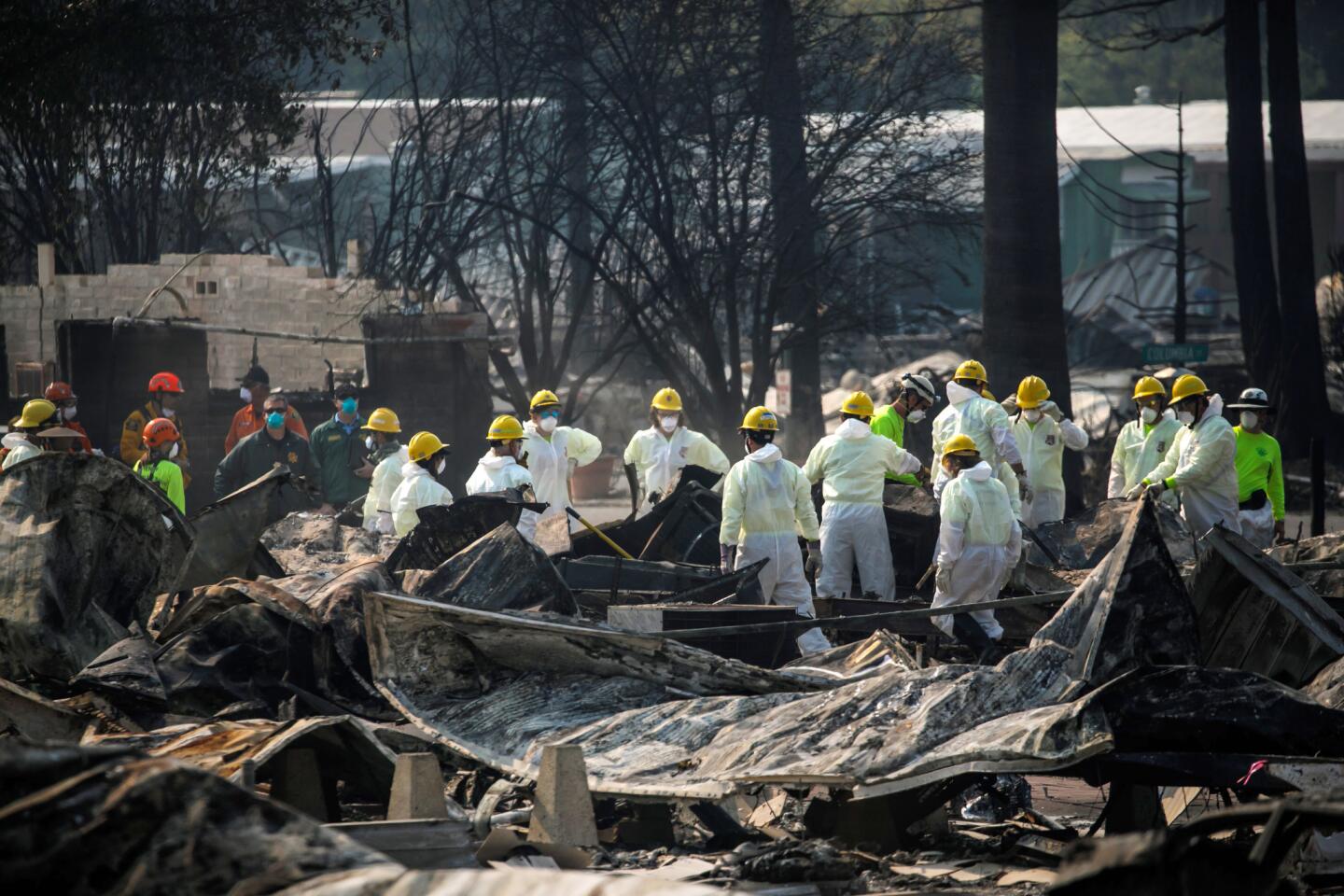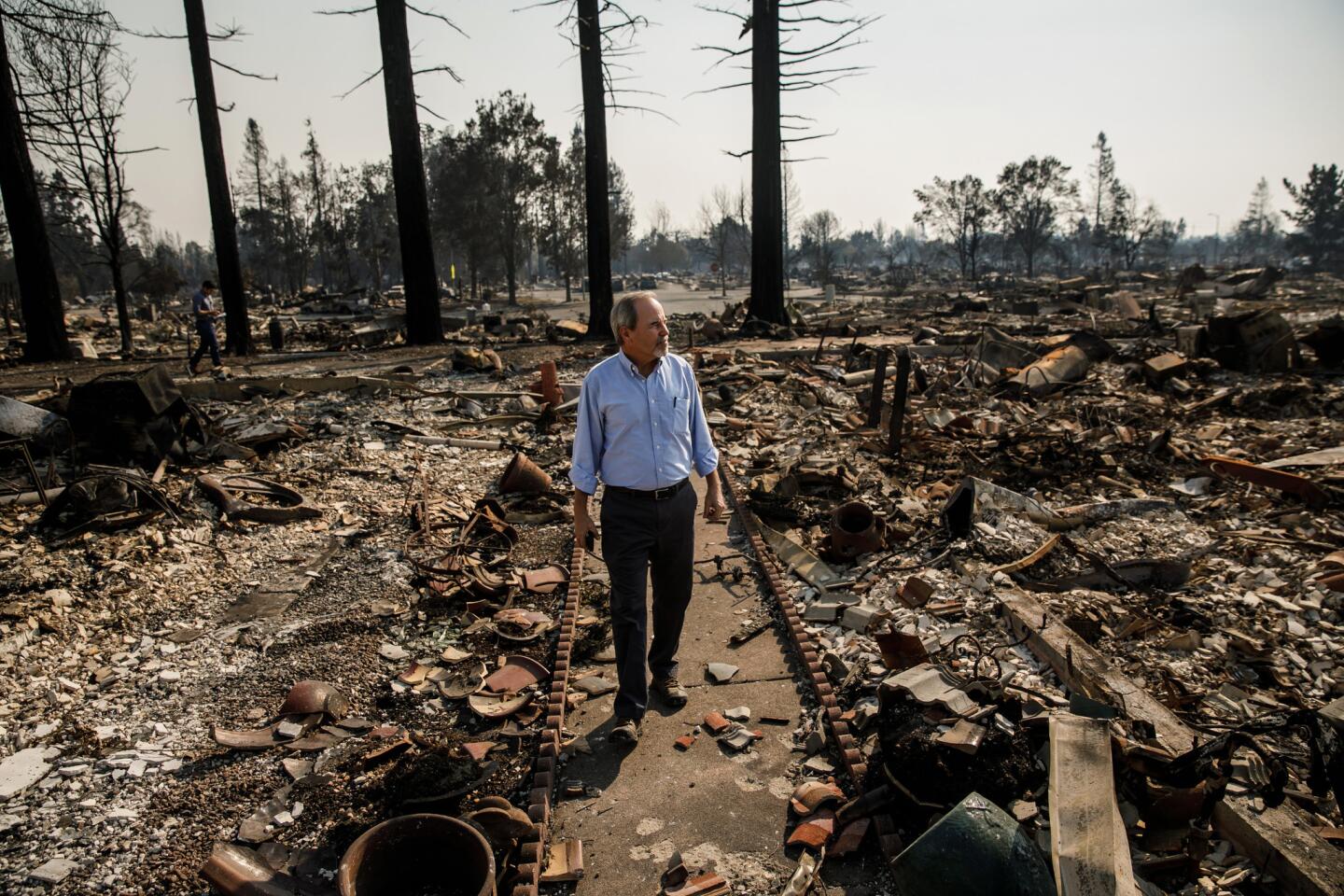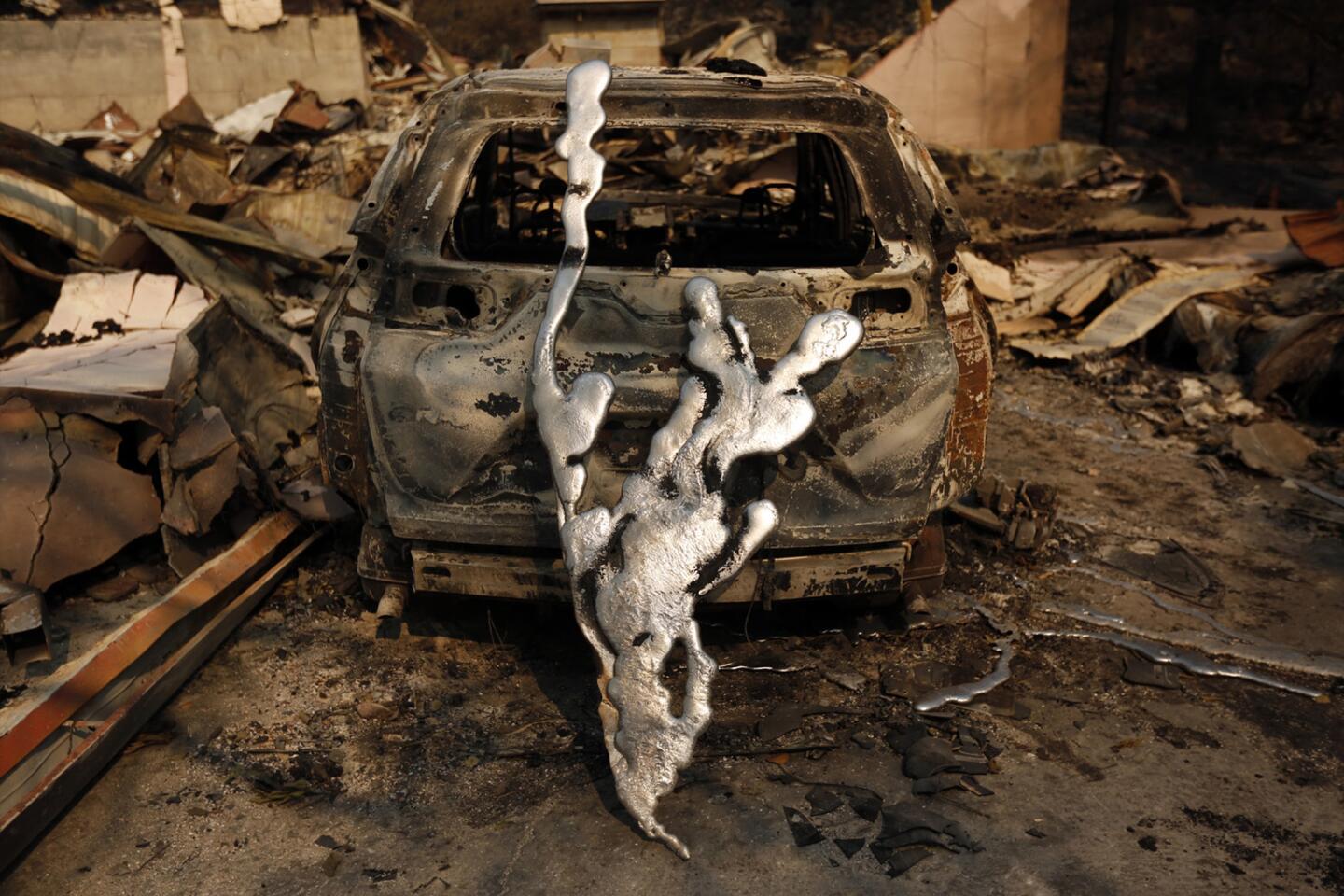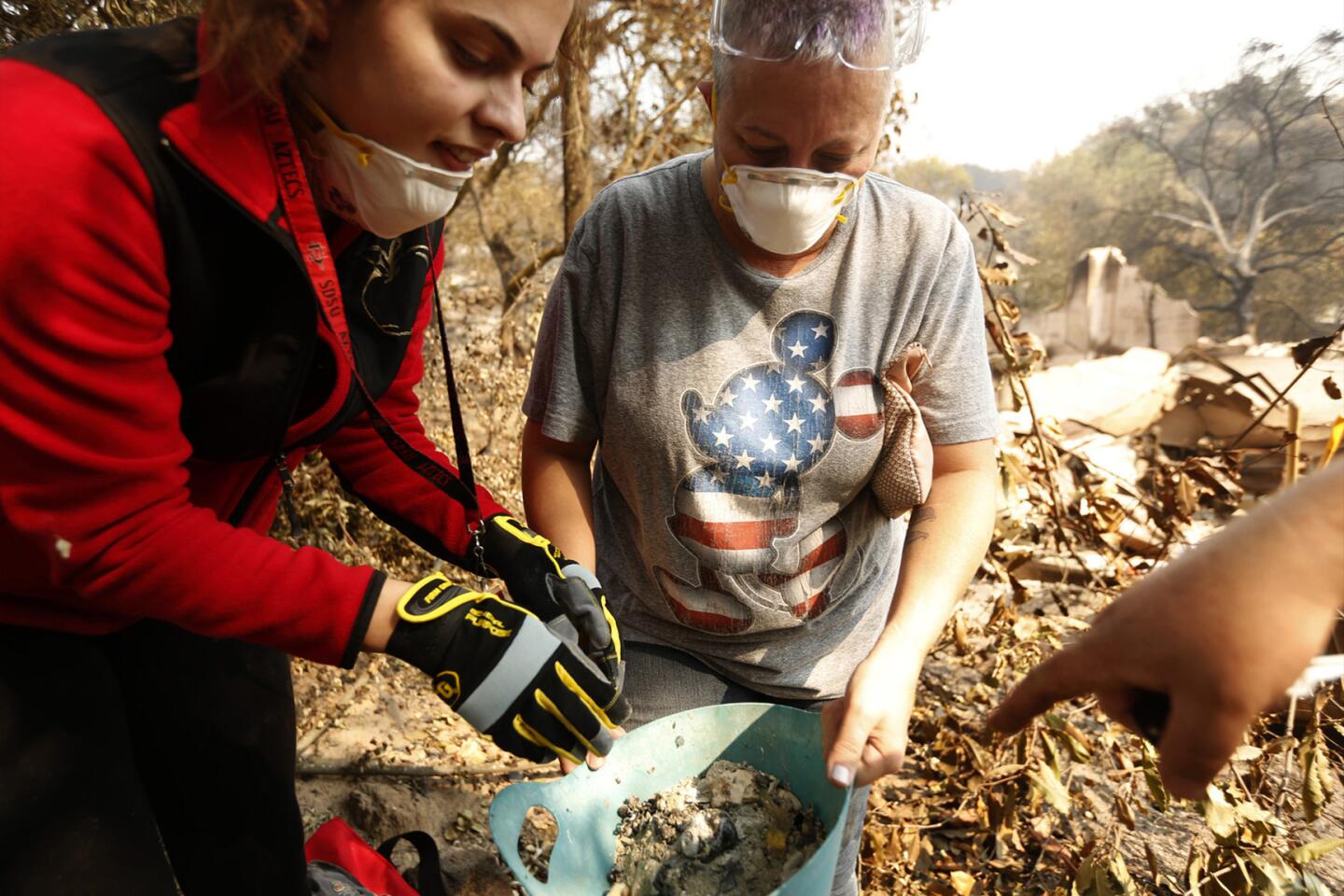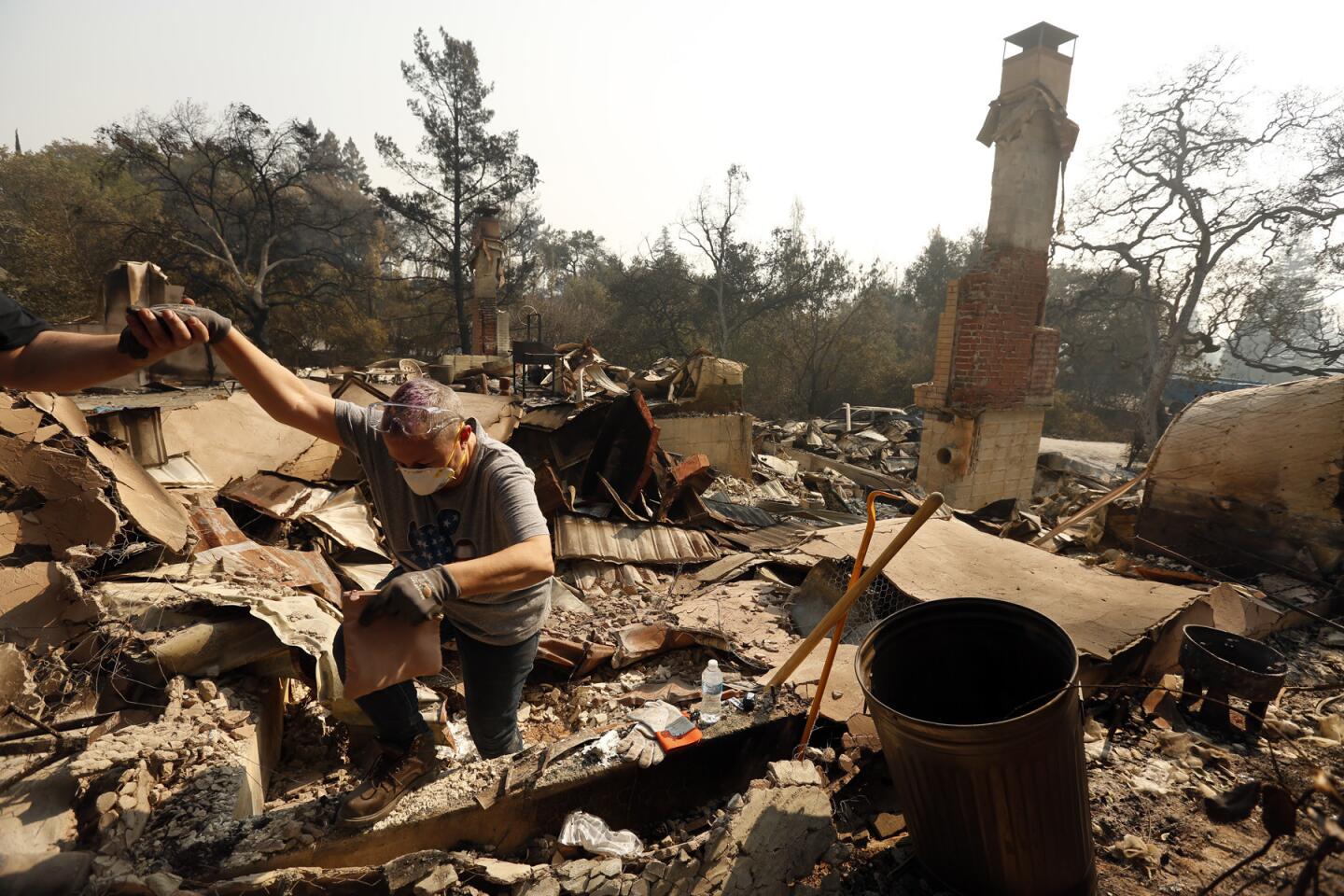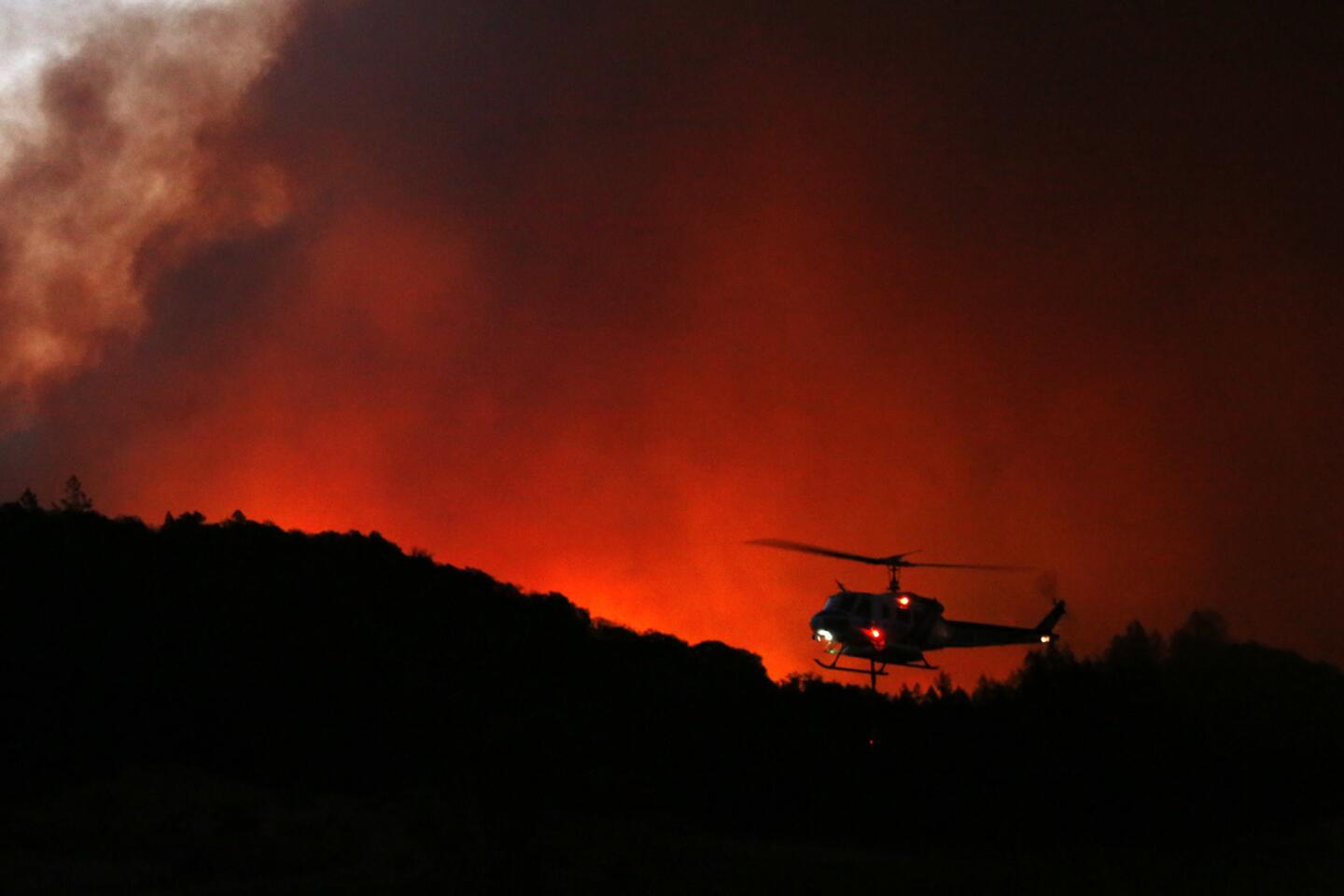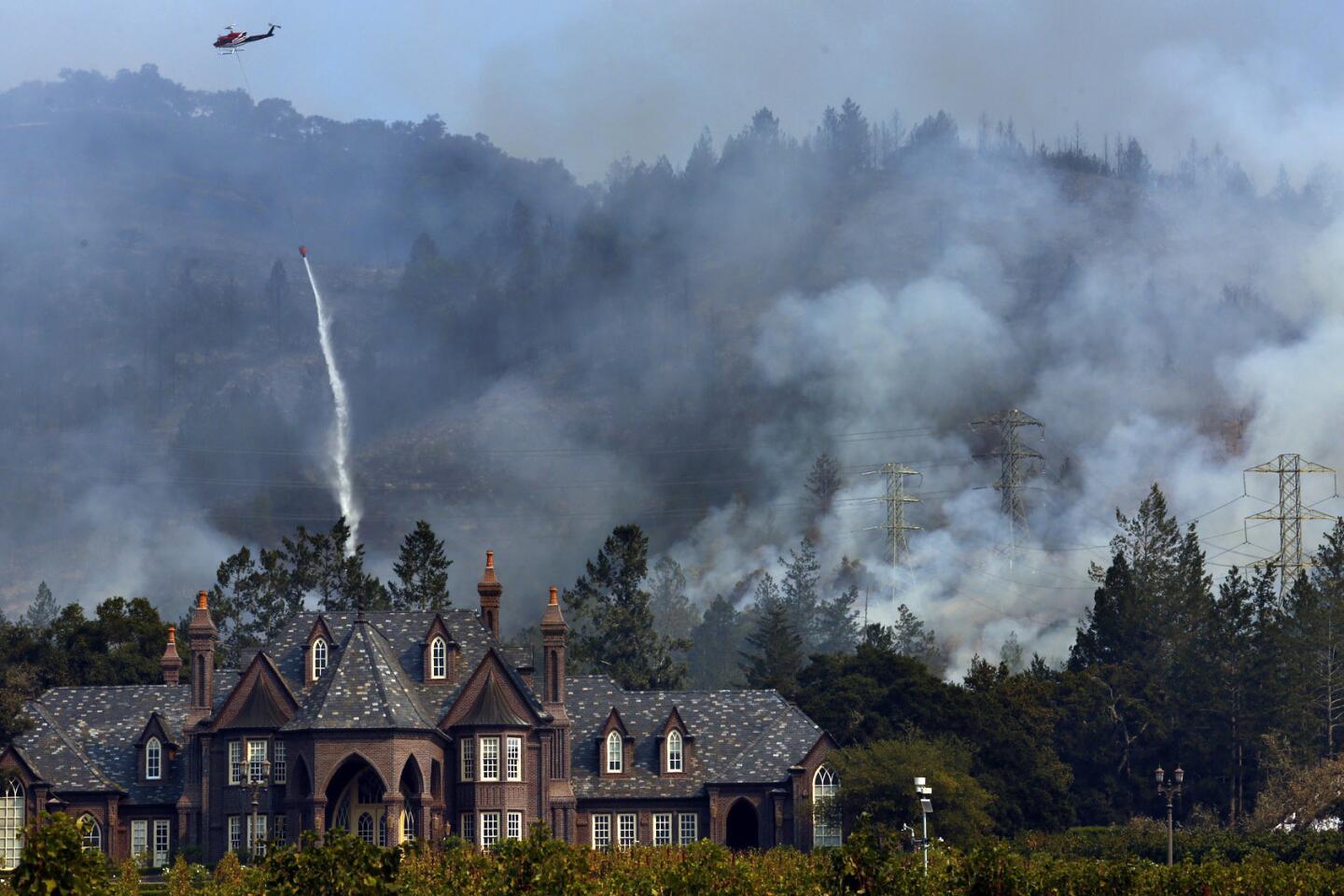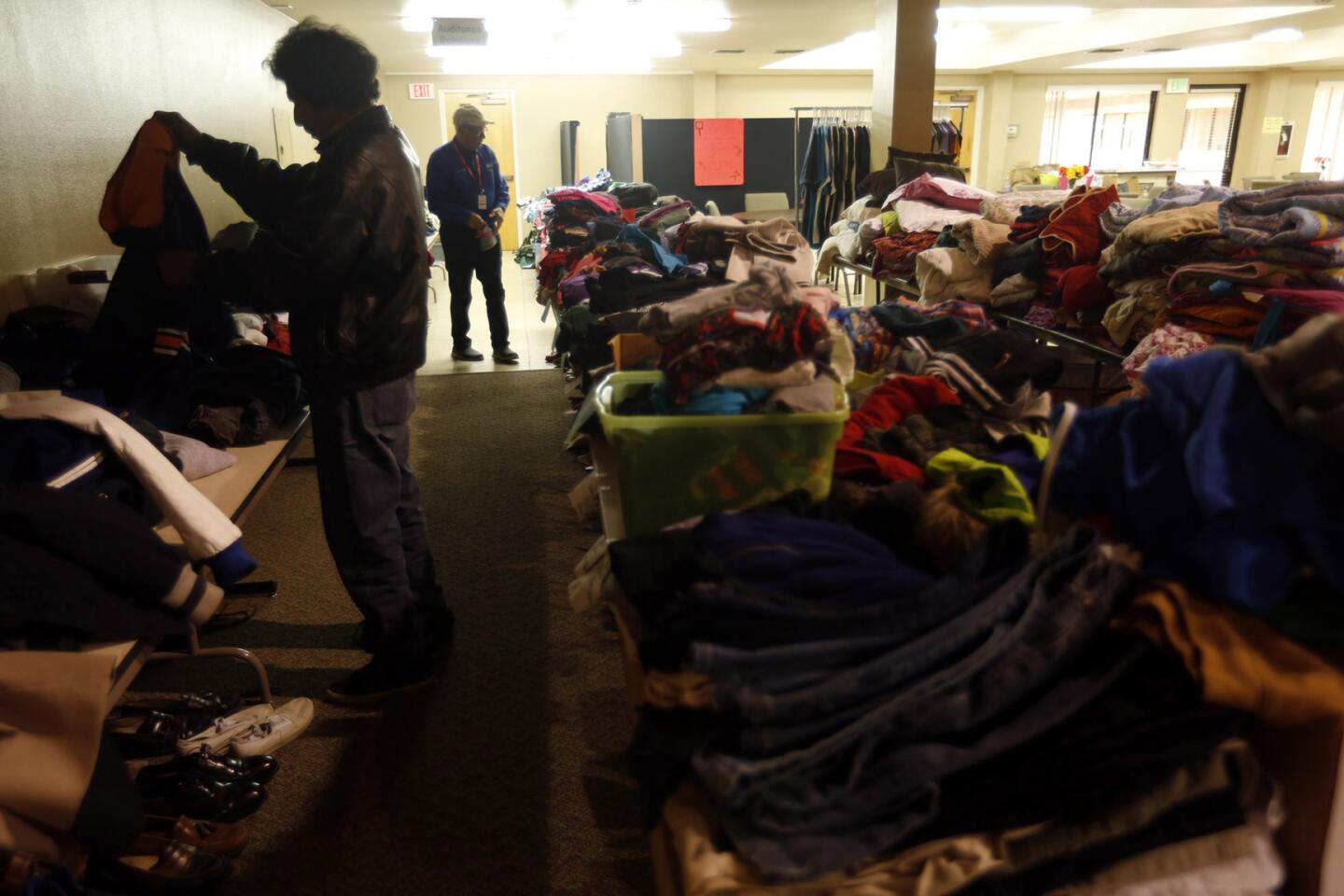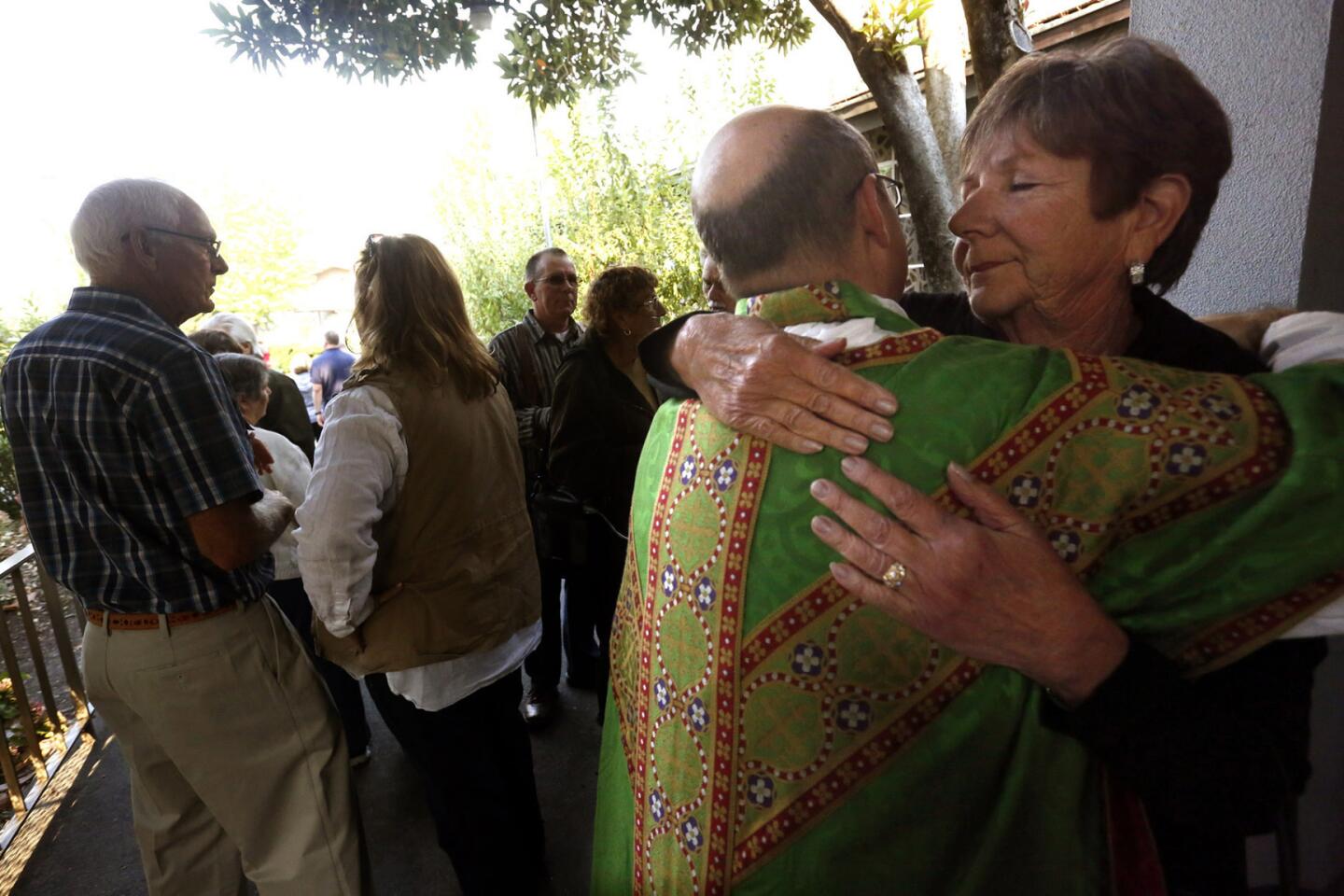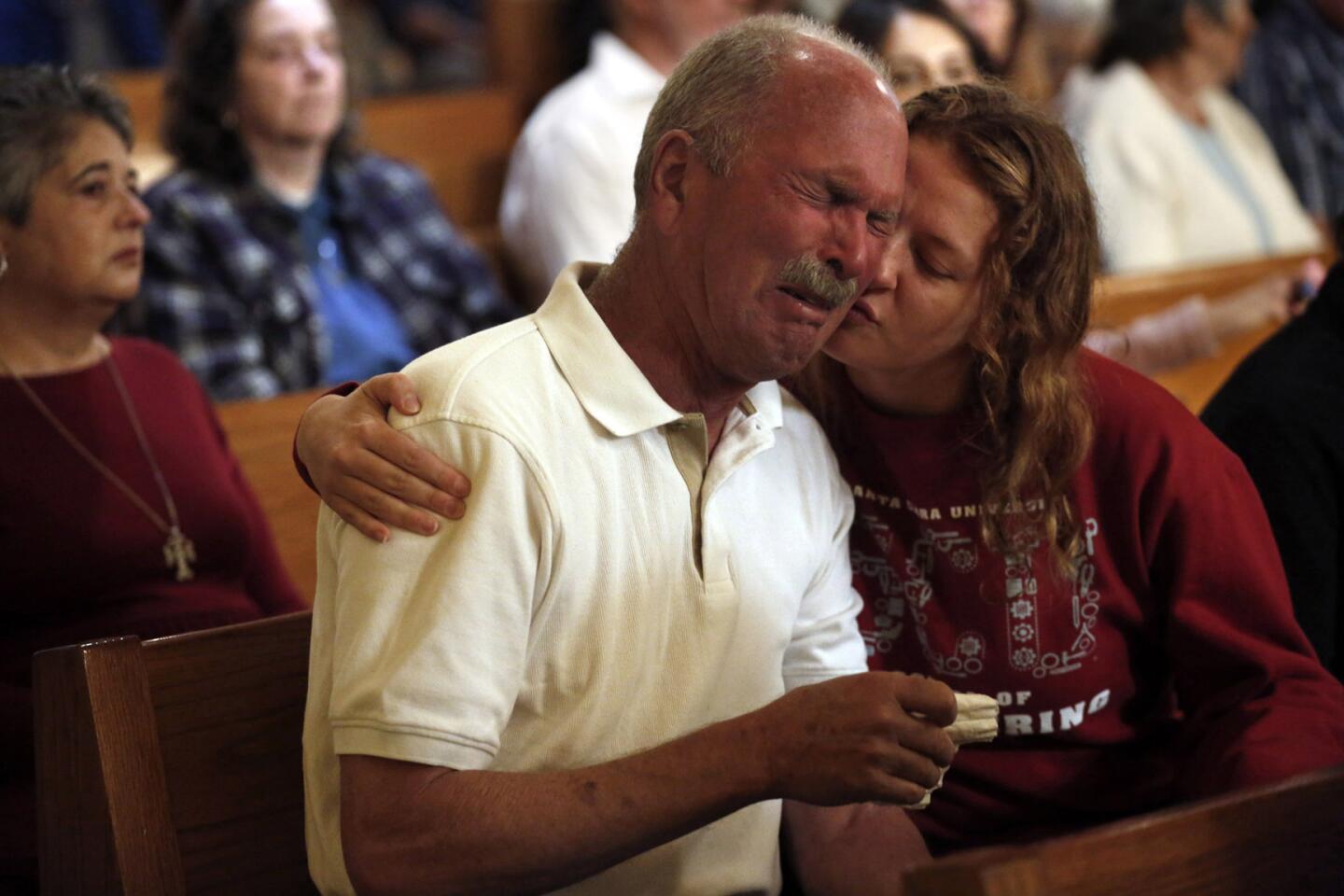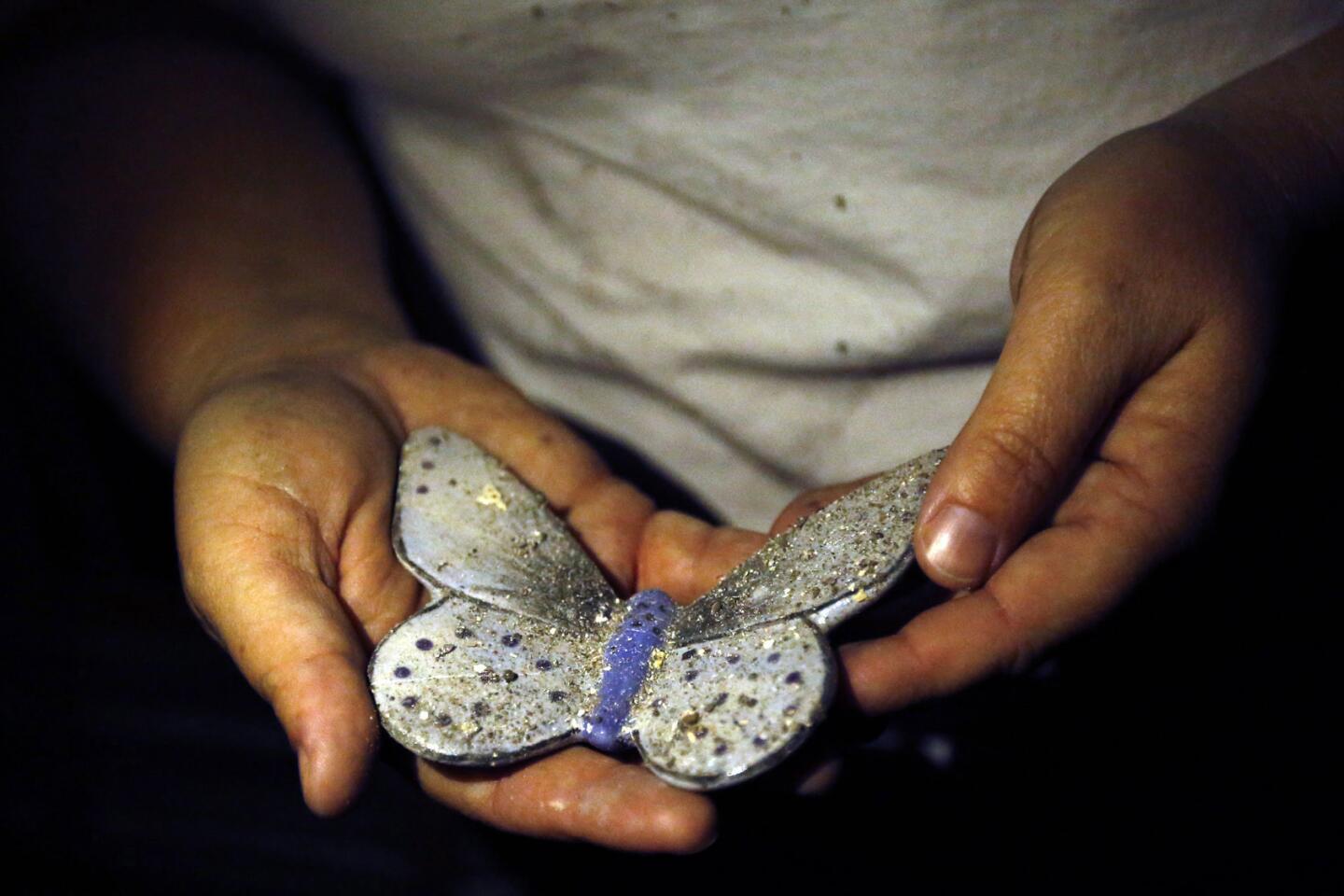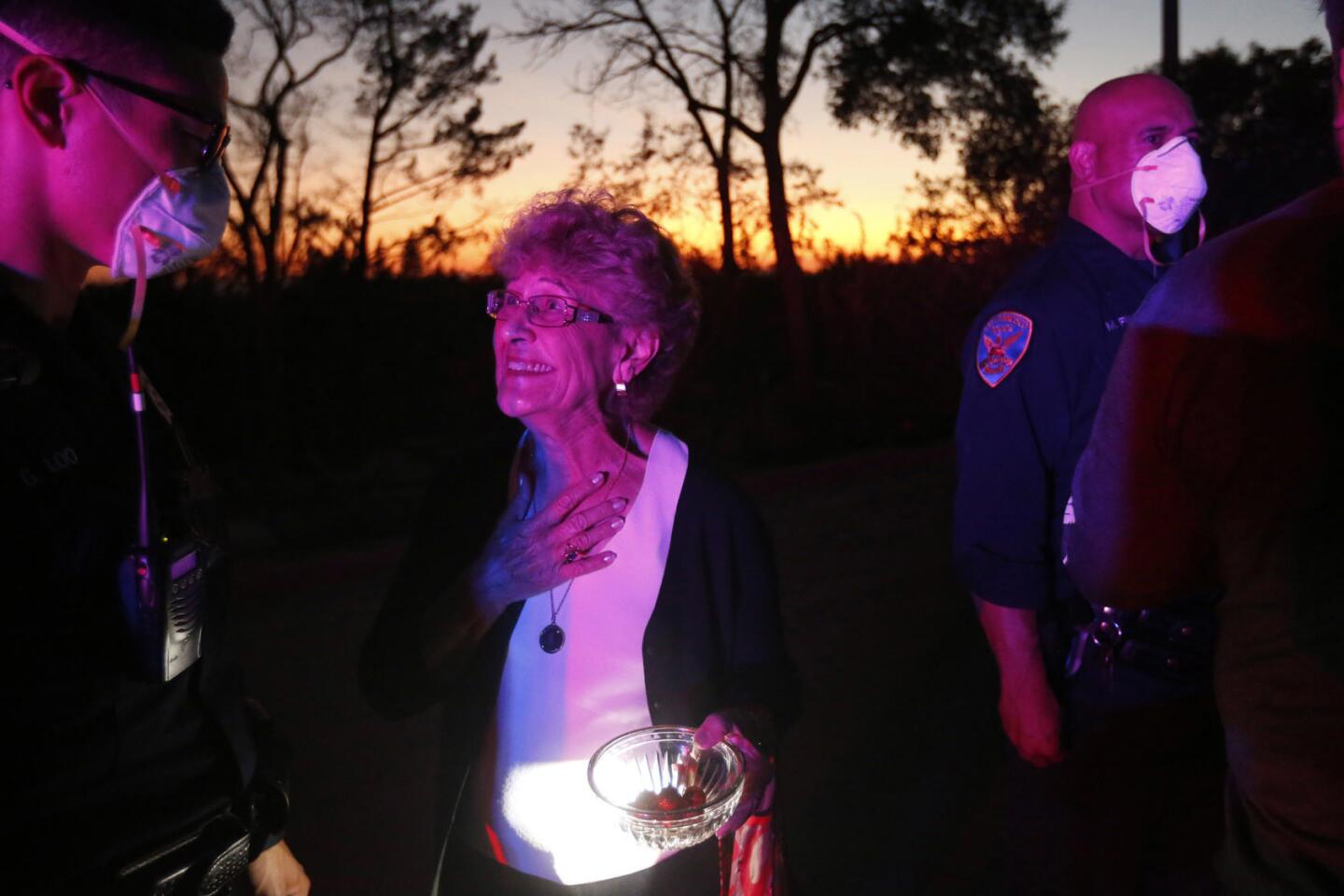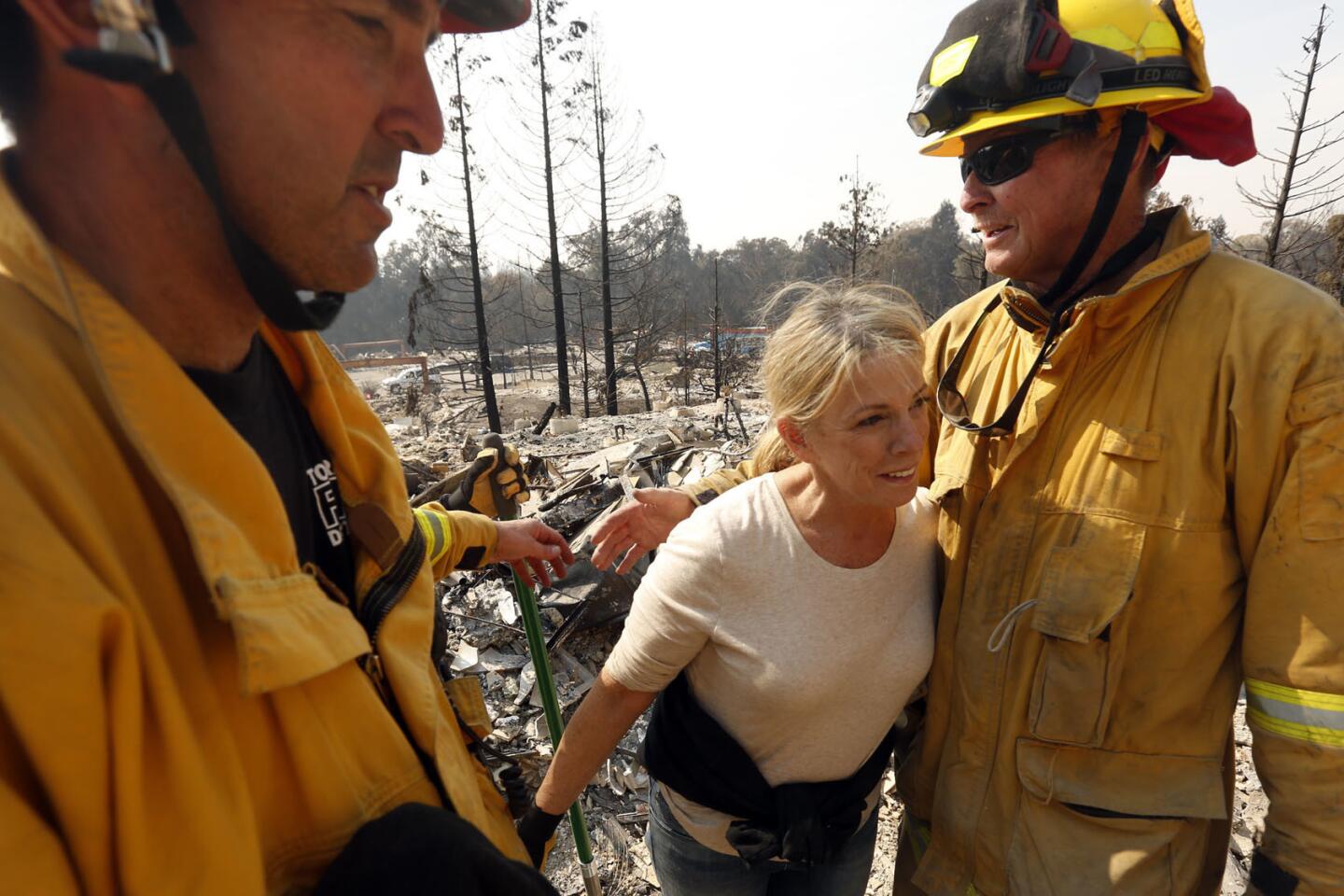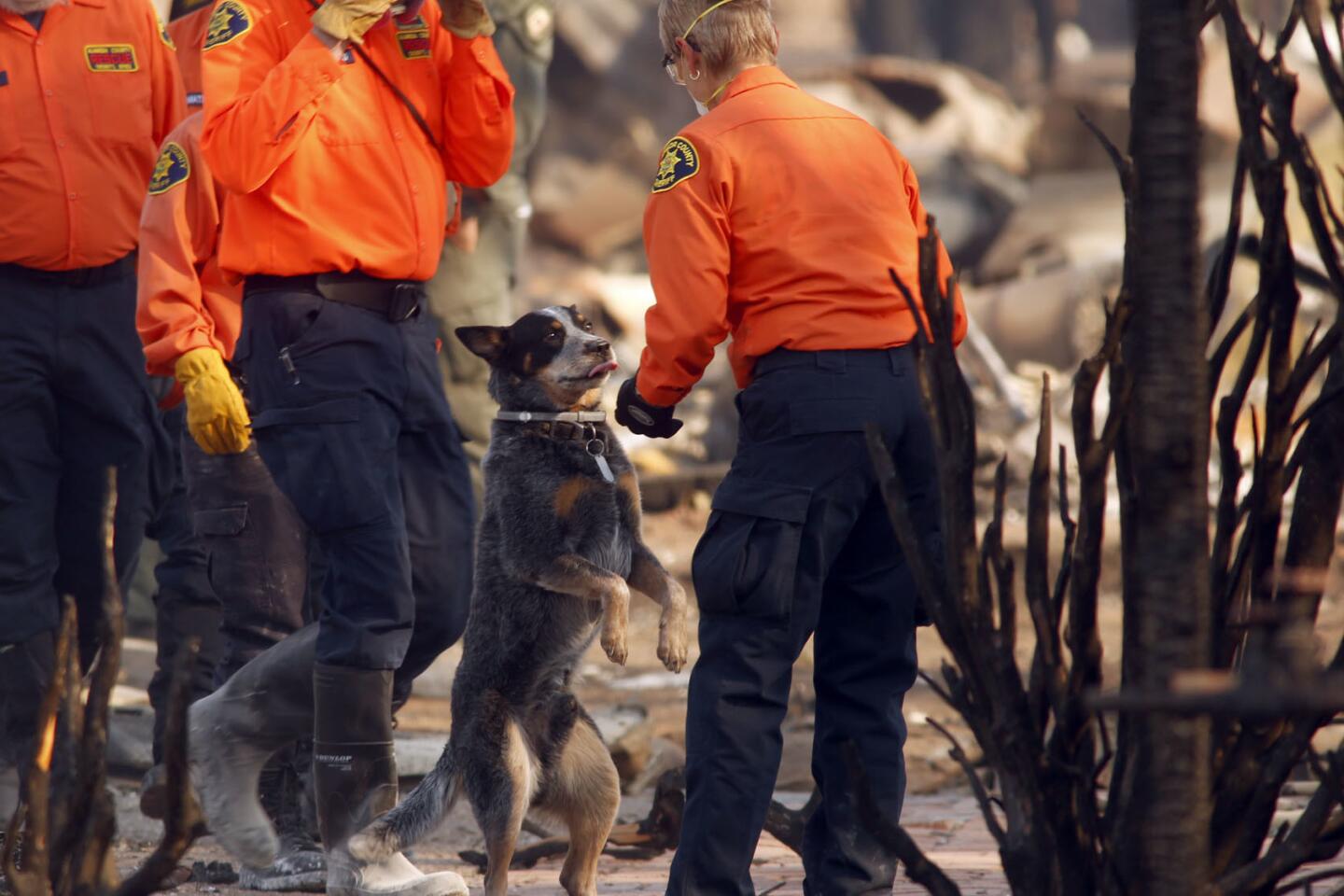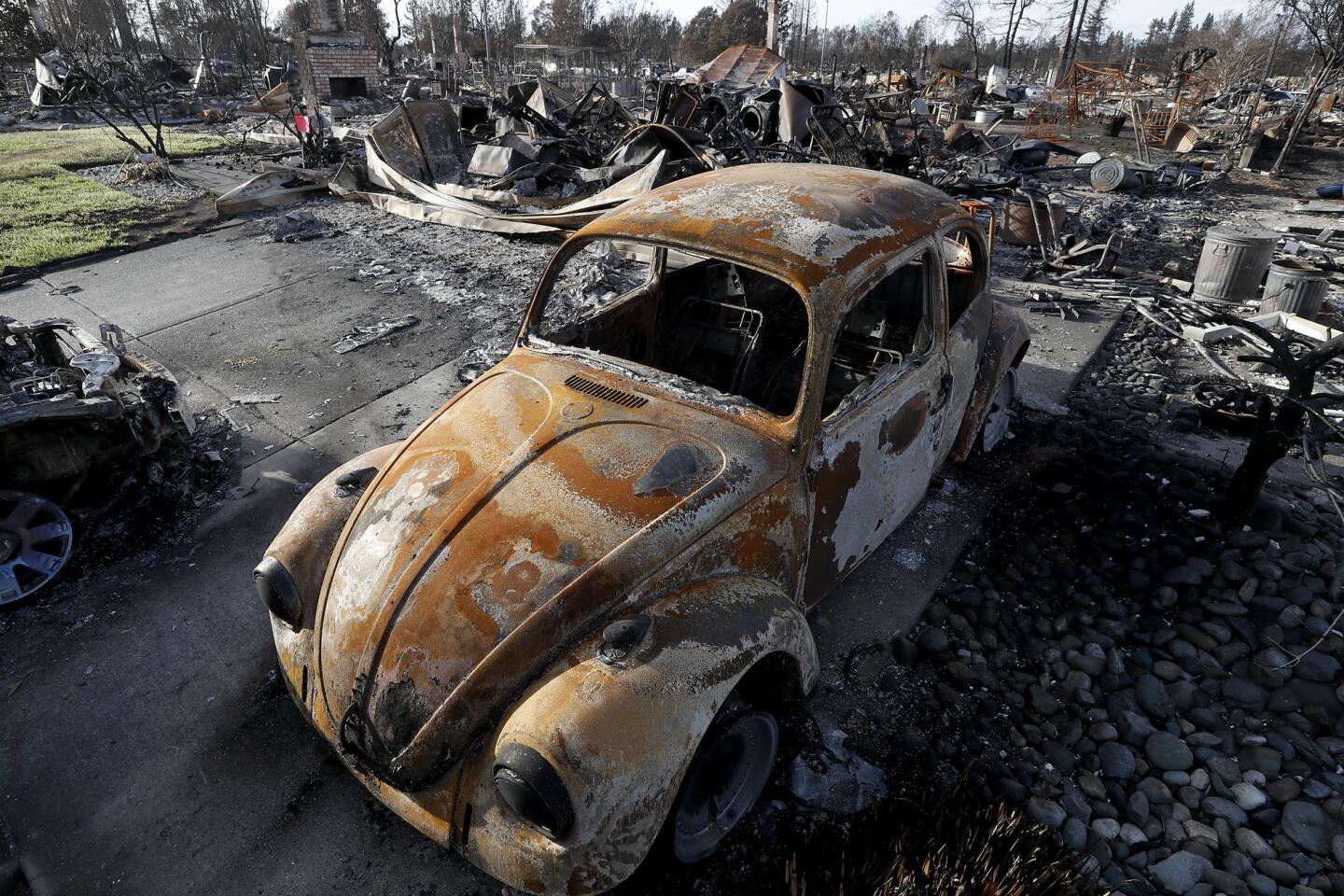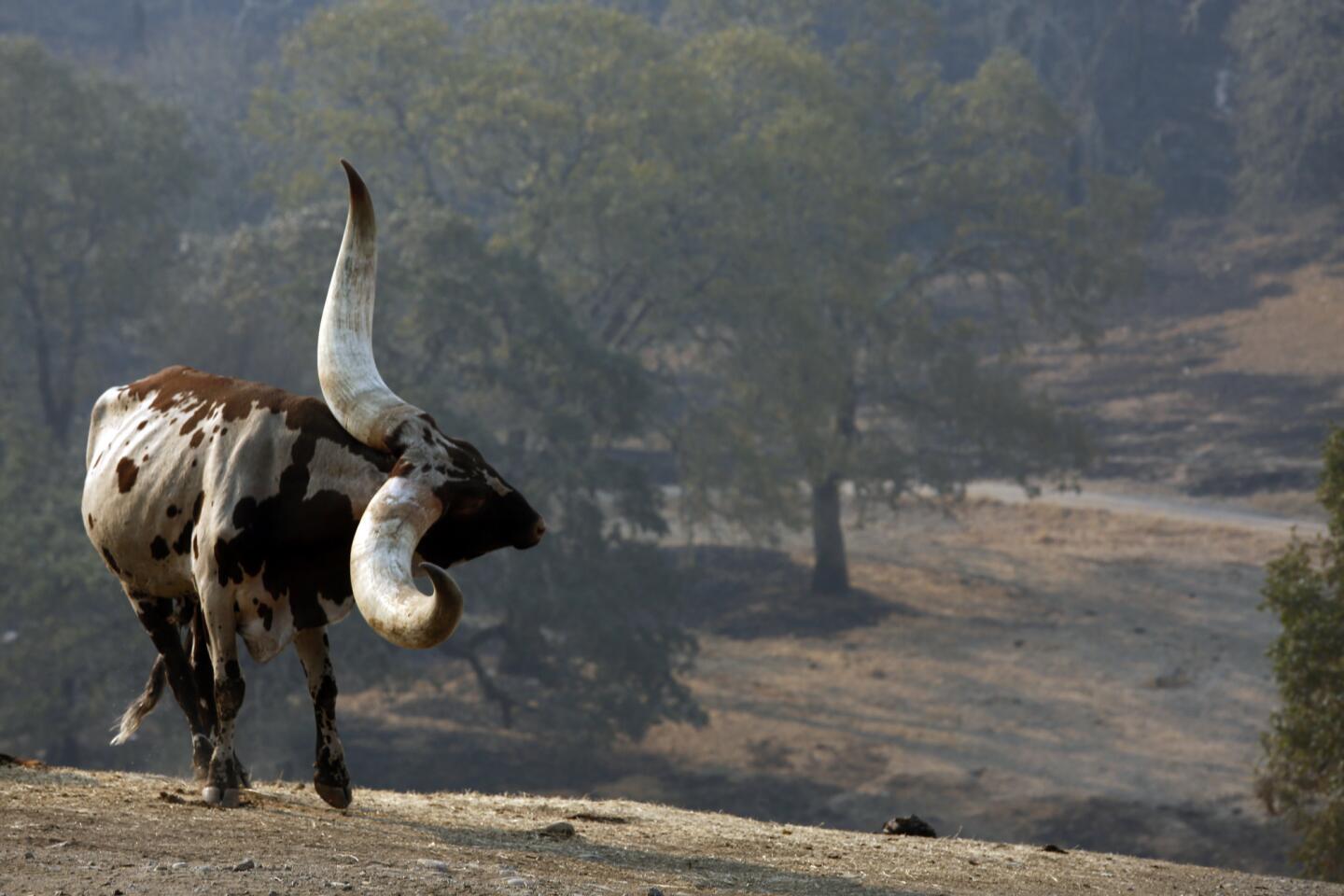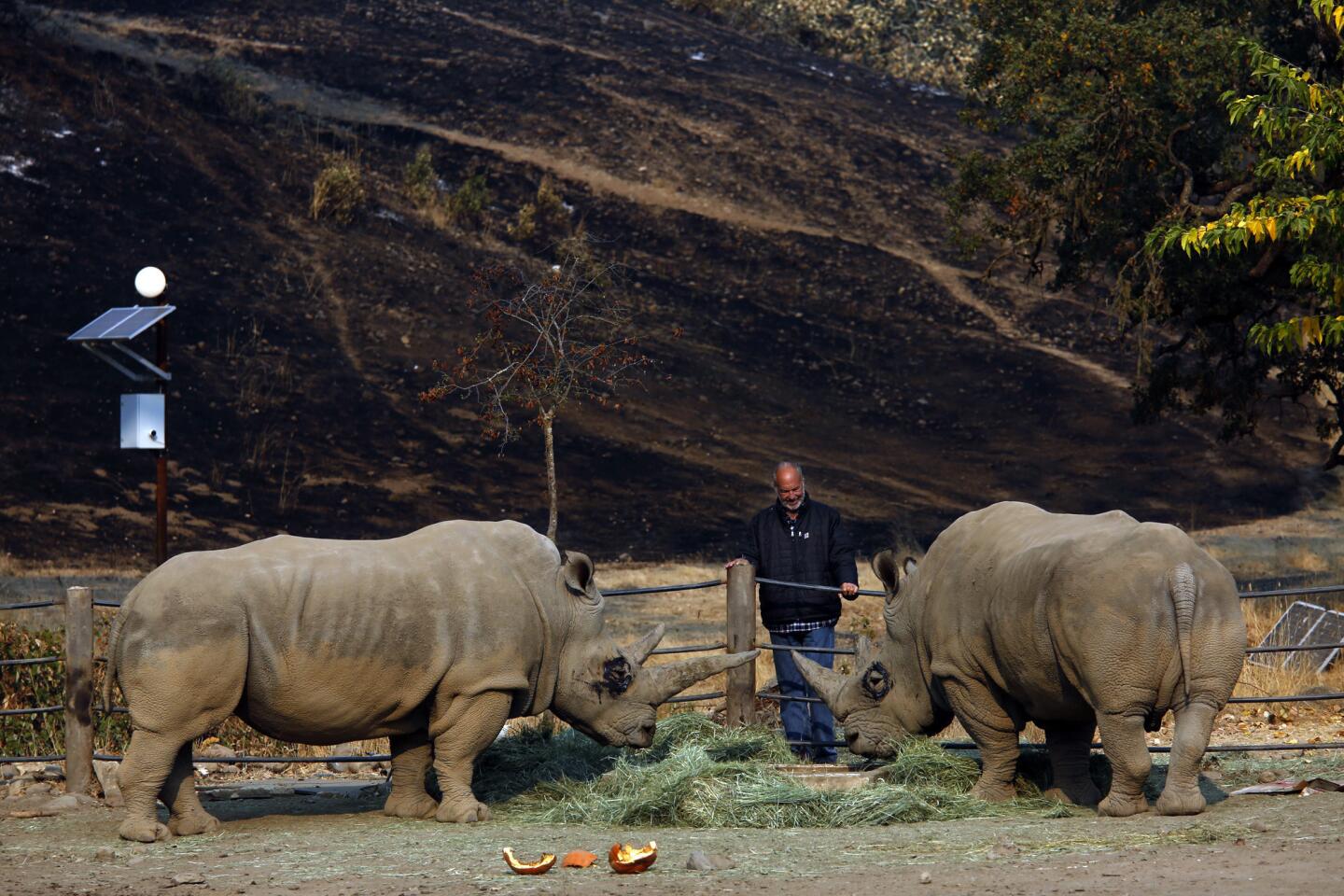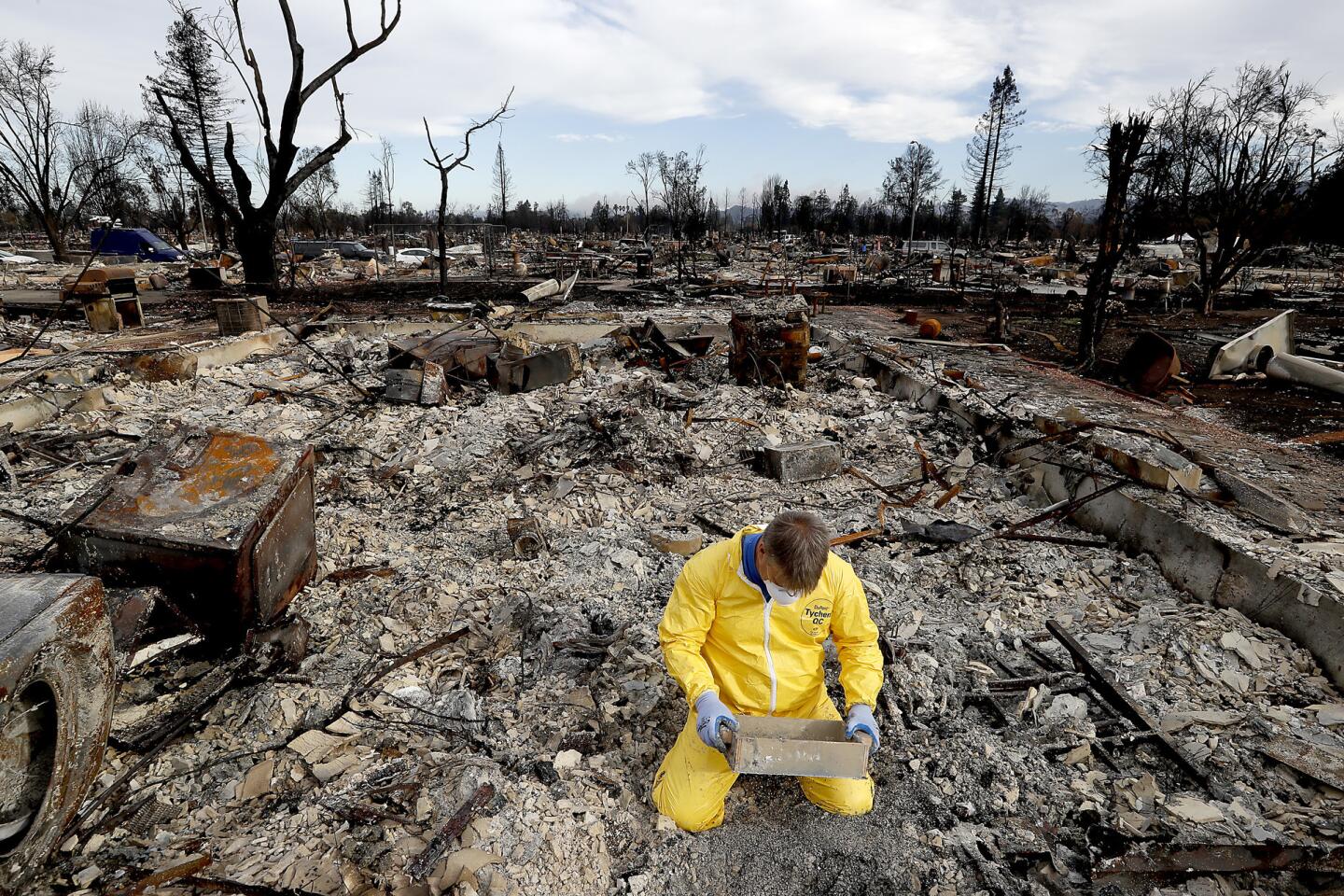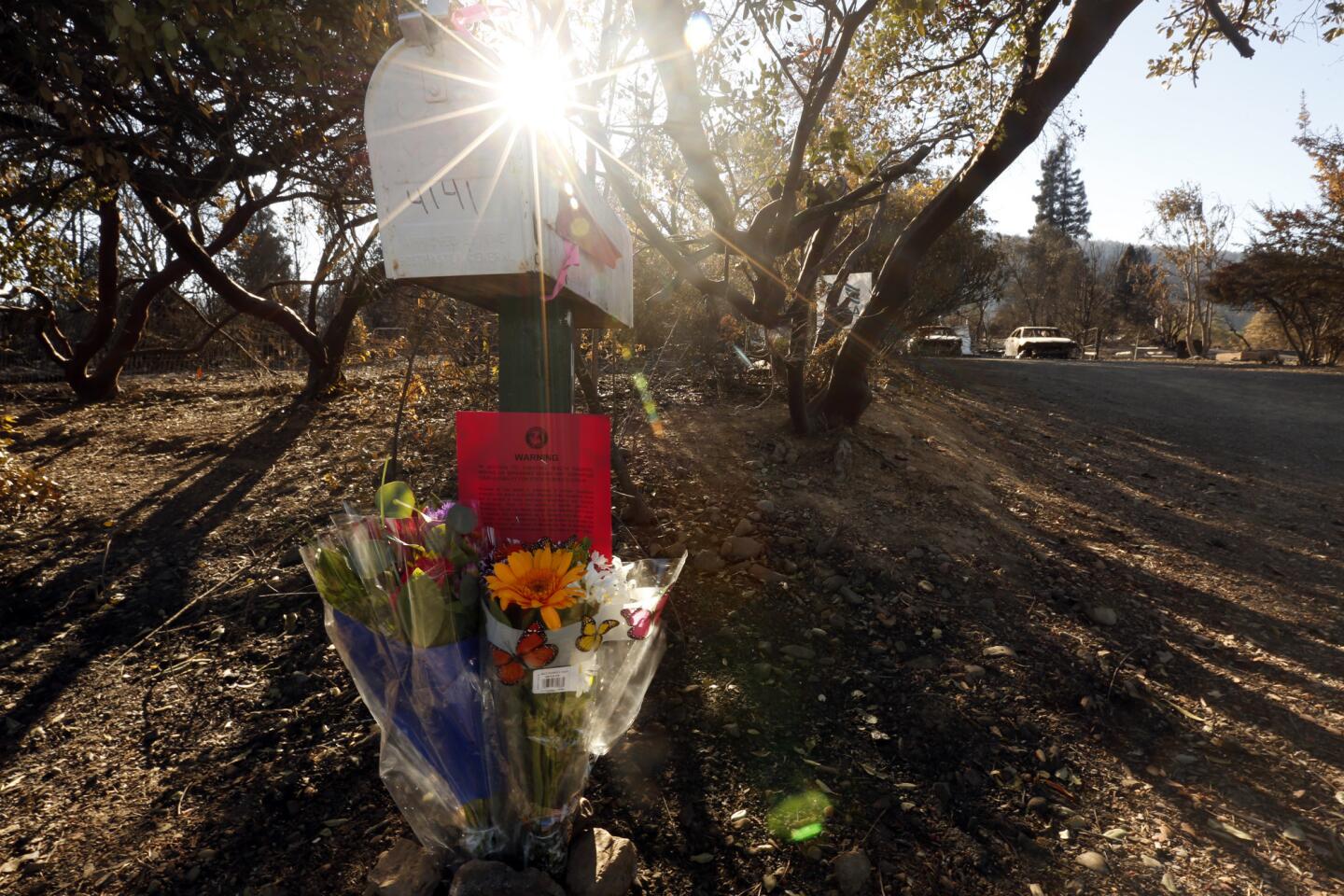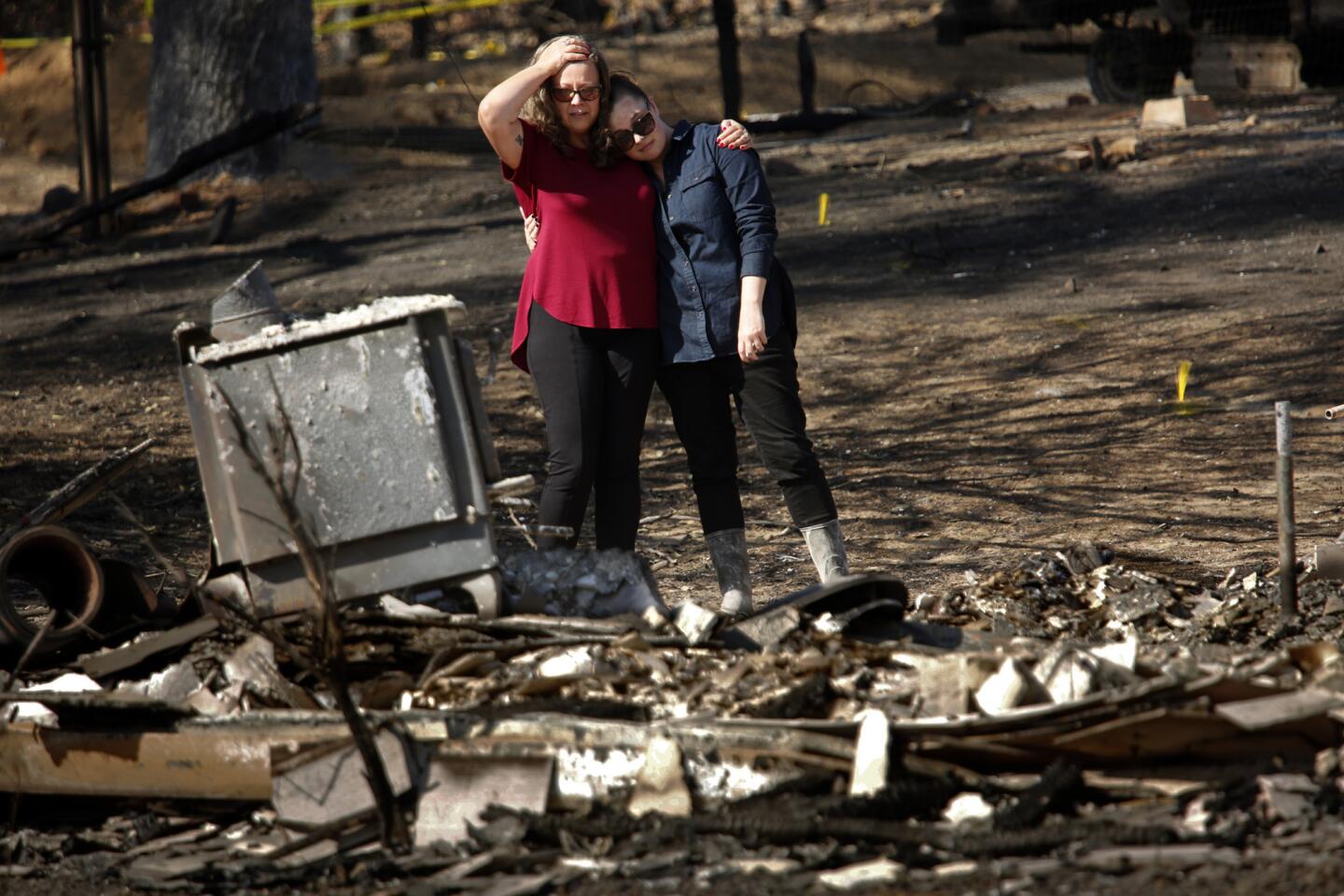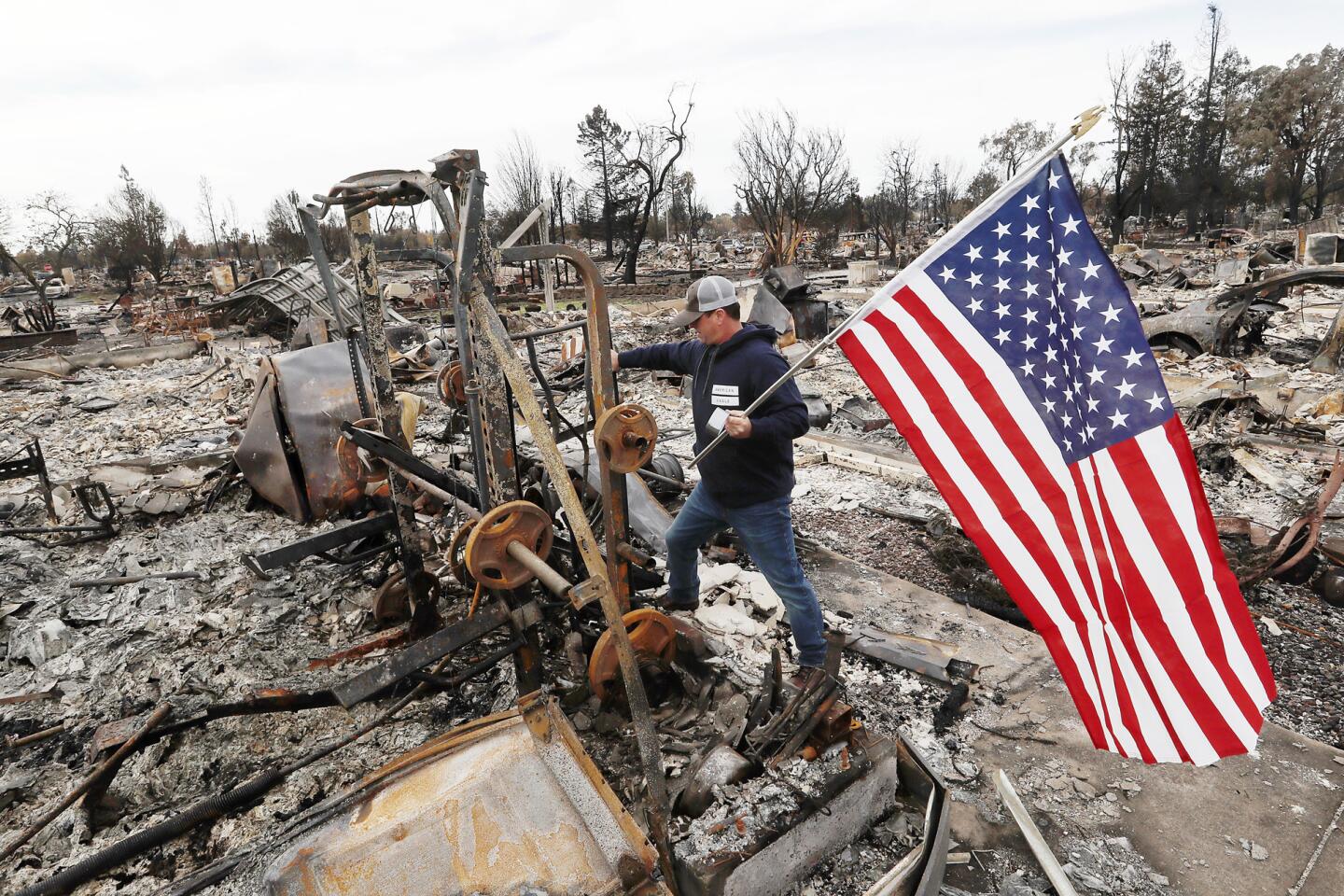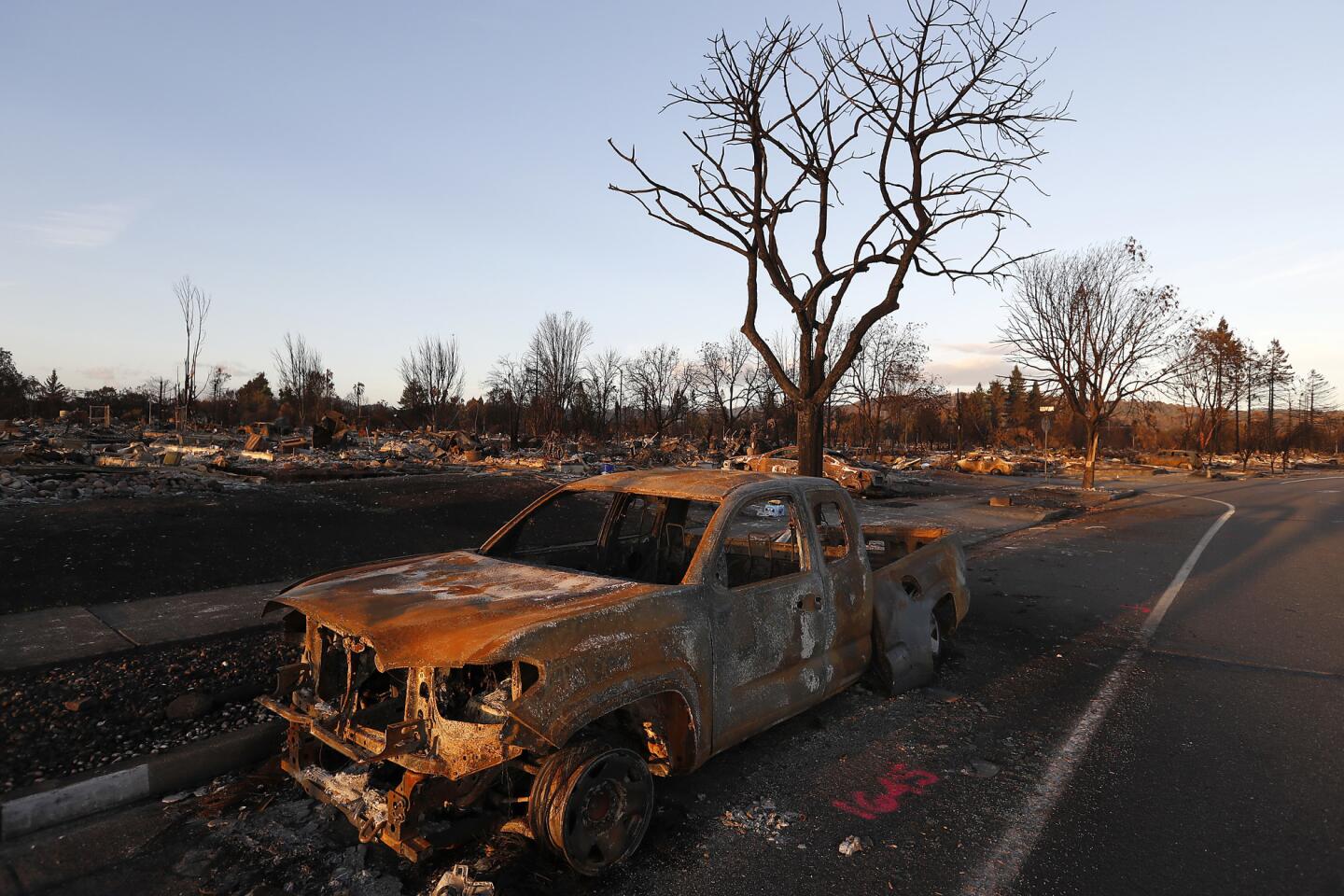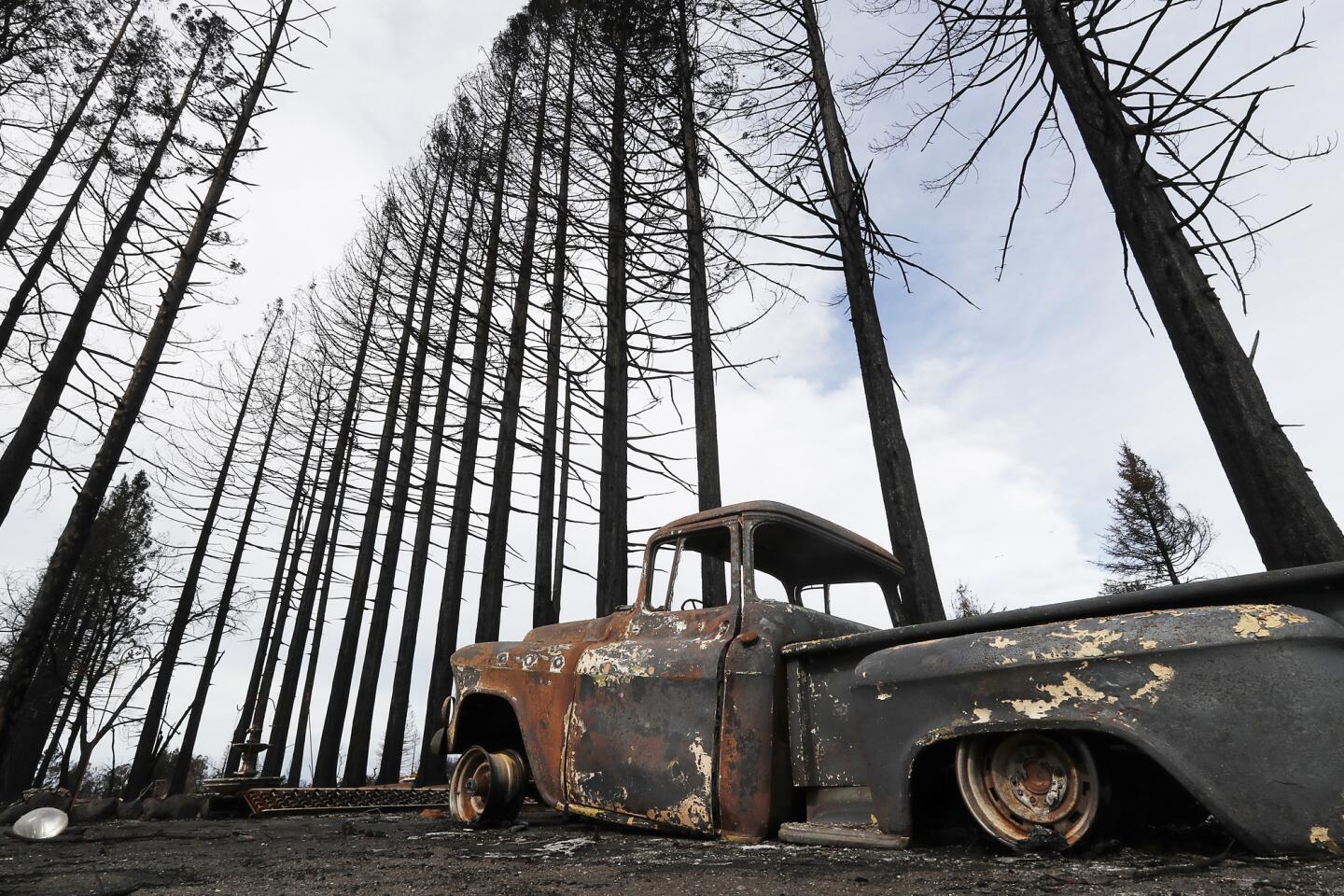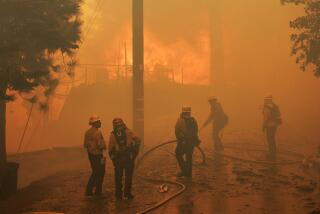As authorities begin to identify those killed in the wildfires raging across Northern California, a grim pattern is emerging.
Among the dozen people identified by Sonoma and Napa county officials as of late Thursday, the average age of those who died was 79. The youngest victim was 57, the oldest 100.
“The bulk of them are in their 70s and 80s, so there is that commonality,” Sonoma County Sheriff Rob Giordano told reporters at a news briefing.
A majority were found inside their homes, unable to escape as the fire bore down. At least one was confined to a wheelchair. Another was lying next to a vehicle.
The trend highlights a risk for elderly people when a natural disaster strikes: Health problems may limit mobility. They may no longer drive, and often live in areas with unreliable cellphone service.
In Sonoma County, where most of the fatalities occurred, 18% of the population is over the age of 62, compared with 11% for all of California.
“With any sort of disaster … the elderly may not have transportation, they may not have access to evacuate as fast as possible,” said Sonoma County spokesman Scott Alonso. “They may be wheelchair-bound, they may have access issues — those folks may take more care to evacuate safely.”
That’s why, he said, police officers were going door-to-door Sunday night alerting people to get out. But he said it’s too early to tell whether the elderly were disproportionately affected.
That was the case two years ago when the fast-moving Valley fire ripped through Lake County and took the lives of four people. They were a 72-year-old woman with multiple sclerosis trapped in her home, and three men over the age of 65, two of whom decided not to evacuate.
The Butte fire that year didn’t spread as quickly, though the two people killed were seniors: a one-legged 65-year-old man who stayed home to protect his property and an 82-year-old man.
A 2008 report criticized disaster response systems in California. The state Department of Social Services subsequently launched functional assessment service teams, which consist of government workers and volunteers who deploy to shelters to observe conditions and identify what’s missing. The teams assess the needs of seniors and those with disabilities, working to get them the services and equipment they need.
On Sunday night when the Atlas fire erupted, Sara and Charles Rippey were home in Napa with their caretaker, Maria Sandovar. Strong winds made the lights flicker. Sandovar looked out the back window and saw that the home’s fence was on fire.
She ran to lift Sara, 98, out of bed and onto her wheelchair. Charles, 100, was in the hallway.
“What’s going on?” he asked.
In a matter of minutes, black smoke had filled the house.
1/59
An inmate firefighter monitors flames as a house burns in the Napa wine region.
(Josh Edelson / AFP/Getty Images) 2/59
Flames ravage a home in the Napa wine region in California.
(Josh Edelson / AFP/Getty Images) 3/59
A firefighter walks near a pool as a neighboring home burns in the Napa wine region.
(Josh Edelson / AFP/Getty Images) 4/59
Firefighters douse flames as a home burns in the Napa wine region, as multiple wind-driven fires whip through the region.
(Josh Edelson / AFP/Getty Images) 5/59
Louis Reavis views the burned remains of his classic Oldsmobile at his home in Napa.
(Josh Edelson / AFP/Getty Images) 6/59
A tent structure built for the 2017 Safeway Open burns in Napa on Monday.
(Josh Edelson / AFP/Getty Images) 7/59
The Estancia Apartment Homes on Old Redwood Hwy. were completely destroyed in Santa Rosa.
(Brian van der Brug / Los Angeles Times) 8/59
A resident rushes to save his home as a wildfire moves through Glen Ellen, Calif. Tens of thousands of acres and dozens of homes and businesses have burned in wildfires in Napa and Sonoma counties.
(Justin Sullivan / Getty Images) 9/59
A Fountaingrove Village man surveys the rubble of his home in Santa Rosa.
(Brian van der Brug / Los Angeles Times) 10/59
Downed power poles and lines block a street in Hidden Valley.
(Brian van der Brug / Los Angeles Times ) 11/59
A fcar burns in the driveway of a destroyed home in Fountaingrove Village.
(Brian van der Brug / Los Angeles Times) 12/59
A wheelchair left abandoned at the evacuated Villa Capri assisted living facility on Fountaingrove Parkway in Santa Rosa.
(Brian van der Brug / Los Angeles Times ) 13/59
A resident rushes to save his home as fire moves through the area in Glen Ellen, California.
(Justin Sullivan / Getty Images) 14/59
A San Jose firefighter keep flames down at a home in Hidden Valley.
(Brian van der Brug / Los Angeles Times) 15/59
A Fountaingrove Village couple takes in the ruins of their home after fire ripped through the neighborhood.
(Brian van der Brug / Los Angeles Times) 16/59
A home destroyed in the fast moving wildfire that ripped through Glen Ellen.
(Marcus Yam / Los Angeles Times) 17/59
A swimming pool reflects the damage caused by the wildfires that moved through neighborhoods near Glen Ellen.
(Marcus Yam / Los Angeles Times) 18/59
Benicia Police Officer Alejandro Maravilla, left, offers resident Gwen Adkins, 84, a soda while patrolling in the Coffey Park neighborhood of Santa Rosa.
(Brian van der Brug / Los Angeles Times) 19/59
Spencer Blackwell, left, and Danielle Tate find Tate’s father’s gun collection, melted and burned, inside a gun safe at her father’s home in the Coffey Park neighborhood of Santa Rosa.
(Brian van der Brug / Los Angeles Times ) 20/59
An American flag is draped on a burned pickup truck on Camino del Prado in the Coffey Park neighborhood in Santa Rosa.
(Brian van der Brug / Los Angeles Times ) 21/59
Scorched wine barrels at the Paradise Ridge Winery in Santa Rosa after the wildfire burned through.
(Marcus Yam / Los Angeles Times) 22/59
Fire lights up the night sky framed by a vineyard near Kenwood.
(Marcus Yam / Los Angeles Times) 23/59
Oakland police officers knock on doors as residents of the Rancho de Calistoga mobile home park are told to evacuate in Calistoga.
(Brian van der Brug / Los Angeles Times) 24/59
An aerial view of the Coffey Park neighborhood detroyed by wildfire in Santa Rosa.
(Marcus Yam / Los Angeles Times ) 25/59
Contra Costa paramedics help Bill Parras, 96, evacuate his home in Calistoga.
(Brian van der Brug / Los Angeles Times ) 26/59
CHP officers study neighborhood maps before going door to door to tell Sonoma residents to voluntarily evacuate ahead of the wildfire.
(Marcus Yam / Los Angeles Times) 27/59
A home perched on top of a hill sits in the foreground of a fire moving up on Shiloh Ridge near Santa Rosa.
(Marcus Yam / Los Angeles Times ) 28/59
Scorched grapes and vines along the edge of Storybook Mountain Vineyards in Calistoga.
(Brian van der Brug / Los Angeles Times) 29/59
John and Jan Pascoe survived the firestorm by running out of their home and into their neighbors’ swimming pool in Santa Rosa.
(Brian van der Brug / Los Angeles Times) 30/59
Hundreds of burned wine bottles at the destroyed Helena View Johnston Vineyards near Calistoga.
(Brian van der Brug / Los Angeles Times) 31/59
A Contra Costa County firefighter breaks a wall with an ax as his crew battles flames inside a home along Highway 29 north of Calistoga on Oct. 12.
(Marcus Yam / Los Angeles Times) 32/59
Atascadero Firefighters try to control flames burning inside a home along Highway 29 in Calistoga on Oct. 12.
(Marcus Yam / Los Angeles Times) 33/59
Contra Costa firefighters work to put out flames burning inside a home along Highway 29 north of Calistoga on Oct. 12.
(Marcus Yam / Los Angeles Times) 34/59
Search teams sift through the debris of mobile homes at the Journey’s End Mobile Home Park in Santa Rosa.
(Marcus Yam / Los Angeles Times ) 35/59
A worker pulls out a firearm from the burned wreckage as search team members look through the debris at the Journey’s End Mobile Home Park in Santa Rosa.
(Marcus Yam / Los Angeles Times) 36/59
Search team members sift through debris at the Journey’s End Mobile Home Park in Santa Rosa.
(Marcus Yam / Los Angeles Times) 37/59
Santa Rosa Mayor Chris Coursey surveys the damage to the Coffey Park neighborhood.
(Marcus Yam / Los Angeles Times ) 38/59
Melted metal is seen on a car in the shadow of a destroyed home in Napa.
(Genaro Molina / Los Angeles Times) 39/59
Lola Cornish, 50, and her daughter Kat Corazza, 18, look over recovered family jewels that survived the fire at Cornish’s grandfather’s home in Napa.
(Genaro Molina / Los Angeles Times) 40/59
Some residents were allowed to return to their properties Friday in a neighborhood in Napa that was ravaged by the Atlas fire.
(Genaro Molina / Los Angeles Times) 41/59
A helicopter prepares to drop water on a fire that threatens the Oakmont community along Highway 12 in Santa Rosa.
(Genaro Molina / Los Angeles Times) 42/59
A helicopter drops water on a fire that threatens the Ledson Winery and Historic Castle Vineyards in Kenwood on Friday.
(Genaro Molina / Los Angeles Times) 43/59
Manuel Mendoza sorts through donated clothing at the Bridge Church in Santa Rosa on Sunday.
(Genaro Molina / Los Angeles Times) 44/59
Jean Schettler hugs Father Moses Brown after Mass at St. Rose Church on Sunday. Schettler’s daughter, son-in-law and grandchildren, after losing their house in the fires, have moved into the Santa Rosa home of Jean and Jim Schettler.
(Genaro Molina / Los Angeles Times) 45/59
Gianna Gathman, 18, hugs her grandfather Jim Schettler during Mass at St. Rose Church in Santa Rosa on Sunday. Gathman’s family lost their home in the Fountaingrove neighborhood to the fire. They are now living with the Schettlers.
(Genaro Molina / Los Angeles Times) 46/59
Kimberly Flinn holds onto the only item that wasn’t lost in a fire that destroyed her home in the Mark West Springs area in Santa Rosa. Flynn recovered a ceramic white butterfly that she had made in memory of a boy she used to babysit and was killed in a hit and run accident.
(Genaro Molina / Los Angeles Times) 47/59
Gerry Miller, 81, tells San Francisco Police Department Officer Gary Loo how grateful she is to find her home still standing. Residents were allowed to return to their homes in the Mark West Springs area in Santa Rosa Sunday night.
(Genaro Molina / Los Angeles Times) 48/59
Denise Finitz, 61, thanks Torrance Fire Department firefighters Keith Picket, right, and Capt. Mike Salcido on Oct. 16 after they helped her find her mother’s wedding ring in the ashes of her home, destroyed by wildfires on Carriage Lane in Wikiup.
(Genaro Molina / Los Angeles Times) 49/59
A search and rescue crew member gives a cadaver dog some water during the hunt for a possible fire victim in the Mark West Springs area of Santa Rosa on Oct. 15.
(Genaro Molina / Los Angeles Times) 50/59
Burned cars like this vintage Volkswagen litter the landscape in Coffey Park. The neighborhood was completely destroyed by the Tubbs fire 11 days ago, with many residents fleeing in haste as their homes were enveloped in flames.
(Luis Sinco / Los Angeles Times) 51/59
A giraffe framed in the smoke filled air at the Safari West preserve.
(Genaro Molina / Los Angeles Times) 52/59
A Watusi bull looks out through the haze of the recent Tubbs fire at the Safari West preserve.
(Genaro Molina / Los Angeles Times) 53/59
Peter Lang, 77, owner of the Safari West preserve, stands between a pair of white rhinos against a backdrop of charred hillside in Santa Rosa.
(Genaro Molina / Los Angeles Times) 54/59
Mark Sharp, a resident of Coffey Park, sifts through the remains of his charred home in search of his wife’s wedding band.
(Luis Sinco / Los Angeles Times) 55/59
Flowers were left on the mailbox of Roy Howard Bowman, 87, and his wife, Irma Elsie Bowman, 88 who died at their Fisher Lake Drive home from the Redwood Valley fire.
(Genaro Molina / Los Angeles Times) 56/59
Dee Pallesen, left, and her daughter Emily Learn console each as they look over Pallesen’s home, destroyed by the Redwood Valley fire.
(Genaro Molina / Los Angeles Times) 57/59
Jason Miller plants an American flag on the charred remains of his house as residents of Coffey Park return home.
(Luis Sinco / Los Angeles Times) 58/59
Burned vehicles litter the landscape in Coffey Park. The neighborhood was completely destroyed by the Tubbs fire 11 days ago, with many residents fleeing in haste as their homes were enveloped in flames.
(Luis Sinco / Los Angeles Times) 59/59
A pickup truck rests beside a row of charred trees in the Coffey Park neighborhood of Santa Rosa.
(Luis Sinco / Los Angeles Times) Sandovar called out to Charles, but there was no response. Without electricity, she could not open the garage door to get Sara out.
She jumped over a collapsed fence and escaped, just before the roof crashed down. Neither Sara nor Charles would survive.
Their son said their family was struggling with the tragedy, but they also felt a sense of peace that the couple died together.
Sara’s health had severely declined since she suffered a stroke five years ago. Charles never left her side, not even to grab dinner with their son, who visited two to three times a week.
Earlier this week, Vice President Mike Pence said it’s “heartbreaking to think that many of the fallen represent our most vulnerable, in some cases senior citizens who simply were not able to escape the flames that overcame their homes.”
“They are in our prayers,” he added.
As of late Thursday, about 400 people remain missing in Sonoma County.
In the days after the fires erupted, family members described agonizing efforts to search for their elderly loved ones.
Theresa Brandi searched for more than 24 hours for her aunt and uncle, 90 and 92, who live in a community for older adults in the Oakmont neighborhood of Santa Rosa.
She called their cellphone at least 100 times, she said. Nearby hospitals had been evacuated, so she couldn’t call them. She dialed shelters, checked the Red Cross website for updates and filed a missing-person report.
“He’s not in the best of health and she’s not, she’s got back problems,” Brandi said. “He can’t even go down the block sometimes.”
She worried they left their cellphone behind, forgot her number — or worse.
“That is what is just terrifying — to hear nothing,” she said. “Nothing at all.”
The couple’s neighborhood was spared, and eventually Brandi found her aunt and uncle at an evacuation shelter. They hadn’t reached out, she said, because they didn’t want to bother anyone.
alene.tchekmedyian@latimes.com
Twitter: @AleneTchek
ALSO
Wildfire burns home of ‘Peanuts’ creator Charles Schulz
Firestorm brings illness, strains healthcare system
What causes the powerful, dry winds that are fanning the flames in Napa and Sonoma counties
UPDATES:
8:30 a.m.: Updated with full name of Maria Sandovar.
This article was originally posted at 3 a.m.
